I love traveling around the world exploring wine regions and enjoying a spectacular vineyard Vino con Vista. I have visited most of the wine regions of France. Even though there are 18 regions in France, there are only 9 wine regions; unlike Italy with 20 regions cloaked with vineyards. The Major Wine Regions in Vino con Vista France are Packed with UNESCO World Heritage Sites. France is home to 45 UNESCO World Heritage Sites: 39 cultural sites, 5 natural sites and 1 mixed site. France shares 4 of those sites with other countries; these are considered cross-border sites. My trips to Europe are generally dictated by the local UNESCO sites. My goal has been to visit all the sites in France, Italy, Spain and Portugal. Prior to COVID, I almost achieved this goal. I only have a few places left on this bucket list!
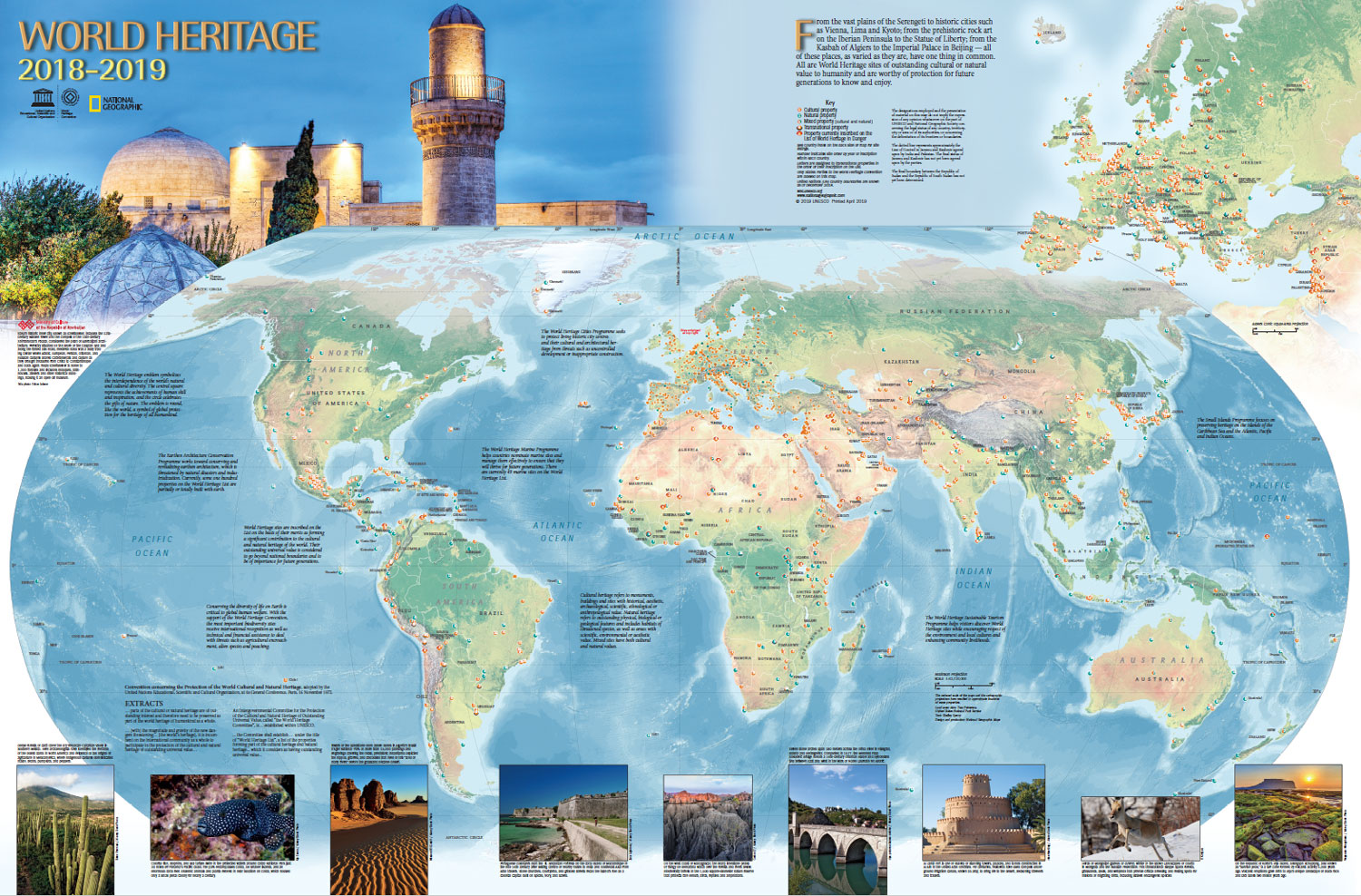
The Climats, terroirs of Burgundy, Champagne Hillsides, Houses and Cellars, the Jurisdiction of Saint-Emilion and the Bordeaux, Port of the Moon region of Aquitaine are UNESCO World Heritage Sites and also the most famous French wine-producing regions.

A champagne vineyard in Villenauxe-la-Grande, near Epernay
Champagne Hillsides, Houses and Cellars are UNESCO Sites just an hour away from of Paris. Located in north-eastern France, the unique chalk cellars and the “historic vineyards of Hautvillers, Aÿ and Mareuil-sur-Aÿ, Saind-Nicaise Hill in Reims, and the Avenue de Champagne and Fort Chabrol in Epernay all represent the Champagne agro-industrial landscape.” There are three UNESCO components: the supply basin formed by the historic hillsides, the production sites with their underground cellars, and the Champagne Houses, which are sales and distribution centers.
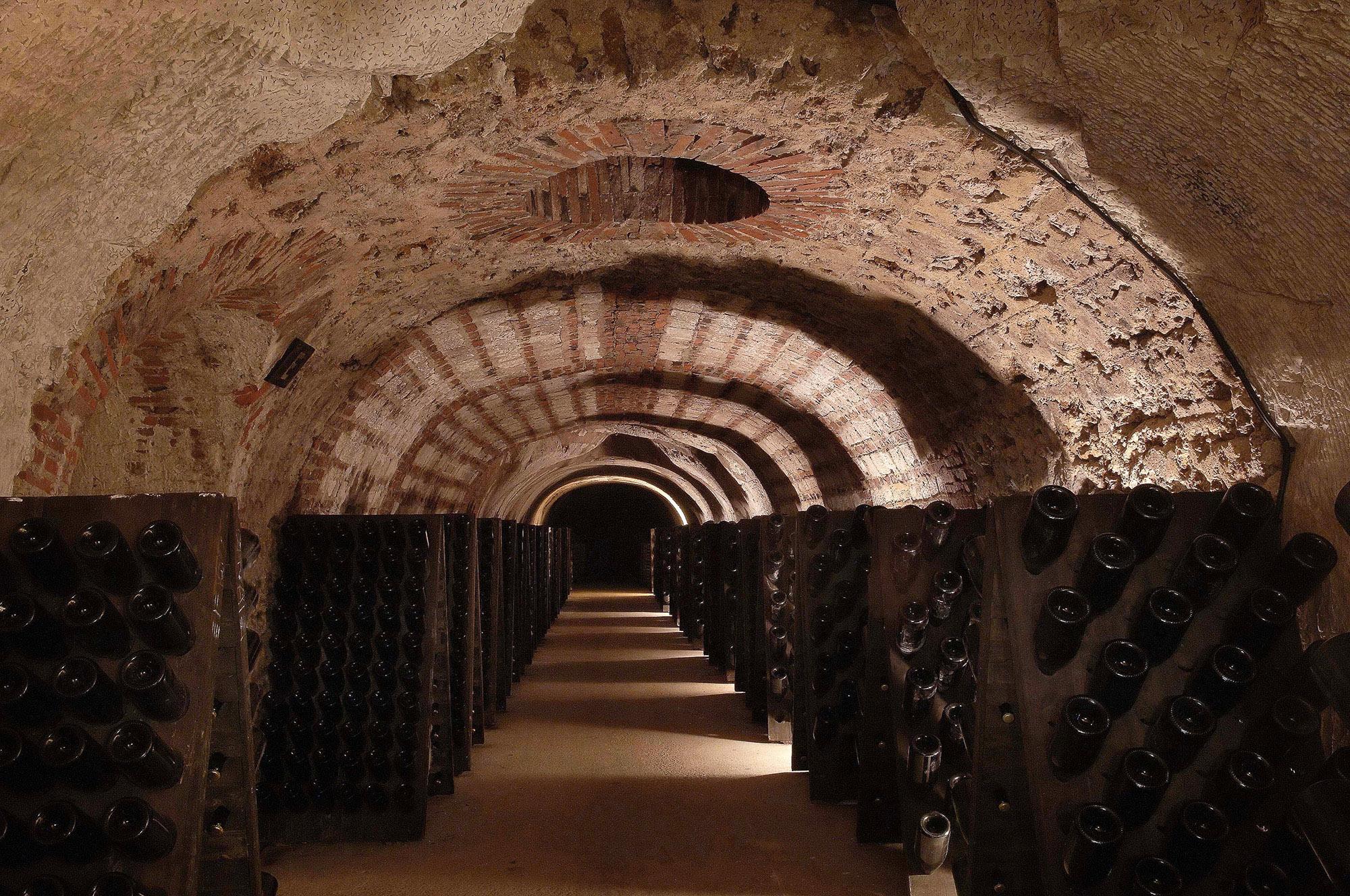
Combining a wine tourism trip with a UNESCO World Heritage trip is usually my favorite way to travel in Europe. The Cathedral of Notre-Dame, Former Abbey of Saint-Rémi and Palace of Tau, Reims are all UNESCO sites in the Champagne Region of France.
Paris, Banks of the Seine is also a UNESCO World Heritage Site. Near Paris, there are many UNESCO World Heritage Sites to visit including:
Palace and Park of Fontainebleau
Provins, Town of Medieval Fairs
The vineyards of Bordeaux are the only vineyards with immediate access to the sea; a competitive advantage that enabled them to be France’s major wine exporting region for many centuries. The best estates in these areas have the right to sell wines designated as grand cru. At the Exposition Universelle of 1855 in Paris, Emperor Napoleon III asked each wine region to establish a classification. The 1855 Classification has been a factor in the continued success of the Châteaux at the top of the classification — namely the first and second growth Châteaux.

Châteaux of Bordeaux
Grand Cru Classé is tied to a specific chateau or estate, rather than a contiguous vineyard. Created in 1855, it comprises only left bank chateaus in Médoc, Graves and Sauternes, ranked from first to fifth growths, based on their value at that time.
 The first growths are called premier crus, while second through fifth growth crus are called crus classés.
The first growths are called premier crus, while second through fifth growth crus are called crus classés.
The five first-growth owners: Prince Robert de Luxembourg of Haut-Brion, Florence Rogers-Pinault of Latour, Baroness Philippine de Rothschild of Mouton-Rothschild, Corinne Mentzelopoulos of Margaux and Baron Eric de Rothschild of Lafite Rothschild.
“Bordeaux is defined by its historic wine-producing châteaux, which were classified in 1855 into five quality levels, or “growths,” that still influence the Bordeaux market today. The five first-growth estates (also called premier crus) command the highest prices, with their wine often sold as futures before the vintage is even released. All 61 classified châteaux are in the Médoc region on the left bank of the Gironde River. The right bank appellations of Pomerol and Saint-Émilion, although not included in the 1855 classification, are home to a handful of equally famed producers.”
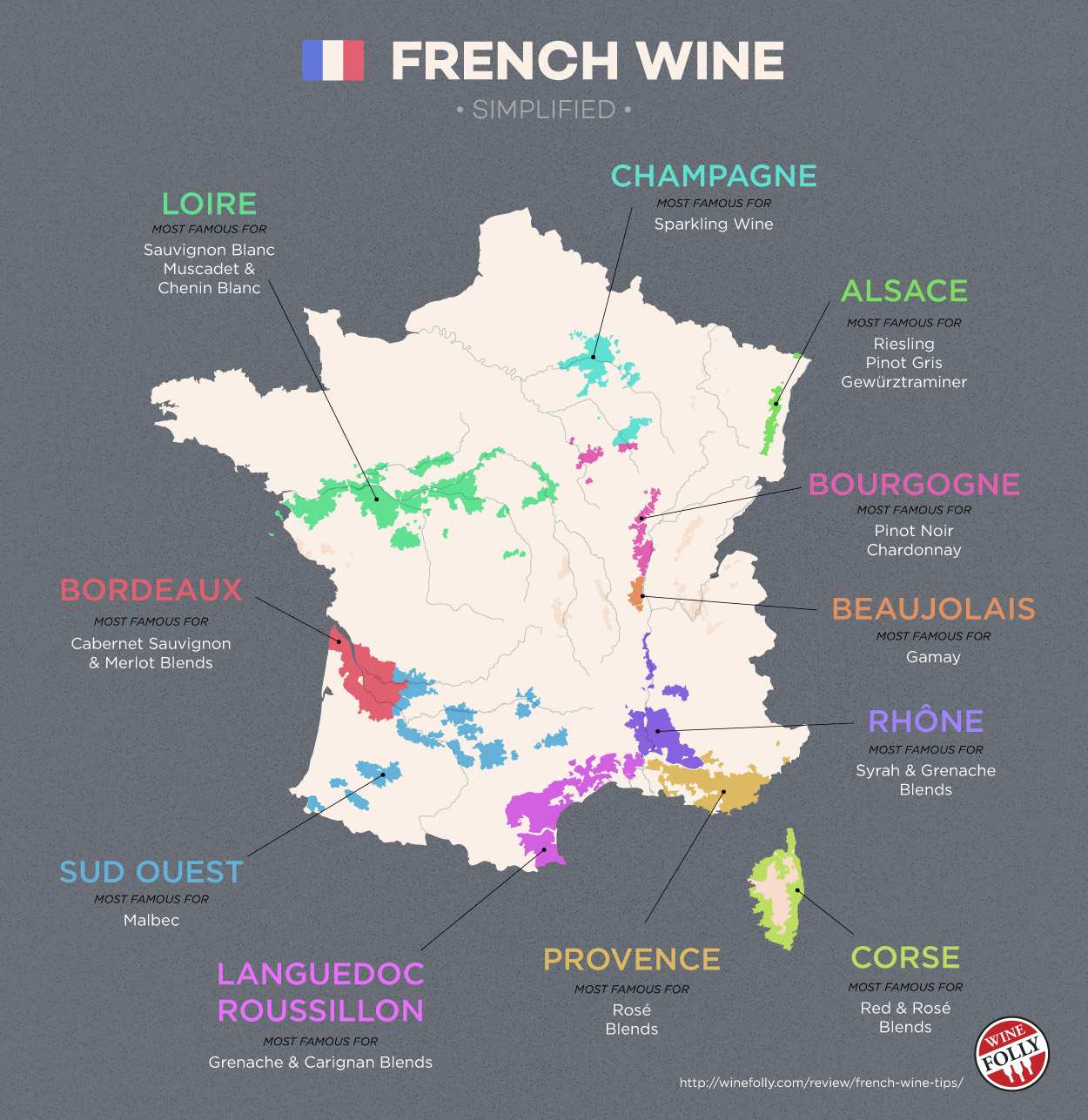 Viticulture and Wine Tourism promote the regions of the world that are a treasure trove of beautiful landscapes, generally accompanied by local delicacies. The best wine regions have exceptional culinary artistry and sumptuous Michelin-starred gourmet chefs. I love to explore the terroir of the appellations, discover the vineyards, meet the talented winemakers, tour the production facilities and cellars and taste the unique character of the wines; “The Elixir of the gods.”.
Viticulture and Wine Tourism promote the regions of the world that are a treasure trove of beautiful landscapes, generally accompanied by local delicacies. The best wine regions have exceptional culinary artistry and sumptuous Michelin-starred gourmet chefs. I love to explore the terroir of the appellations, discover the vineyards, meet the talented winemakers, tour the production facilities and cellars and taste the unique character of the wines; “The Elixir of the gods.”.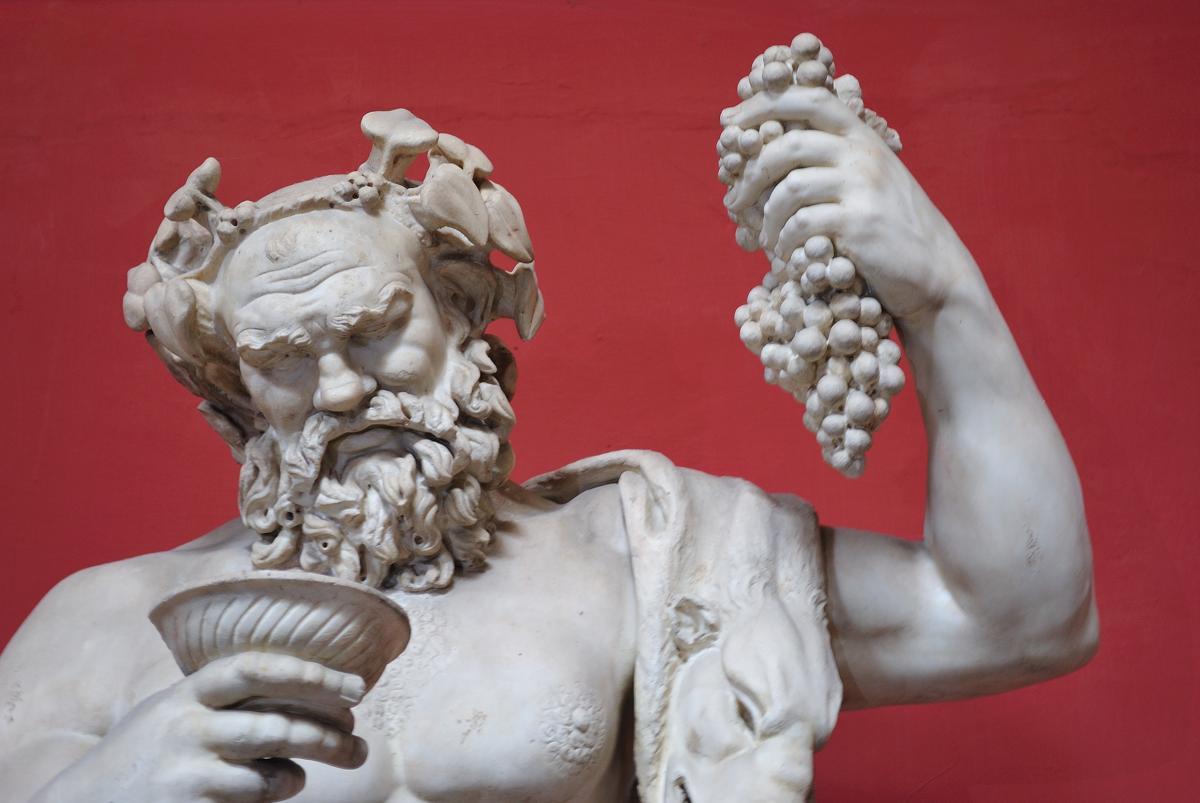
The Great Wine Capitals is a network of ten major global cities in both the northern and southern hemispheres, which share a key economic and cultural asset: their internationally renowned wine regions. These prestigious wine regions include: Adelaide | South Australia, Bilbao | Rioja, Bordeaux, Lausanne |Switzerland, Mainz | Rheinhessen, Mendoza, Porto, San Francisco | Napa Valley, Valparaìso | Casablanca Valley and Verona. The Best Of Wine Tourism awards celebrate innovation and excellence in wine tourism throughout the ten greatest wine regions in the world. Bordeaux has won numerous awards!
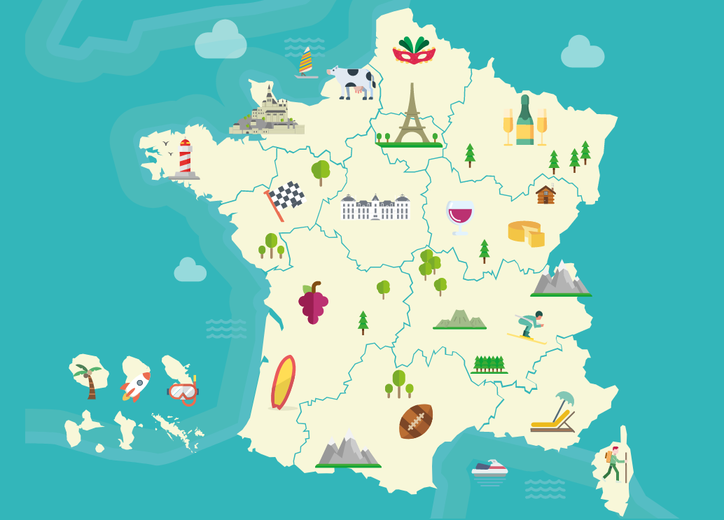
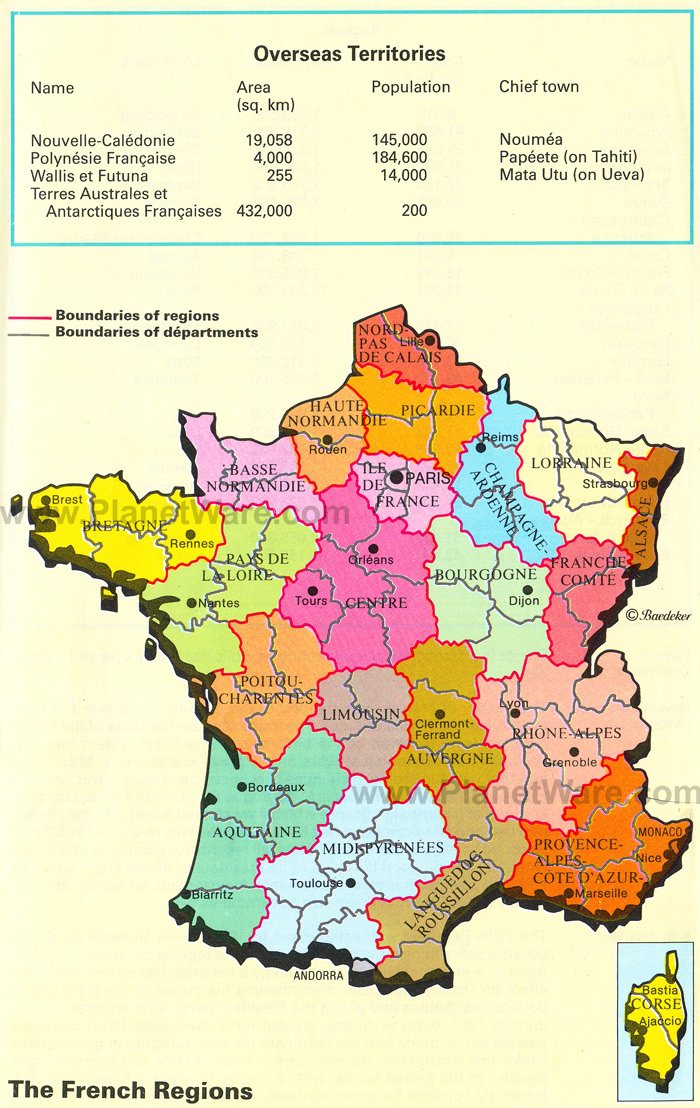
I truly believe that the easiest way to learn about wine, is to visit the region and immerse yourself in the culture while you experiment with the local food and wine on your trip. When visiting California, Oregon, Washington, Italy, Spain or France, the same rules always apply; explore the local food and wine. That’s why my blog is called “Adventures of the Globe-Trotting Wino.” I have posted many of my adventures on Instagram with short videos for you to enjoy.


There are nine primary wine-producing regions in France:
Bordeaux is the world’s premier wine capital; the largest region in terms of quality wine production, where many of the world’s most expensive wines are made. Most of the top quality clarets grown in the overall area benefit from specific and distinctive appellations: Médoc , Graves or Saint Emilion, Pauillac, Graves and Saint-Estèphe.
The Médoc, an area south of the Gironde estuary to the north west of Bordeaux, is the home of many of the most prestigious French wines: Saint Estèphe, Margaux, Saint Julien and Pauillac. “It was in 1855 that the wine producers of the Medoc region classified their 61 best wines according to a league table of “grands crus”; ranking them from “Premier Cru” to “Cinquième Cru”. These grands crus are generally reputed to be the greatest of all French wines, and naturally their prices generally reflect this status.”
It was voted Europe’s Best Destination in 2015 and is listed in the top 10 favorite places to live in France. This UNESCO World Heritage site allows you to visit wine cellars with avant-garde architecture designed by world renowned architects.
In 1152, when queen Eleanor of Aquitaine married the English King Henry II, the Aquitaine region became economically integrated into the Anglo-Norman world. The Bordeaux region became the main supplier of wine for England.
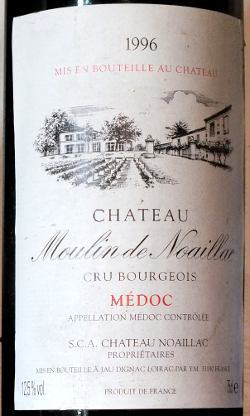
The wine regions of Bordeaux encompass a large number of wine growing areas of the Gironde department of Aquitaine.The Bordeaux region of France produces some of the world’s most famous wines including: St. Emilion, Margaux and Pauillac.
UNESCO/France Aquitaine World Heritage Sites
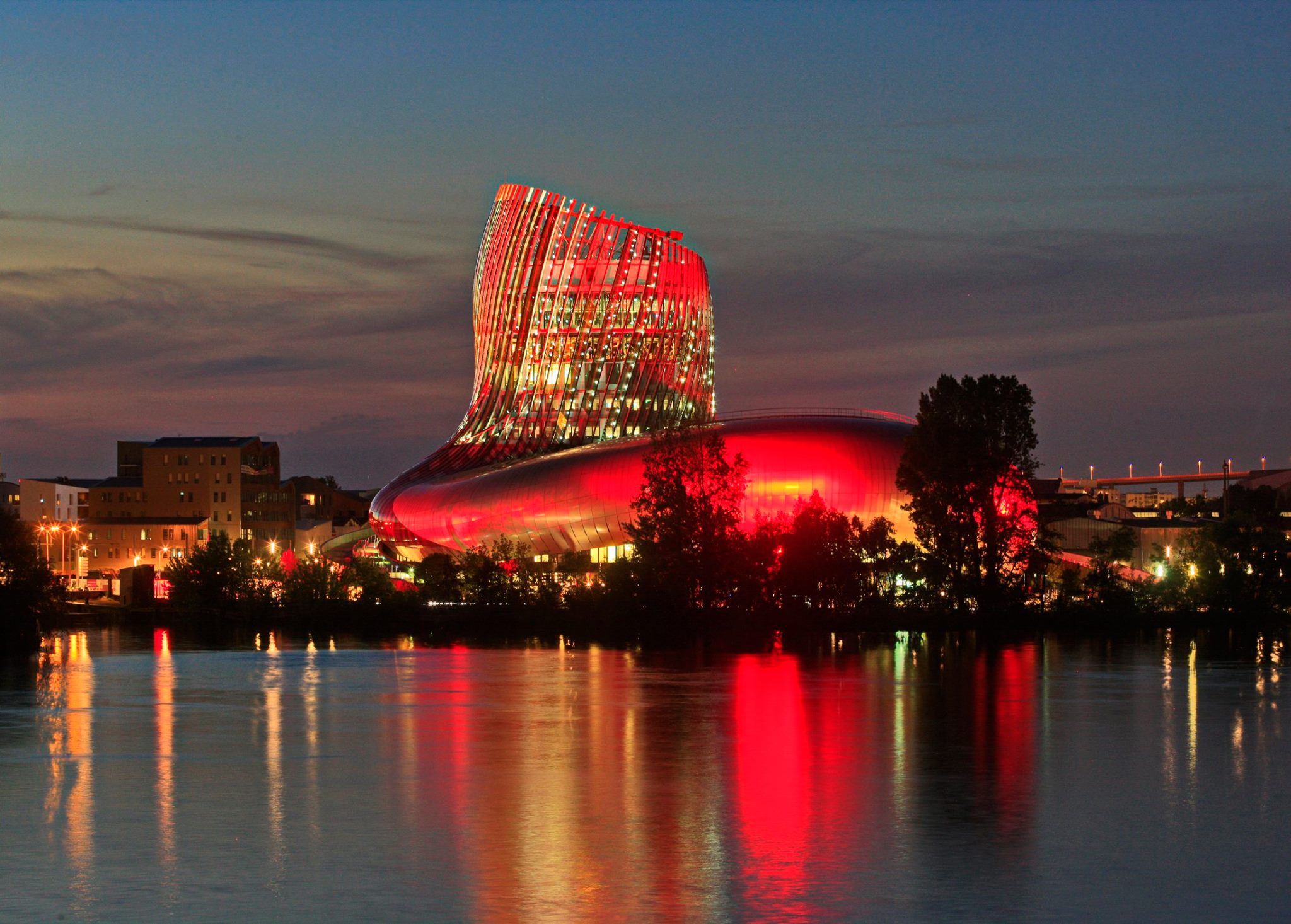
https://www.winetourinfrance.com/en/blog/wine-tours/la-cite-du-vin-in-bordeaux.html
In June of 2016, La Cité du Vin (pictured above) “opened the doors to a world of wine, culture and recreation where wine comes to life through an immersive, sensory approach. The imaginative and enchanting design of the museum is an architectural marvel with sweeping curves and an ethereal tower. La Cité du Vin spans the globe to present the most comprehensive view of wine, cultures and civilizations through temporary and permanent exhibitions. With boutiques, restaurants, a reading room, and on site wine bars, it’s truly a must-see experience during any stay in Bordeaux.”

The Burgundy Wine Region
UNESCO France/BURGUNDY World Heritage Sites

The Burgundy (Bourgogne) region also makes some of the most desirable wines if you love Pinot Noir. The grand cru vineyards are clustered in the north of the region, along the Côte d’Or.
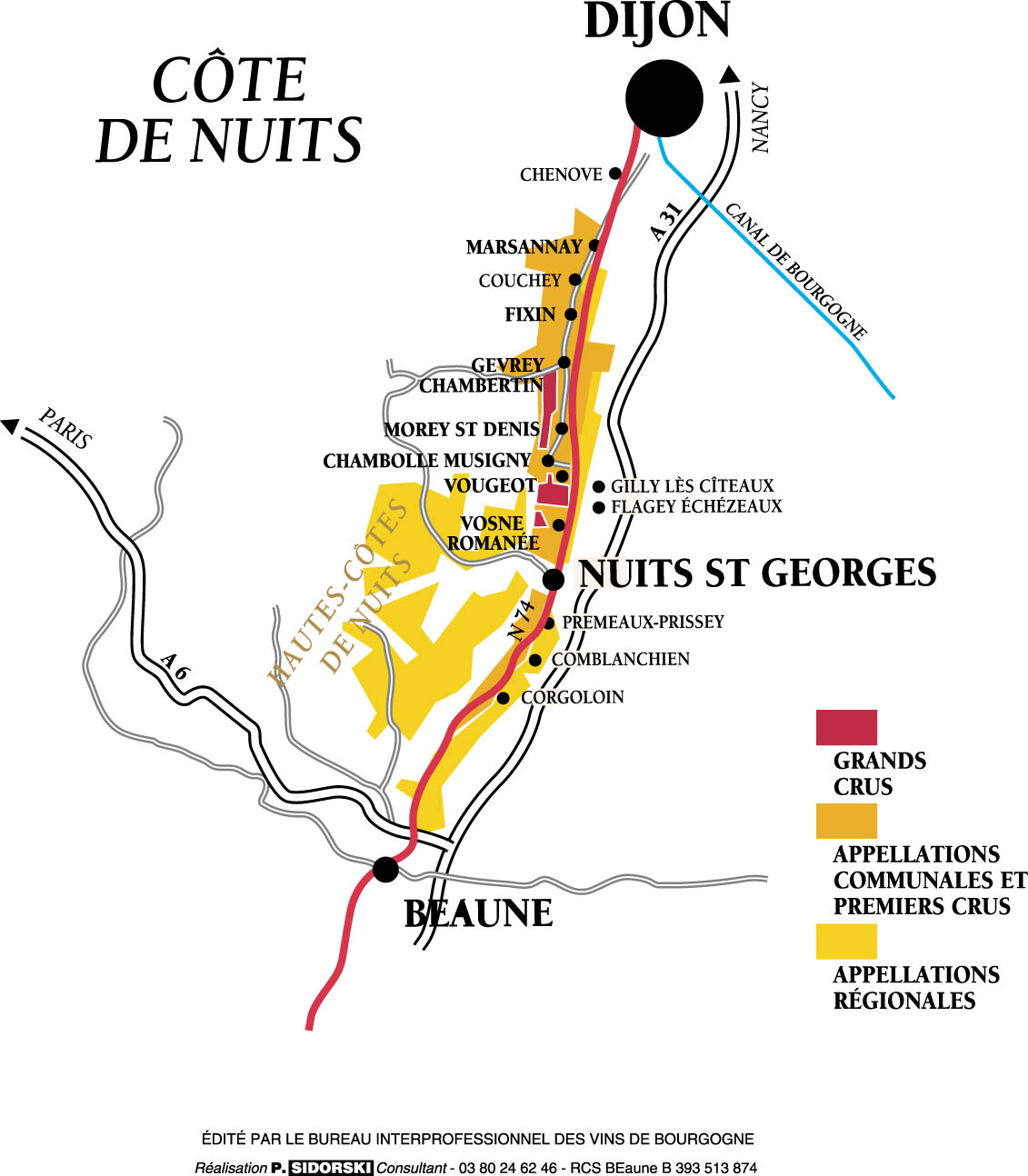
The upper part of the “gold coast” is called the Côte de Nuits, where the region’s best Pinot Noir vineyards are planted.

Burgundian Pinot Noir is earthy and elegant, with soft tannins and spicy cherry fruit flavors.
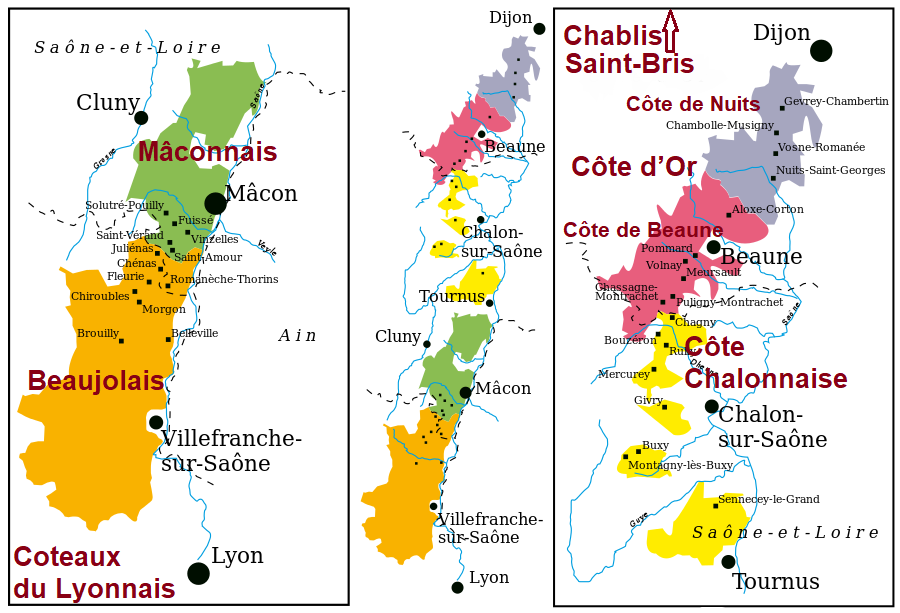
Beaujolais, the region known for Beaujolais Nouveau and the Beaujolais Crus, is technically part of Burgundy. This region grows the Gamay grape.
Dijon is the historical capital of Burgundy and Beaune is the wine capital of the region. The primary wine auction in France takes place in the town of Beaune in the ancient “hospices”. Les Hospices de Beaune – the medieval hospice at Beaune, one of the most unusual ancient monuments in France, a medieval hospital that remained in use until the 20th century.
Rue de l’Hôtel Dieu, Beaune, Burgundy, 21200
Review and book your attractions in Burgundy thru this link:
https://www.beaune-tourism.com/things-to-do/attractions#!/musee-de-lhotel-dieu-de-beaune-674517

A hospital building of the Middle Ages, the Hospices de Beaune are part of French history. Classified as a historic monument since 1862, this exceptional monument is now a museum of history and of medicine. While you are visiting Burgundy, the Hospices of Beaune should be key destination. Also known as Hôtel-Dieu de Beaune to locals, the Hospices de Beaune used to be an almshouse in the 15th century and was used as a hospital for the poor people of the region recovering from the Hundred Years’ War. It was actually used as a fully functioning hospital until the late 1970s; it now houses a museum and a major charity wine auction every November. The Hospices, a hospital created in the 15th century for the poor, is also the owner of a prestigious wine estate whose wines are sold at a major auction in November.
The building itself is now regarded as one of the finest architectural gems in France; it was designed by the Flemish architect Jacques Wiscrère, which explains the striking resemblances to architecture typically found in the Flanders region of Belgium. The hospices’ façade is an exceptional example of Northern Renaissance architecture and features an abundance of panel painting, long half-timber galleries and, of course, the signature gabled roof and its multi-colored and geometric tiles. There are also plenty of iron works, carvings, and tapestries inside the hospices’ walls.
Today the hospice is a museum and art gallery, and contains one of the most famous works of medieval Flemish art, the alter piece by Roger van der Weyden, painted for the hospice, and still in situ.

The Beaune Altarpiece (or The Last Judgement) 1445–1450, artist Rogier van der Weyden. The altarpiece was commissioned in 1443 for the Hospices de Beaune in eastern France, by Nicolas Rolin, Chancellor of the Duchy of Burgundy, and his wife Guigone de Salins, who is buried in front of the altarpiece’s original location.
Burgundian architecture is famous throughout the world. In 1457, a first gift of vines was made to the Hospices de Beaune. Since then, the hospices have received numerous other gifts. Today, the vineyard is made up of 60 hectares, of which 90% is dedicated to the production of Pinot Noir, while the rest produces Chardonnay. Eighty-five percent of the production of this vineyard is premier crus and grand crus.
Each year, an auction is organized in the same buildings as the hospices. Individuals can then acquire one or more bottles of this fabulous concoction. The funds received finance the operation of the hospices, the preservation of the building of the Hôtel Dieu, improvements to the hospital buildings of Beaune, as well as financing medical research and charity work. The values of the founder of these hospices are part of this process: to come to the aid of the most destitute.
The prices of the wines presented during the sale, among the premier crus and the grand crus can become staggering. Even ordinary visitors can buy the wines from among the premier crus and grand crus from the domain “Hospice de Beaune”. The hospices have a small store where these bottle are sold.
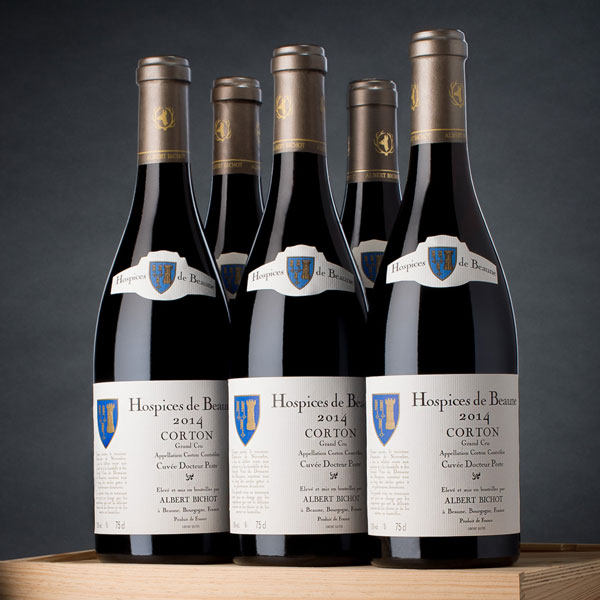
If you want to buy wine, you can buy them remotely and have them delivered within three days, anywhere in France.

At dusk, light images are projected onto the facades of seven of Beaune’s iconic sites, bringing out their history and symbolism (Collegiate Church of Our Lady, Hôtel Dieu, Wine Museum, St-Etienne Chapel, Belfry, Porte Marie de Bourgogne and Rempart des Dames). https://www.beaune-tourism.com/things-to-do/leisure-activities/lumieres-a-beaune-visite-guidee-privee-1430407#lg=1&slide=3


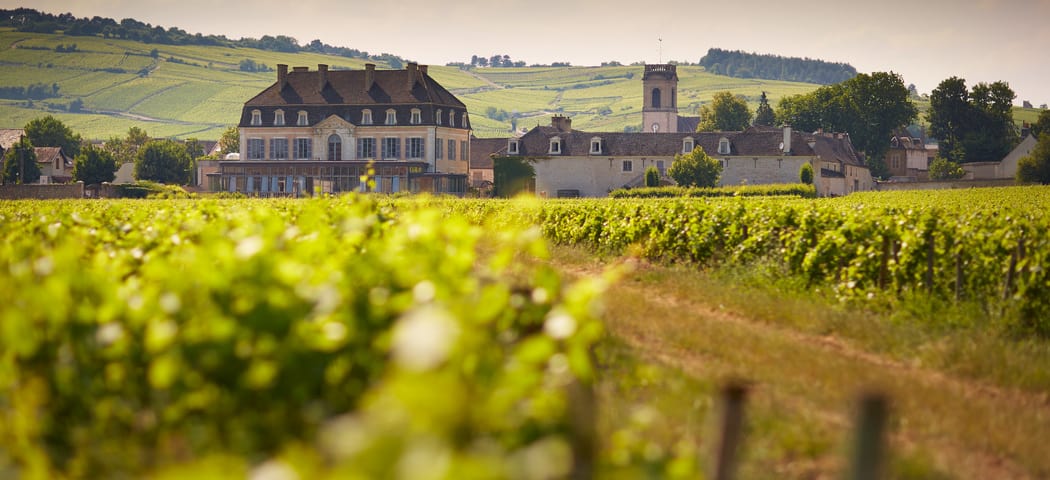
https://www.beaune-tourism.com/things-to-do/attractions#!/musee-de-lhotel-dieu-de-beaune-674517
Visit the Abbey of Fontenay was founded by Saint Bernard in 1118. It is one of the oldest Cistercian abbeys in Europe. The Romanesque architecture offers a remarkable unity to all buildings remained intact since the Middle Ages. The Abbey was transformed into a paper mill after the French Revolution by the family Montgolfier and was bought back in 1906 by Edouard Aynard, the ancestor of the present owners who continue on safeguarding this masterpiece of Romanesque art. The old Abbey of Fontenay (12th century) was one of the first monuments to be inscribed on the Unesco world heritage list. This classification has distinguished the exceptional value of Fontenay and its environment.

The goal of the Cistercians was to adhere strictly to the 6th century Rule of Saint Benedict. This Rule pronounced that a monk should divide his day equally between prayer, study and manual labor, as well as live a life of poverty, chastity and obedience. Most Cistercian abbeys were built to reflect this dedication to the Rule of Saint Benedict, with manual labor being an integral component. Fontenay, a fairly early addition to the order, and built directly under Bernard of Clairvaux, is no exception. Fontenay was the second “daughter house” of Clairvaux, and one of the four founding houses of the order. Saint Bernard held strong beliefs as to how abbeys should be built and, as Fontenay was built under his auspices, it conforms to Saint Bernard’s dictates to a nicety.
Like so many abbeys, Fontenay was seized during the French revolution, at which point it ceased to function as a religious center. The property was auctioned off and it became a paper mill in 1791. Later it was be adapted for other industrial purposes until purchased by Edouard Anyard, who restored its structures to their original purity. It remains in the Anyard family to this day, and is open to the public for all to see. It stands as a sober, yet stunning, reminder of the reductive beauty of Cistercian architecture.
Another place that I love in Burgundy is Abbaye de Vézelay (UNESCO World Heritage Site), is also called The Abbaye Sainte-Marie-Madeleine de Vézelay. It is one of the main starting points of one of the main pilgrimage routes to Santiago de Compostella.

Mary Magdalene’s relics
The site has been an important place of pilgrimage since relics of St. Mary Magdalene were brought here in the 10th century.
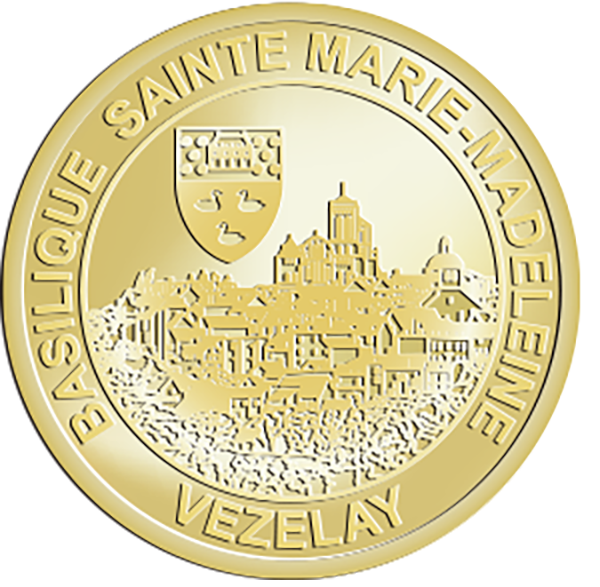
Mary Magdalene is the prototype of the penitent, and Vézelay has remained an important place of pilgrimage for the Catholic faithful, though the actual claimed relics were torched by Huguenots in the 16th century.
The central portal
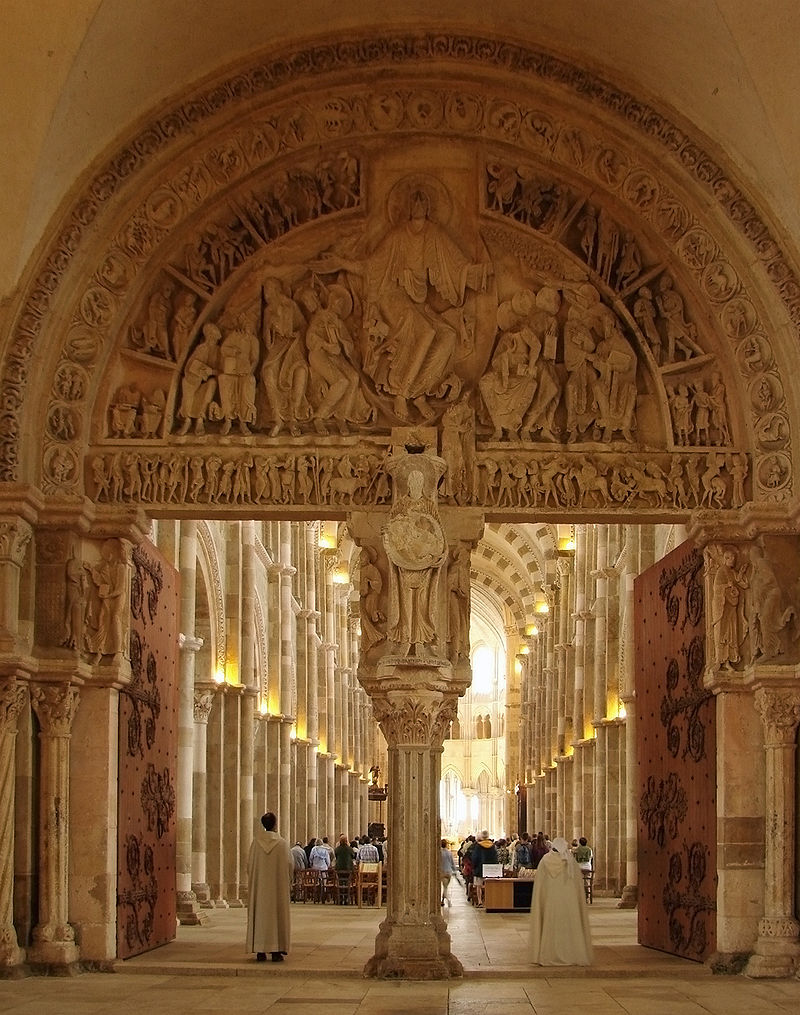
Vezeley is one of the great masterpieces of Burgundian Romanesque art and architecture

Sacked by the Huguenots in 1569, the building suffered neglect in the 17th and the 18th centuries. The church and hill at Vézelay were added to the UNESCO list of World Heritage Sites in 1979.
“Shortly after its foundation in the 9th century, the Benedictine abbey of Vézelay acquired the relics of St Mary Magdalene and since then it has been an important place of pilgrimage. St Bernard preached the Second Crusade there in 1146 and Richard the Lion-Hearted and Philip II Augustus met there to leave for the Third Crusade in 1190. With its sculpted capitals and portal, the Madeleine of Vézelay – a 12th-century monastic church – is a masterpiece of Burgundian Romanesque art and architecture.”
I love traveling around the world exploring wine regions and enjoying the vineyard Vino con Vista. I have visited most of the wine regions of France. Even though there are 18 regions in France, there are only 9 wine regions; unlike Italy with 20 regions cloaked with vineyards. The Major Wine Regions in Vino con Vista France are Packed with UNESCO World Heritage Sites. France is home to 45 UNESCO World Heritage Sites: 39 cultural sites, 5 natural sites and 1 mixed site. France shares 4 of those sites with other countries; these are considered cross-border sites. My trips to Europe are generally dictated by the local UNESCO sites. My goal has been to visit all the sites in France, Italy, Spain and Portugal. Prior to COVID, I almost achieved this goal. I only have a few places left on this bucket list!

The Climats, terroirs of Burgundy, Champagne Hillsides, Houses and Cellars, the Jurisdiction of Saint-Emilion and the Bordeaux, Port of the Moon region of Aquitaine are UNESCO World Heritage Sites and also the most famous French wine-producing regions.

A champagne vineyard in Villenauxe-la-Grande, near Epernay
Champagne Hillsides, Houses and Cellars are UNESCO Sites just an hour away from of Paris. Located in north-eastern France, the unique chalk cellars and the “historic vineyards of Hautvillers, Aÿ and Mareuil-sur-Aÿ, Saind-Nicaise Hill in Reims, and the Avenue de Champagne and Fort Chabrol in Epernay all represent the Champagne agro-industrial landscape.” There are three UNESCO components: the supply basin formed by the historic hillsides, the production sites with their underground cellars, and the Champagne Houses, which are sales and distribution centers.

Combining a wine tourism trip with a UNESCO World Heritage trip is usually my favorite way to travel in Europe. The Cathedral of Notre-Dame, Former Abbey of Saint-Rémi and Palace of Tau, Reims are all UNESCO sites in the Champagne Region of France.
Paris, Banks of the Seine is also a UNESCO World Heritage Site. Near Paris, there are many UNESCO World Heritage Sites to visit including:
Palace and Park of Fontainebleau
Provins, Town of Medieval Fairs
The vineyards of Bordeaux are the only vineyards with immediate access to the sea; a competitive advantage that enabled them to be France’s major wine exporting region for many centuries. The best estates in these areas have the right to sell wines designated as grand cru. At the Exposition Universelle of 1855 in Paris, Emperor Napoleon III asked each wine region to establish a classification. The 1855 Classification has been a factor in the continued success of the Châteaux at the top of the classification — namely the first and second growth Châteaux.

Châteaux of Bordeaux
Grand Cru Classé is tied to a specific chateau or estate, rather than a contiguous vineyard. Created in 1855, it comprises only left bank chateaus in Médoc, Graves and Sauternes, ranked from first to fifth growths, based on their value at that time.
 The first growths are called premier crus, while second through fifth growth crus are called crus classés.
The first growths are called premier crus, while second through fifth growth crus are called crus classés.

The five first-growth owners: Prince Robert de Luxembourg of Haut-Brion, Florence Rogers-Pinault of Latour, Baroness Philippine de Rothschild of Mouton-Rothschild, Corinne Mentzelopoulos of Margaux and Baron Eric de Rothschild of Lafite Rothschild.
“Bordeaux is defined by its historic wine-producing châteaux, which were classified in 1855 into five quality levels, or “growths,” that still influence the Bordeaux market today. The five first-growth estates (also called premier crus) command the highest prices, with their wine often sold as futures before the vintage is even released. All 61 classified châteaux are in the Médoc region on the left bank of the Gironde River. The right bank appellations of Pomerol and Saint-Émilion, although not included in the 1855 classification, are home to a handful of equally famed producers.”
 Viticulture and Wine Tourism promote the regions of the world that are a treasure trove of beautiful landscapes, generally accompanied by local delicacies. The best wine regions have exceptional culinary artistry and sumptuous Michelin-starred gourmet chefs. I love to explore the terroir of the appellations, discover the vineyards, meet the talented winemakers, tour the production facilities and cellars and taste the unique character of the wines; “The Elixir of the gods.”.
Viticulture and Wine Tourism promote the regions of the world that are a treasure trove of beautiful landscapes, generally accompanied by local delicacies. The best wine regions have exceptional culinary artistry and sumptuous Michelin-starred gourmet chefs. I love to explore the terroir of the appellations, discover the vineyards, meet the talented winemakers, tour the production facilities and cellars and taste the unique character of the wines; “The Elixir of the gods.”.
The Great Wine Capitals is a network of ten major global cities in both the northern and southern hemispheres, which share a key economic and cultural asset: their internationally renowned wine regions. These prestigious wine regions include: Adelaide | South Australia, Bilbao | Rioja, Bordeaux, Lausanne |Switzerland, Mainz | Rheinhessen, Mendoza, Porto, San Francisco | Napa Valley, Valparaìso | Casablanca Valley and Verona. The Best Of Wine Tourism awards celebrate innovation and excellence in wine tourism throughout the ten greatest wine regions in the world. Bordeaux has won numerous awards!


I truly believe that the easiest way to learn about wine, is to visit the region and immerse yourself in the culture while you experiment with the local food and wine on your trip. When visiting California, Oregon, Washington, Italy, Spain or France, the same rules always apply; explore the local food and wine. That’s why my blog is called “Adventures of the Globe-Trotting Wino.” I have posted many of my adventures on Instagram with short videos for you to enjoy.


There are nine primary wine-producing regions in France:
Bordeaux is the world’s premier wine capital; the largest region in terms of quality wine production, where many of the world’s most expensive wines are made. Most of the top quality clarets grown in the overall area benefit from specific and distinctive appellations: Médoc , Graves or Saint Emilion, Pauillac, Graves and Saint-Estèphe.
The Médoc, an area south of the Gironde estuary to the north west of Bordeaux, is the home of many of the most prestigious French wines: Saint Estèphe, Margaux, Saint Julien and Pauillac. “It was in 1855 that the wine producers of the Medoc region classified their 61 best wines according to a league table of “grands crus”; ranking them from “Premier Cru” to “Cinquième Cru”. These grands crus are generally reputed to be the greatest of all French wines, and naturally their prices generally reflect this status.”
It was voted Europe’s Best Destination in 2015 and is listed in the top 10 favorite places to live in France. This UNESCO World Heritage site allows you to visit wine cellars with avant-garde architecture designed by world renowned architects.
In 1152, when queen Eleanor of Aquitaine married the English King Henry II, the Aquitaine region became economically integrated into the Anglo-Norman world. The Bordeaux region became the main supplier of wine for England.

The wine regions of Bordeaux encompass a large number of wine growing areas of the Gironde department of Aquitaine.The Bordeaux region of France produces some of the world’s most famous wines including: St. Emilion, Margaux and Pauillac.
UNESCO/France Aquitaine World Heritage Sites

https://www.winetourinfrance.com/en/blog/wine-tours/la-cite-du-vin-in-bordeaux.html
In June of 2016, La Cité du Vin (pictured above) “opened the doors to a world of wine, culture and recreation where wine comes to life through an immersive, sensory approach. The imaginative and enchanting design of the museum is an architectural marvel with sweeping curves and an ethereal tower. La Cité du Vin spans the globe to present the most comprehensive view of wine, cultures and civilizations through temporary and permanent exhibitions. With boutiques, restaurants, a reading room, and on site wine bars, it’s truly a must-see experience during any stay in Bordeaux.”

The Burgundy Wine Region
UNESCO France/BURGUNDY World Heritage Sites

The Burgundy (Bourgogne) region also makes some of the most desirable wines if you love Pinot Noir. The grand cru vineyards are clustered in the north of the region, along the Côte d’Or.

The upper part of the “gold coast” is called the Côte de Nuits, where the region’s best Pinot Noir vineyards are planted.

Burgundian Pinot Noir is earthy and elegant, with soft tannins and spicy cherry fruit flavors.

Beaujolais, the region known for Beaujolais Nouveau and the Beaujolais Crus, is technically part of Burgundy. This region grows the Gamay grape.
Dijon is the historical capital of Burgundy and Beaune is the wine capital of the region. The primary wine auction in France takes place in the town of Beaune in the ancient “hospices”. Les Hospices de Beaune – the medieval hospice at Beaune, one of the most unusual ancient monuments in France, a medieval hospital that remained in use until the 20th century.
Rue de l’Hôtel Dieu, Beaune, Burgundy, 21200
Review and book your attractions in Burgundy thru this link:
https://www.beaune-tourism.com/things-to-do/attractions#!/musee-de-lhotel-dieu-de-beaune-674517

A hospital building of the Middle Ages, the Hospices de Beaune are part of French history. Classified as a historic monument since 1862, this exceptional monument is now a museum of history and of medicine. While you are visiting Burgundy, the Hospices of Beaune should be key destination. Also known as Hôtel-Dieu de Beaune to locals, the Hospices de Beaune used to be an almshouse in the 15th century and was used as a hospital for the poor people of the region recovering from the Hundred Years’ War. It was actually used as a fully functioning hospital until the late 1970s; it now houses a museum and a major charity wine auction every November. The Hospices, a hospital created in the 15th century for the poor, is also the owner of a prestigious wine estate whose wines are sold at a major auction in November.
The building itself is now regarded as one of the finest architectural gems in France; it was designed by the Flemish architect Jacques Wiscrère, which explains the striking resemblances to architecture typically found in the Flanders region of Belgium. The hospices’ façade is an exceptional example of Northern Renaissance architecture and features an abundance of panel painting, long half-timber galleries and, of course, the signature gabled roof and its multi-colored and geometric tiles. There are also plenty of ironworks, carvings, and tapestries inside the hospices’ walls.
Today the hospice is a museum and art gallery, and contains one of the most famous works of medieval Flemish art, the alterpiece by Roger van der Weyden, painted for the hospice, and still in situ.

The Beaune Altarpiece (or The Last Judgement) 1445–1450, artist Rogier van der Weyden. The altarpiece was commissioned in 1443 for the Hospices de Beaune in eastern France, by Nicolas Rolin, Chancellor of the Duchy of Burgundy, and his wife Guigone de Salins, who is buried in front of the altarpiece’s original location.
Burgundian architecture is famous throughout the world. In 1457, a first gift of vines was made to the Hospices de Beaune. Since then, the hospices have received numerous other gifts. Today, the vineyard is made up of 60 hectares, of which 90% is dedicated to the production of Pinot Noir, while the rest produces Chardonnay. Eighty-five percent of the production of this vineyard is premier crus and grand crus.
Each year, an auction is organized in the same buildings as the hospices. Individuals can then acquire one or more bottles of this fabulous concoction. The funds received finance the operation of the hospices, the preservation of the building of the Hôtel Dieu, improvements to the hospital buildings of Beaune, as well as financing medical research and charity work. The values of the founder of these hospices are part of this process: to come to the aid of the most destitute.
The prices of the wines presented during the sale, among the premier crus and the grand crus can become staggering. Even ordinary visitors can buy the wines from among the premier crus and grand crus from the domain “Hospice de Beaune”. The hospices have a small store where these bottle are sold.

If you want to buy wine, you can buy them remotely and have them delivered within three days, anywhere in France.

At dusk, light images are projected onto the facades of seven of Beaune’s iconic sites, bringing out their history and symbolism (Collegiate Church of Our Lady, Hôtel Dieu, Wine Museum, St-Etienne Chapel, Belfry, Porte Marie de Bourgogne and Rempart des Dames). https://www.beaune-tourism.com/things-to-do/leisure-activities/lumieres-a-beaune-visite-guidee-privee-1430407#lg=1&slide=3



https://www.beaune-tourism.com/things-to-do/attractions#!/musee-de-lhotel-dieu-de-beaune-674517
Visit the Abbey of Fontenay was founded by Saint Bernard in 1118. It is one of the oldest Cistercian abbeys in Europe. The Romanesque architecture offers a remarkable unity to all buildings remained intact since the Middle Ages. The Abbey was transformed into a paper mill after the French Revolution by the family Montgolfier and was bought back in 1906 by Edouard Aynard, the ancestor of the present owners who continue on safeguarding this masterpiece of Romanesque art. The old Abbey of Fontenay (12th century) was one of the first monuments to be inscribed on the Unesco world heritage list. This classification has distinguished the exceptional value of Fontenay and its environment.

The goal of the Cistercians was to adhere strictly to the 6th century Rule of Saint Benedict. This Rule pronounced that a monk should divide his day equally between prayer, study and manual labor, as well as live a life of poverty, chastity and obedience. Most Cistercian abbeys were built to reflect this dedication to the Rule of Saint Benedict, with manual labor being an integral component. Fontenay, a fairly early addition to the order, and built directly under Bernard of Clairvaux, is no exception. Fontenay was the second “daughter house” of Clairvaux, and one of the four founding houses of the order. Saint Bernard held strong beliefs as to how abbeys should be built and, as Fontenay was built under his auspices, it conforms to Saint Bernard’s dictates to a nicety.
Like so many abbeys, Fontenay was seized during the French revolution, at which point it ceased to function as a religious center. The property was auctioned off and it became a paper mill in 1791. Later it was be adapted for other industrial purposes until purchased by Edouard Anyard, who restored its structures to their original purity. It remains in the Anyard family to this day, and is open to the public for all to see. It stands as a sober, yet stunning, reminder of the reductive beauty of Cistercian architecture.
Another place that I love in Burgundy is Abbaye de Vézelay (UNESCO World Heritage Site), is also called The Abbaye Sainte-Marie-Madeleine de Vézelay. It is one of the main starting points of one of the main pilgrimage routes to Santiago de Compostella.

Mary Magdalene’s relics
The site has been an important place of pilgrimage since relics of St. Mary Magdalene were brought here in the 10th century.

Mary Magdalene is the prototype of the penitent, and Vézelay has remained an important place of pilgrimage for the Catholic faithful, though the actual claimed relics were torched by Huguenots in the 16th century.
The central portal

Vezeley is one of the great masterpieces of Burgundian Romanesque art and architecture

Sacked by the Huguenots in 1569, the building suffered neglect in the 17th and the 18th centuries. The church and hill at Vézelay were added to the UNESCO list of World Heritage Sites in 1979. “Shortly after its foundation in the 9th century, the Benedictine abbey of Vézelay acquired the relics of St Mary Magdalene and since then it has been an important place of pilgrimage. St Bernard preached the Second Crusade there in 1146 and Richard the Lion-Hearted and Philip II Augustus met there to leave for the Third Crusade in 1190. With its sculpted capitals and portal, the Madeleine of Vézelay – a 12th-century monastic church – is a masterpiece of Burgundian Romanesque art and architecture.” http://whc.unesco.org/en/list/84
The central portion of the Vézelay tympanum shows a benevolent Christ conveying his message to the Apostles, who flank him on either side. This Christ is distinct in Romanesque architecture. The Vézelay Christ, (shown below) is pictured contraposto with arms wide open as a kind and welcoming gesture.
“The Vézelay Christ is sending the Crusaders out—he is not judging them. Indeed, the Crusaders were guaranteed remission of all sins if they participated in the Crusades. ” https://en.wikipedia.org/wiki/V%C3%A9zelay_Abbey
“In 1146, St Bernard preached the Second Crusade there before King Louis VII, Queen Eleanor and a throng of nobles, prelates and people gathered on the hill. In 1190, Richard the Lion-Hearted and Philip Augustus met there to leave for the Third Crusade. In 1217, Francis of Assisi chose the hill of Vézelay to found the first Franciscan establishment on French soil.” http://whc.unesco.org/en/list/84
Since 1920 it has carried the title basilica.

Detail of the Vézelay tympanum
Visit the Wine Museum in Burgundy.


https://www.beaune-tourism.com/things-to-do/attractions/musee-du-vin-de-bourgogne-675138
The Champagne Region of France in Marne
Champagne Hillsides, Houses and Cellars/UNESCO
Cathedral of Notre-Dame, Former Abbey of Saint-Rémi and Palace of Tau, Reims/UNESCO

Take the Wine Road
The Champagne Region makes sparkling wines that are pricey because of the amount of labor that goes into their production.
“Champagne is produced via méthode traditionelle, also known as méthode champenoise. This process is both rigorous and time consuming; first, the wine must undergo its primary fermentation prior to bottling, then undergo a secondary fermentation in bottle. The second fermentation occurs when the tirage, a mixture of yeast and sugar, is added to the bottle. Post- secondary fermentation, the dead yeasts (known as lees) must be removed via remuage, or riddling, a lengthy process by which the upside down bottles are turned little by little to gradually shake the lees to the bottom of the neck. When the lees have all reached the top of the neck, the bottlenecks are cooled to freeze the collection of lees, the temporary cap is removed, and pressure shoots the frozen block of lees out through a process called disgorgement. The small, leftover space where the frozen lees were is filled with liqueur d’expedition, which will determine the sweetness level of the wine. This process is called dosage. Don’t be mistaken, though; these processes take years to complete. Champagnes must age for at least 15 months on the lees and, for vintage Champagne, 36 months.”

The Sublime effervescence associated with champagne is achieved by turning the bottles on a regular basis. The Champagne bottle is placed upside down in a holder at a 75 degree angle. Each day the riddler (above) comes through the cellar and turns the bottle 1/8th of a turn while keeping it upside down. This procedure forces the dead yeast cells into the neck of the bottle where they are subsequently removed.
Visit REIMS and EPERNAY
Reims is home to some of the major Champagne producers, such as Taittinger. Cellar tours are available where you can travel underground to the tunnels to see how the sparkling Champagne is blended, bottled and aged. You can also visit the smaller town of Epernay, fifteen miles south of Reims. Epernay is home to many of the most famous Champagne producers, including Moët & Chandon or Perrier-Jouët. then travel to Chalons en Champagne.
:max_bytes(150000):strip_icc()/champagne-map-56a3a4243df78cf7727e6587.png)
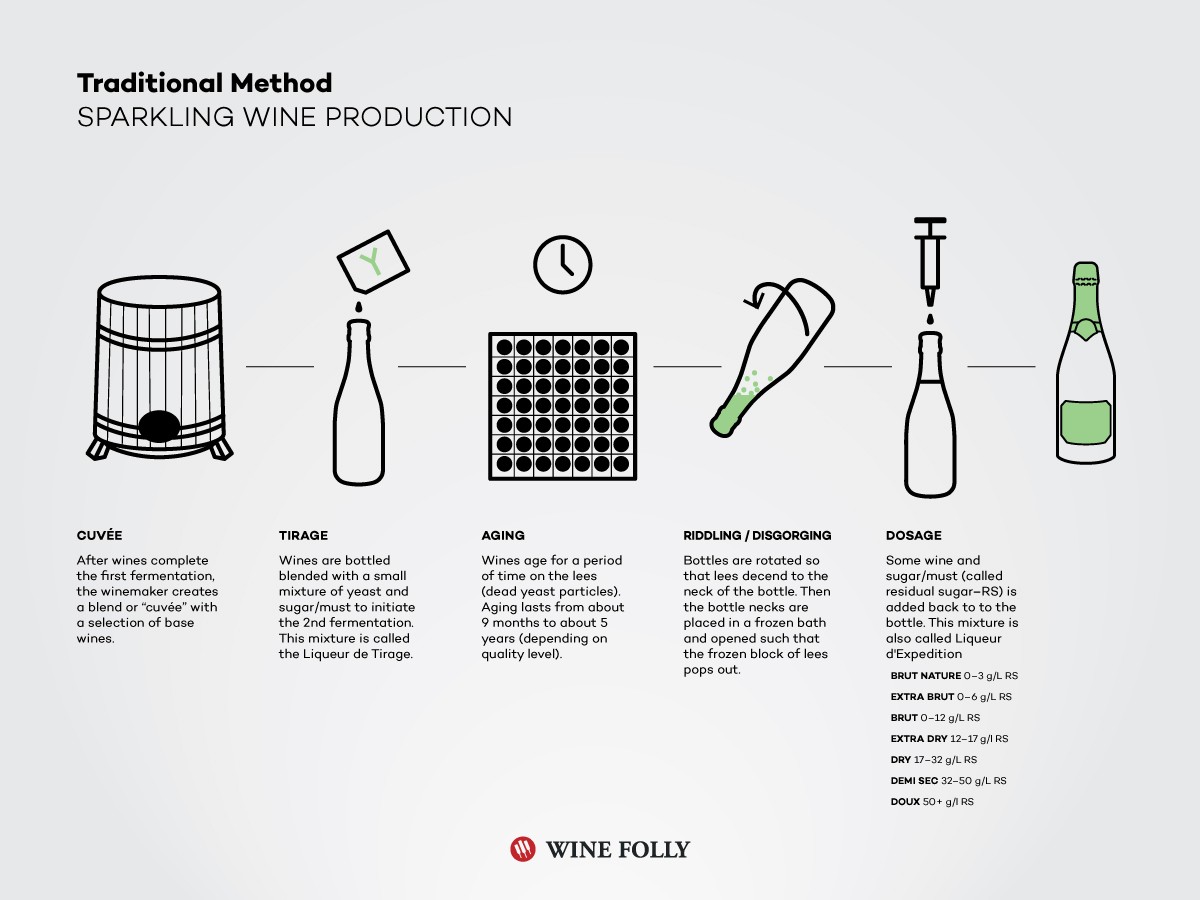
Visit “The crayères at Veuve Cliquot Ponsardin; tunnels carved from the white limestone, known as crayères. n 1909, Veuve Clicquot Ponsardin acquired the underground white limestone quarries, located under Saint-Nicaise Hill on the outskirts of the city center of Reims. Travel along this labyrinth, situated 20 m below the ground, and immerse yourself in the famous brand’s atmospheric underground tunnels and the heritage of the Champagne region. The temperature of the tunnels and their constant humidity, as well as the calm which reigns there, make the tunnels an ideal location for the production of champagne.”
Champagne is not a generic term for sparkling wine from France; there are plenty more good sparkling wines from France that are not sold as champagne. Some other excellent sparkling wines are produced in Burgundy (Crémant de Bourgogne), the Jura (Crémant du Jura) and the Loire valley (Vouvray and others) using the same techniques (formerly called “méthode champenoise”).
On my friends’ birthdays, I always five them a bottle of Veuve. They are always very appreciative!
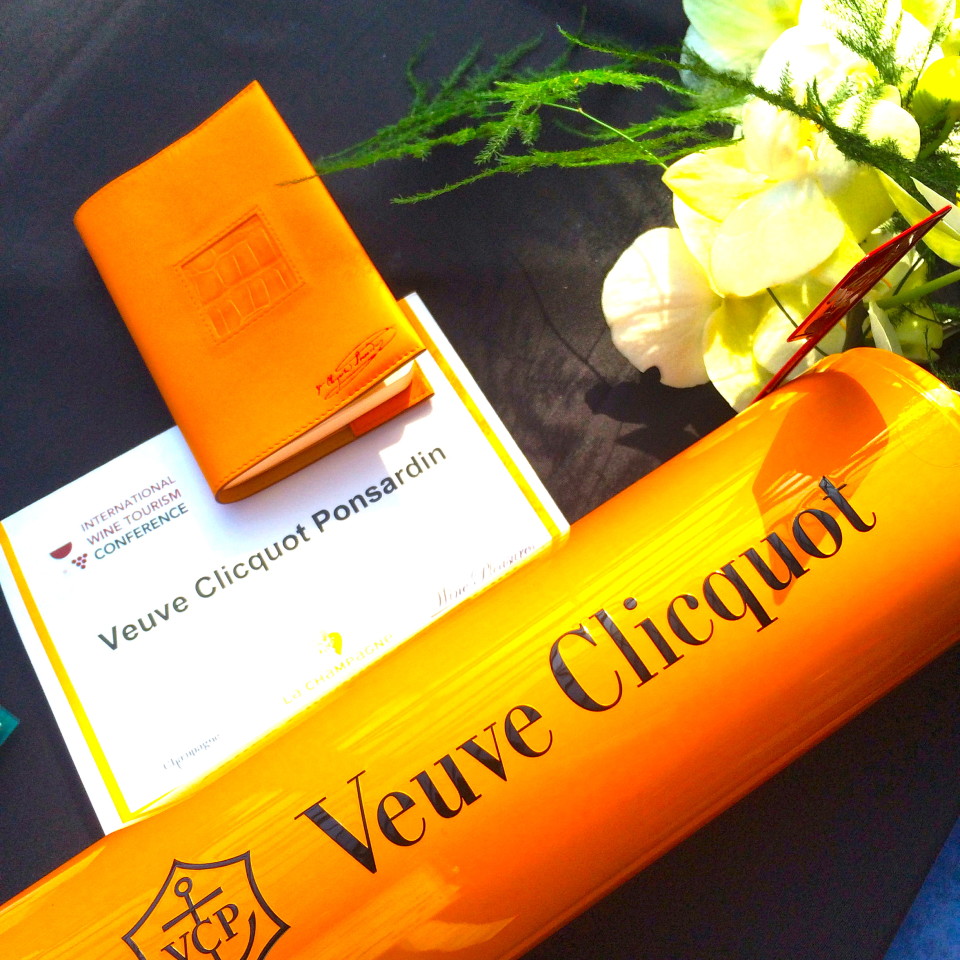

Known as the capital of Champagne, Epernay’s underground preserve more than 200 million of bottles of Champagne. In 1729, the first Champagne house set up in Epernay was founded by Nicolas Ruinart, followed by Moët & Chandon in 1743.
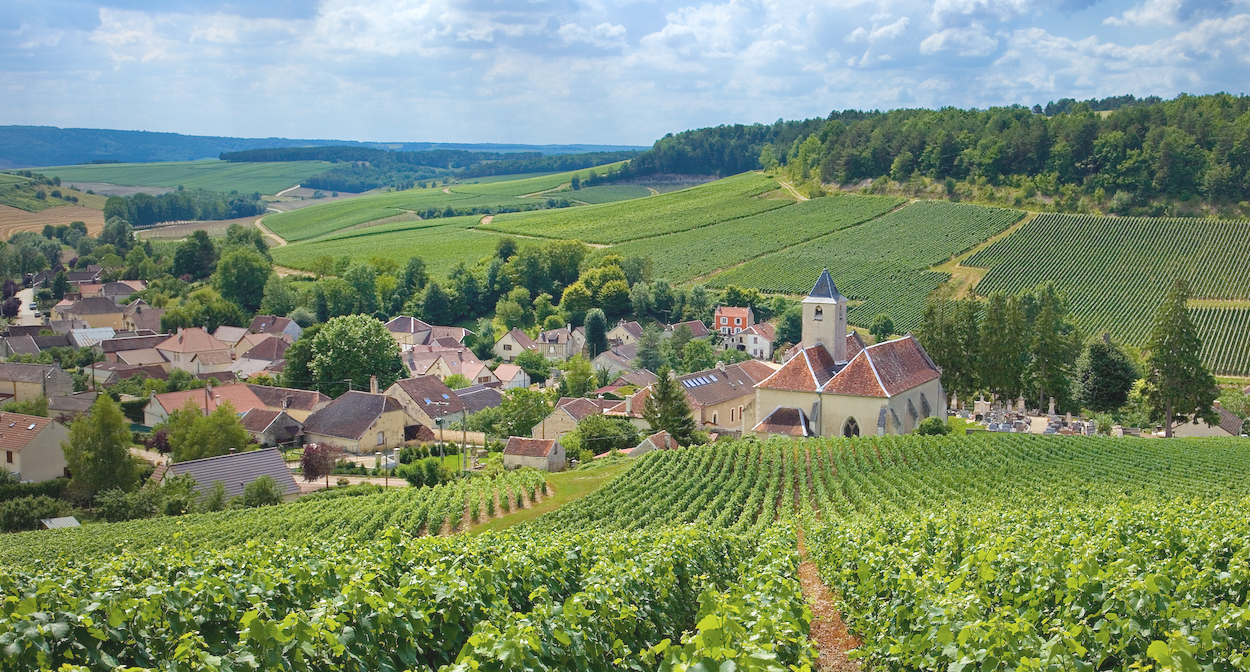
Visit the 13th-Century UNESCO World Heritage Reims Cathedral; named as the Kings’ city, an important number of Carolingian and Capetian kings were crowned on the Notre-Dame Cathedral place during more than ten centuries. Twenty-nine Kings of France were crowned between 1027 and 1825 including: Philippe Auguste, Louis IX, François I, Louis XIII, Louis XIV and Louis XVI.

This picture depicts the Coronation of Charles VII in Reims in the presence of Joan of Arc, E. Lenepveu; Reims played a prominent ceremonial role in French monarchical history as the traditional site of the crowning of the kings of France.
The famous Smiling Angel of Reims was decapitated by a bomb in 1914; meticulously restored after World War 1 it became a symbol of the city’s resistance to the Germans.

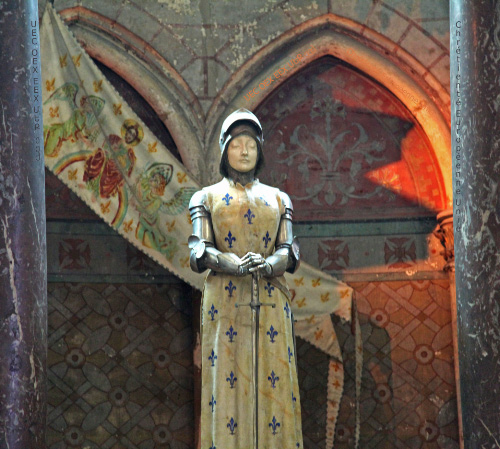
Joan of Arc at Reims
In 498-499, the Baptism of Clovis by St. Remi was the founding act of the Royal Anointing in Reims Cathedral. However, the first king to be crowned was Pepin the Short at Soissons in 751, then again at St. Denis in 754 by Pope Stephen II.

The Tau Palace and the old Saint-Remi Abbey are registered UNESCO World Heritage Sites. The Basilique St. Rémi, an 11th century Romanesque UNESCO World Heritage Site contains many interesting artifacts including: Saint Remi’s tomb, a collection of 12th century stain-glass windows and a Cattiaux grand organ. Look for the Statue of St. Remi baptizing Clovis.
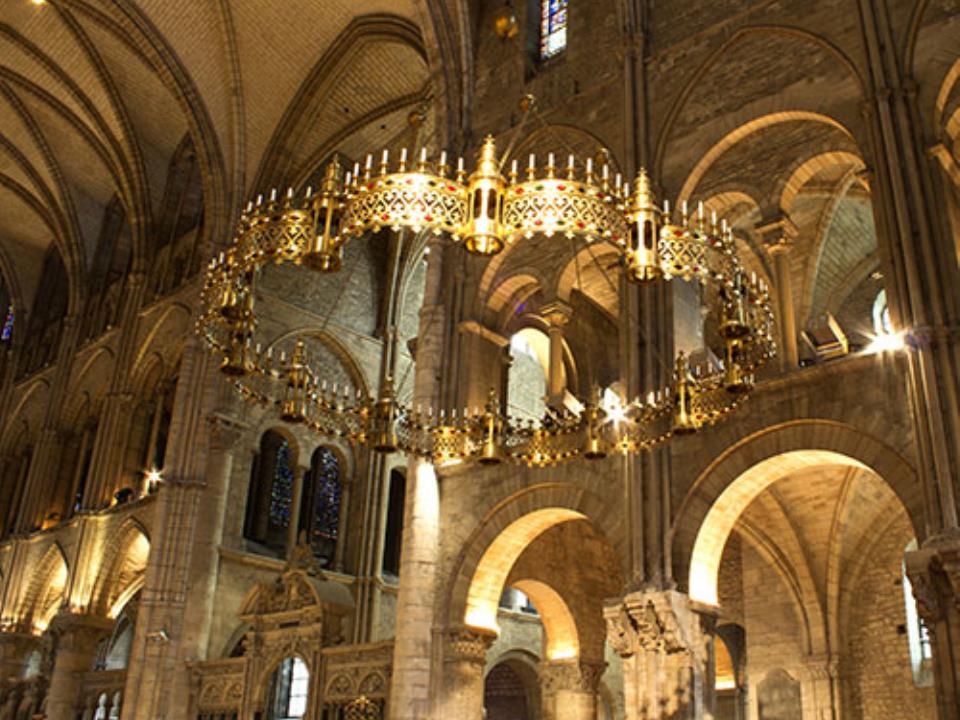

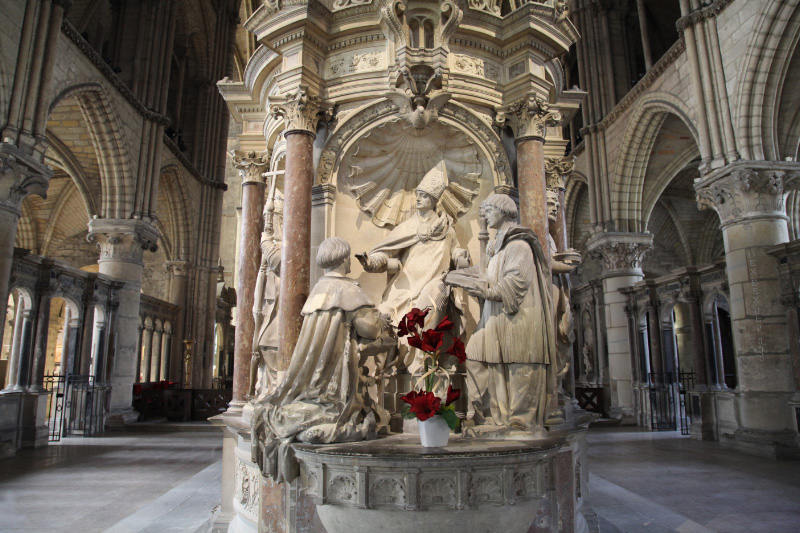
Tour the famous Champagne houses, where you can taste Champagne and admire the picturesque landscape of the region’s vineyards after you visit the historical monuments.
Spend at least 48 hours in Reims as your base for exploring the region.
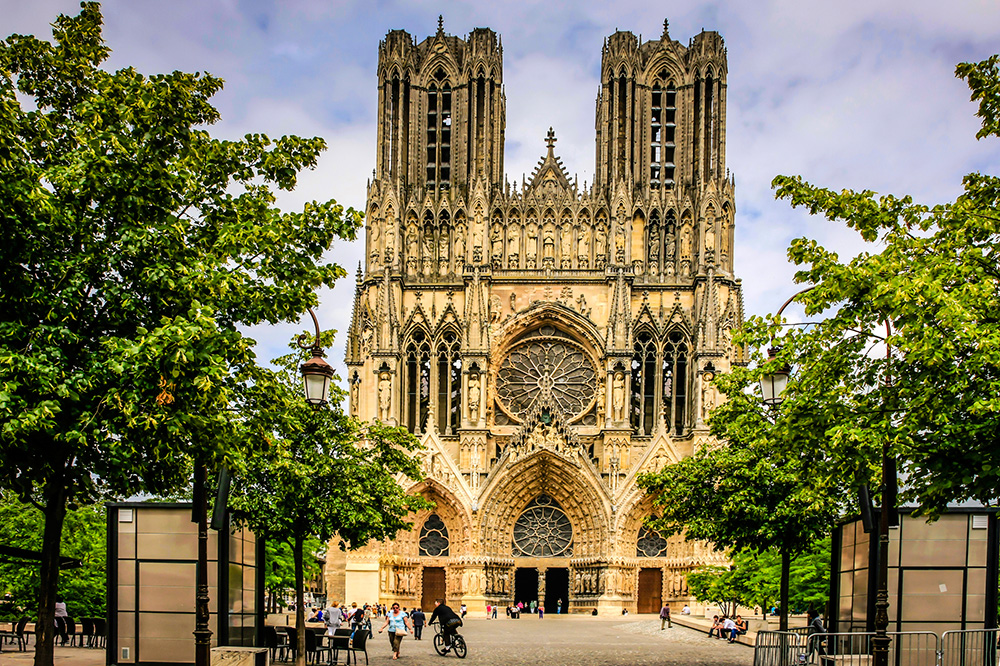
Facade of Reims (above) and La Porte Mars (the Mars Gate), triumphal arch of the Gallo-Roman town (below).

La Porte Mars (the Mars Gate), (Durocortorum); 3rd century; Reims, France.
 Porte de Mars is a well preserved third century AD ancient Roman triumphal arch in Reims; comprised of three wide arches and still adorned with many friezes portraying ancient legends, including that of Romulus and Remus. Porte de Mars was dedicated to the Roman god of war.
Porte de Mars is a well preserved third century AD ancient Roman triumphal arch in Reims; comprised of three wide arches and still adorned with many friezes portraying ancient legends, including that of Romulus and Remus. Porte de Mars was dedicated to the Roman god of war.
At the time of its construction, Porte de Mars would have been one of four arches which would have led to the Gallo-Roman settlement of Durocortorum, as Reims was then known.Local folklore claims that the inhabitants of Reims built the arch in gratitude to the Romans for bringing major roads through their city. It served as a part of castle of Archeveque and a city gate until 1544. In 1817, the buildings around it were removed, bringing the arch into full view.

Visit Chalons-en-Champagne is another perfect Vino con Vista destination; less than an hour from Paris discover more history, culture and Champagne.

Collegial Notre-Dame-en-Vaux is a proposed UNESCO World Heritage Site; with 56 bells, it is one of the largest carillon in Europe.
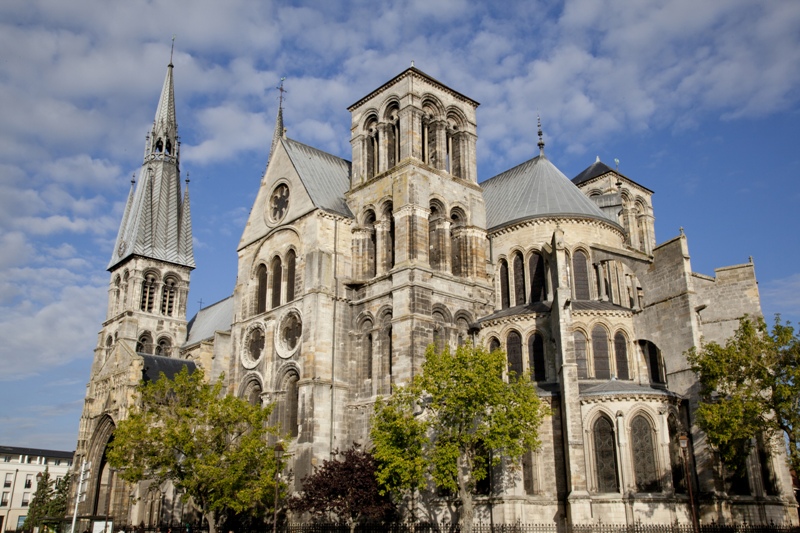

Walk through the Sainte-Croix Gate built in 1769, and dedicated to Marie-Antoinette when she arrived in France. It was dedicated to Marie Antoinette when she arrived in France and took the name of Porte Dauphine. The exterior was decorated with military trophies.
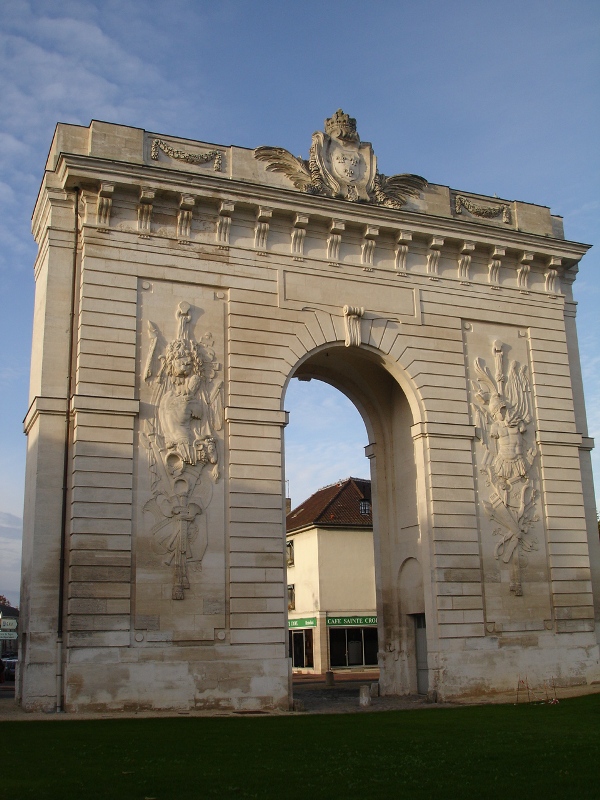
Visit the Gothic Saint-Etienne Cathedral from the 13th century.


Then stop at the Halles covered Market.

Visit the Languedoc-Roussillon Region
The Languedoc-Roussillon area in southeast France is the largest wine region, with Vin de Pays d’Oc and sparkling Crémant de Limoux among its best-known varieties produced in Limoux, near Carcassonne.
“Blanquette de Limoux is reputedly the oldest sparkling wine in France; and according to the story, it was a Benedictine monk, Dom Pérignon, who introduced the Limoux method of producing good sparkling wine, to the monks in Champagne who were looking for ways to improve the quality of their rather nondescript dry white wines. Regarding Dom Pérignon, the myth is almost certainly untrue; but it is well documented that Limoux was already producing sparkling wines in the 1540s, half a century before the technique took hold in Champagne.”

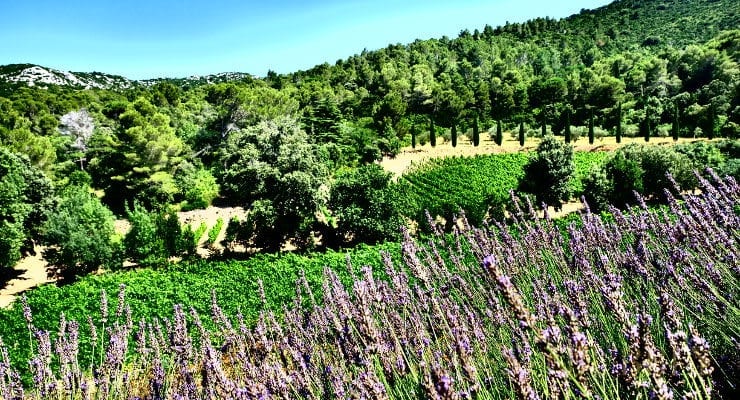
Head over to The Loire Valley
The Loire Valley between Sully-sur-Loire and Chalonnes/UNESCO
The centrally-located Loire Valley (Val de Loire) region produces most of France’s white wine. The Loire region is defined by the Loire River, which flows from the center of the country to the Atlantic Ocean. This large region grows dozens of grape varieties on many types of soil.
Tour the Château de Chenonceau and the majestic Château de Chambord.
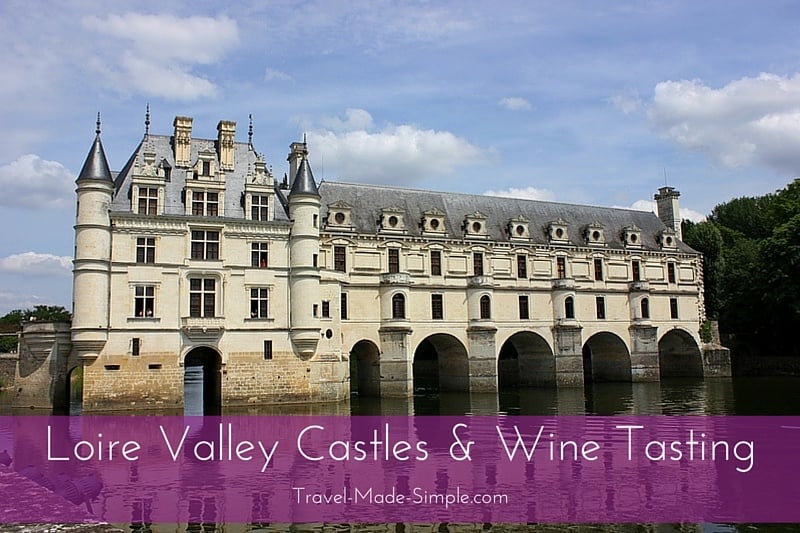 Perhaps the most famous of the Loire appellations is Sancerre. Visit the amazing Chateaux in the Loire Valley while your engaging in your wine adventure. Walk in the footsteps of the French Monarchs.
Perhaps the most famous of the Loire appellations is Sancerre. Visit the amazing Chateaux in the Loire Valley while your engaging in your wine adventure. Walk in the footsteps of the French Monarchs.
There are four sub-regions (from east to west) along the river valley: the Central Vineyards, Touraine, Anjou-Saumur, and the Pays Nantais. The Loire Valley wine region includes the French wine regions situated along the Loire River from the Muscadet region near the city of Nantes on the Atlantic coast to the region of Sancerre and Pouilly-Fumé just southeast of the city of Orléans in north central France. The Loire valley is France’s second largest producer of sparkling wines, after Champagne. Two of the more prestigious varieties are Vouvray and Saumur.
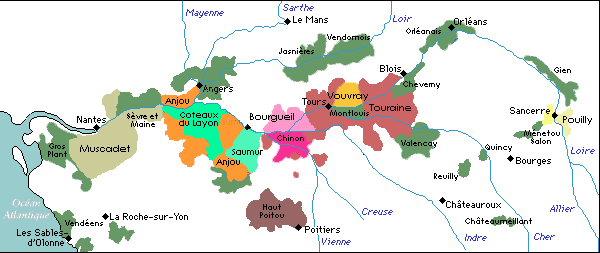
The premier chateaux of the Loire Valley are normally listed in most guidebooks as Chateau de Chambord, Chateau de Chenonceau, Chateau d’Azay-le-Rideau and Chateau d’Usse.


The Rhone Valley is located from Lyon to the Camargue.
Historic Site of Lyon/UNESCO
Arles, Roman and Romanesque Monuments/UNESCO
Roman Theatre and its Surroundings and the “Triumphal Arch” of Orange/UNESCO
Pont du Gard (Roman Aqueduct)/UNESCO
Historic Centre of Avignon: Papal Palace, Episcopal Ensemble and Avignon Bridge/UNESCO
The Rhône Valley Vineyards are divided into two large wine-growing areas: in the north, the Septentrional vineyard clings to the hillsides in the steep mountain ranges; in the south, the Meridional vineyard enjoys the plains and gentle slopes.
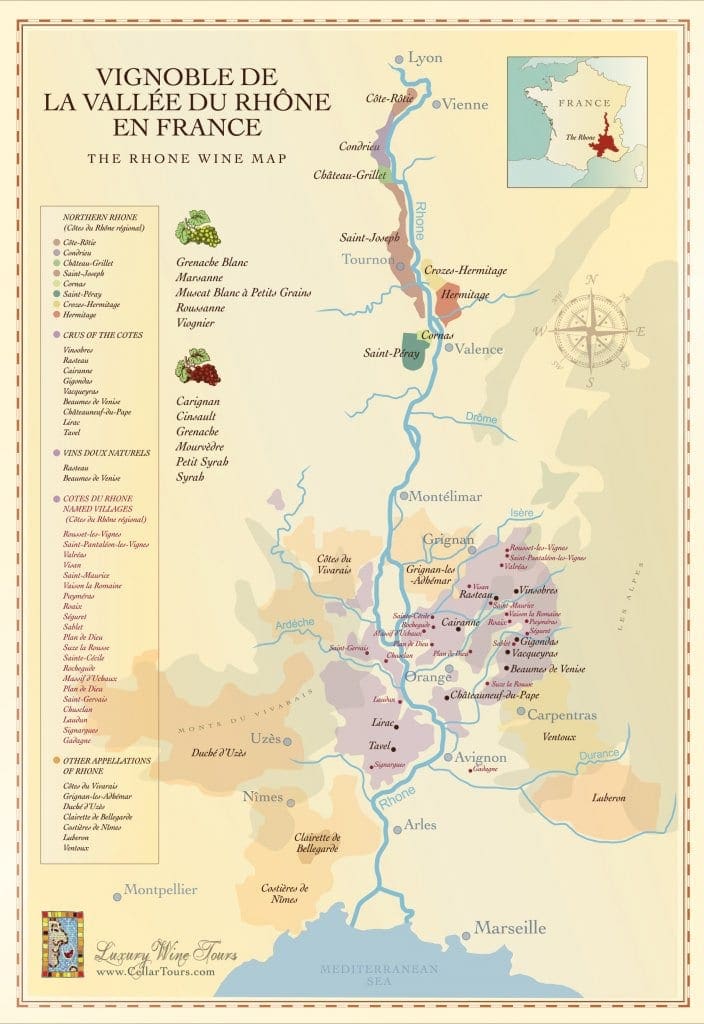
There are 14 wine routes through historic villages in varying landscapes where various wines are produced: Hermitage, Côte-Rôtie, and Beaumes-de-Venise. The Rhône valley runs from north to south along the Rhône River in southeastern France. It encompaces two fairly distinct regions, each with different climates and grapes.
- The Southern Rhône has a warmer Mediterranean climate and more varied terrain. Châteauneuf-du-Pape is the Southern Rhône’s most famous appellation, made from up to thirteen different grape varieties.
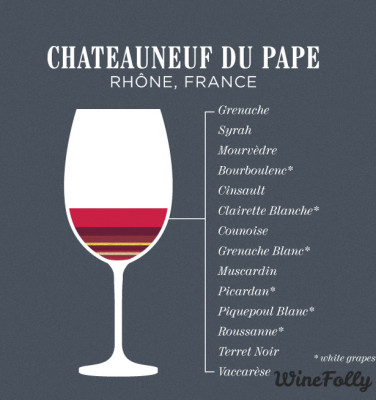
- Basic red Côtes du Rhône wine is based on grenache, syrah and mourvèdre, with cinsault and carignan sometimes blended in too.
- White grapes like grenache blanc, roussanne, clairette, and picpoul are used in the white wine.
In the southern region, discover the Palace of the Popes of Avignon and Pont du Gard; UNESCO World Heritage Sites.

 The Rhône Valley (Côtes du Rhône) is known for red wines, from syrah in the north to grenache in the south. Southern Rhone is known for the Chateauneuf du Pape blend.
The Rhône Valley (Côtes du Rhône) is known for red wines, from syrah in the north to grenache in the south. Southern Rhone is known for the Chateauneuf du Pape blend.

The Northern Rhône is smaller, with a cooler continental climate and granite soils. It is known for syrah-based reds from the famous appellations Côte-Rôtie, Cornas, Hermitage, and St-Joseph.
The Alsace Wine Region
Place Stanislas, Place de la Carrière and Place d’Alliance in Nancy/UNESCO
- The Alsace wine region has, formerly part of Germany.

- Alsace is located east of Champagne between the Vosges Mountains and the Rhine River on Germany’s border. I like their Crémant d’ Alsace, rosé sparkling wine.
-


90% of Alsatian wines are white varietal wines: Riesling, Pinot Gris, Pinot Blanc, and Gewurztraminer.
The Savoie and Jura Wine Regions

Chaîne des Puys – Limagne fault tectonic arena/UNESCO
Fortifications of Vauban/UNESCO
- Smaller regions like Savoie and the Jura have alpine Swiss influence. The Jura region is situated between Switzerland and Burgundy, on the French side of the mountain massif. The Savoie countryside stretches from Lake Geneva and Lac d’Annecy to the glaciated peaks of Mont Blanc. Annexed by France in 1860, Savoie is located in the Rhone-Alpes region, in the foothills of the French Alps south of Jura

- There are six AOC designations for the more than 200 winegrowers in the Jura. The broad Cotes de Jura AOC is the regional appellation applied to still wines from any of the regions approved (5) grapes.
- Cre’mant du Jura AOC is designated to any traditional method sparkling wine produced within the region from any of the Jura’s grapes.
- Marcvin (vin de liqueur) du Jura AOC is the fortified wine produced from, again, any of the regions approved grapes.
- In the center of the region, L’Etoile earned its white wine AOC in 1937, and today produces still wines and the other specialties from Chardonnay plus the same regional grapes.
- Go north and historic Arbois AOC, the home of Louis Pasteur, produces some of the regions best wines, including Vin Jaune. Vin Jaune, an expensive apéritif wine not unlike Amontillado sherry, is made exclusively from the Savagnin grape variety.
- The sweet vin de Paille, a rare, highly regulated blended product of regional grapes which are air dried to meet a minimum alcohol level of 14.5!
- The most prestigious appellation for Vin Jaune in Jura is Château Chalon. This wine is made from late harvested grapes, and then left to mature in casks for at least six years.

Wines of Southwest France
- Southwest France’s wines overlap with neighboring Spain. Inland and southwards from the Bordeaux and the Saint Emilion regions, there are a number of less well-known wine growing areas, many of them producing quite good wines at very reasonable prices.
- These include: Bergerac, Cahors, Gaillac and Marcillac (all Appellation Contrôlée wines) , Côtes du Tarn or Vin de Pays du Lot. While Marcillac is a small area, the vineyards of Cahors, Gaillac and Bergerac are quite extensive, and best known for their reds. The Cahors area produces some of the richest and darkest red wines in France, principally using the Malbec grape variety. However the Bergerac wine producing area is also known for its white wines, including some strong sweet aperitif wines such as Montbazillac.
- Towards the Pyrenees, there are some good white wines from the vineyards of Jurançon and Béarn, notably from the Gascony vineyards of Pacherenc-du-Vic-Bilh, reputed for its distinctive aperitif wines.
- .
![[Maps] "Wines of South West France" Feb-2014 by Winefolly.com - Bergerac, Montbazillac, Côtes du Lot, Côtes du Tarn, Armagnac](https://i.pinimg.com/564x/9f/19/be/9f19beeebc65201e73d9fb99ebfff15c.jpg)
- Wines from Corsica

- The island of Corsica combines the best of French and Italian traditions. In 1968, Patrimonio was established as Corsica’s first Appellation d’origine contrôlée (AOC). Today, Corsica has nine AOC regions including the island-wide designation Vin de Corse AOC. The three leading grape varieties of the region are: Nielluccio (Sangiovese), known as the spice wine of France, Sciacarello and Vermentino
Alsace, Bordeaux, Burgundy, Loire, Provence, and the Rhone Valley comprise the dominant French wine regions. These regions are known for particular grape varietals as dictated by the district’s indigenous terroir. There are over 200 indigenous wine varieties in France.
People often ask me what my favorite red wine is so here’s my list of my favorite 4 regions in France: Bordeaux, Burgundy, the Rhone Valley and Champagne.
Bordeaux
In the Bordeaux region, the permissible grape varieties in red Bordeaux are: Cabernet Sauvignon, Merlot, Cabernet Franc, Malbec and Petit Verdot. Remember CMCMP:
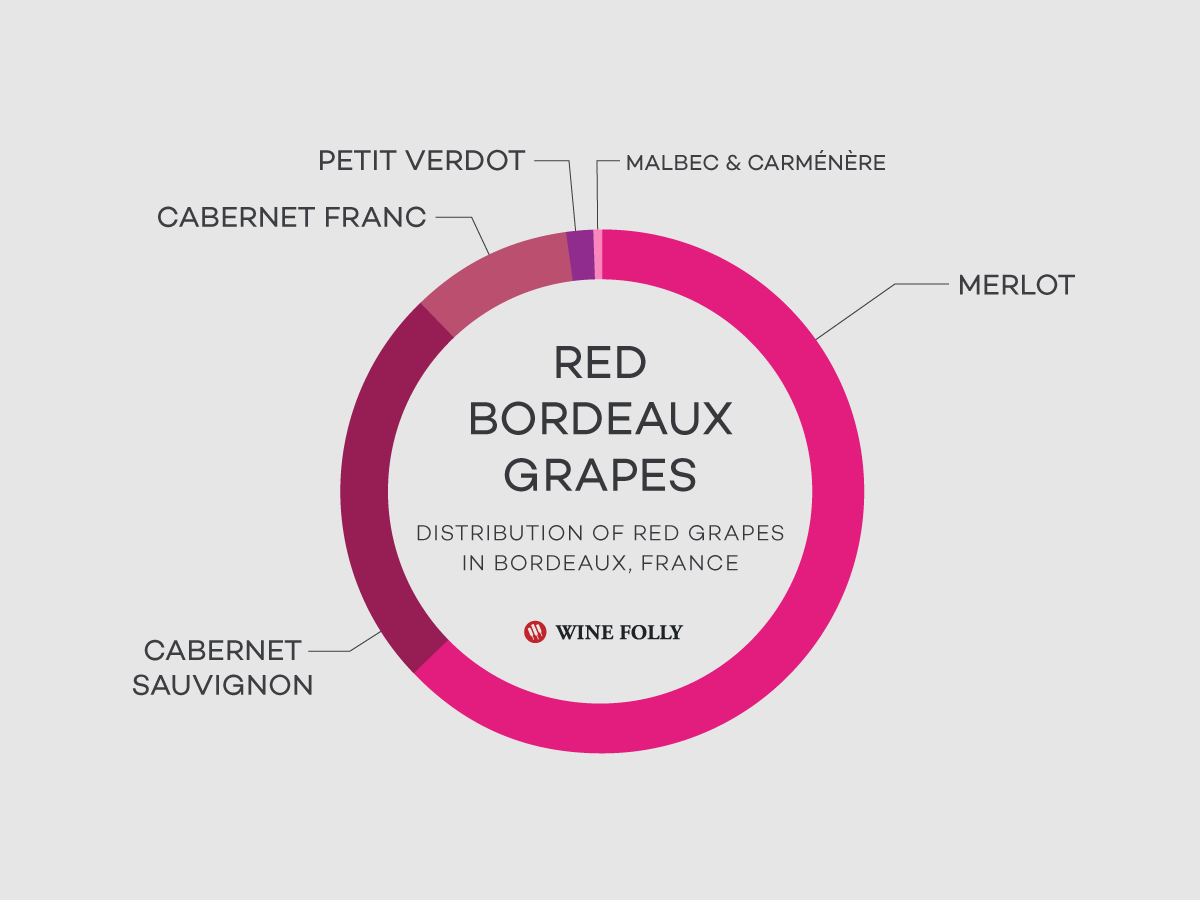
Bordeaux, in southwest France, is primarily known for blended red wines driven by cabernet sauvignon on the Left bank of the Gironde River and merlot and cabernet franc on the Right bank of the River.
Bordeaux has won many Best of Wine Tourism Awards from The Great Wine Capitals.
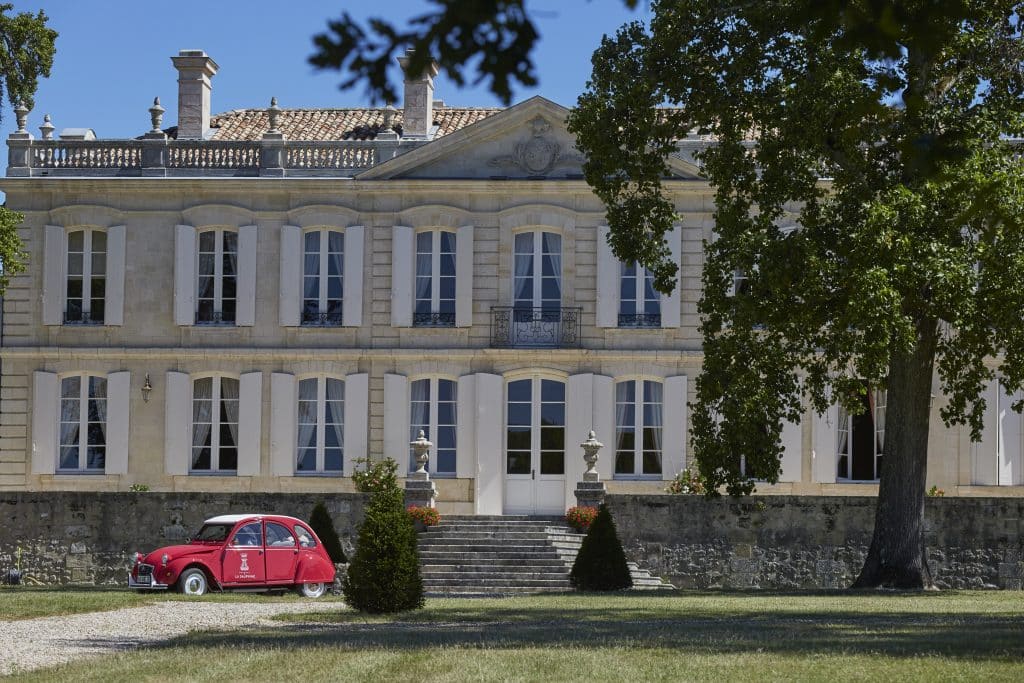
Château de La Dauphine won in 2020 and was also a winner in : 2014 for Architecture & Landscapes, 2016 for Food Service and 2018 for Environmental Practices. Château de La Dauphine is the one and only estate of Bordeaux having 4 GOLD awards and an International award.
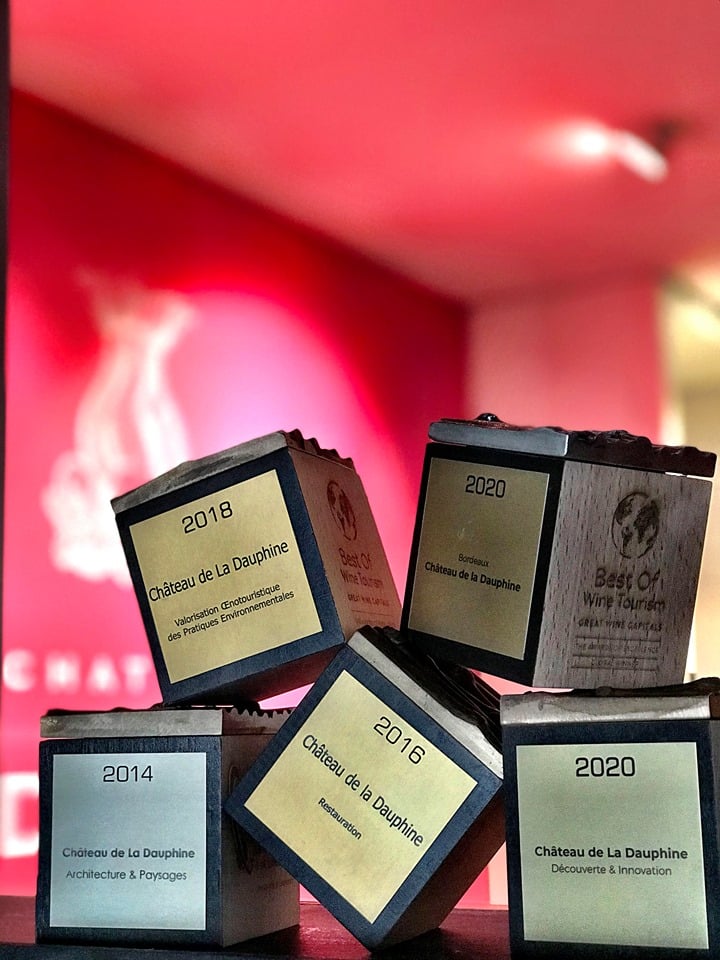
In 1663, Cardinal de Richelieu acquired the land associated with the Duchy of Fronsac for his family. Ever since then, the reputation of Fronsac’s wines has continued to spread. In the 18th century, the revolution in the quality of the Libourne region’s wines took root here, and the flourishing international maritime trade contributed substantially to the recognition of Fronsac’s vineyards as being among the finest in the Bordeaux region.
“A former fiefdom, Charlemagne built a fortress here; the hills are perfectly sculpted to accommodate the most noble grape varieties. Louis XVI’s mother, Maria Josepha of Saxony gave her title of La Dauphine to the property in memory of her stay at the Château in the 18th century.”

Château de La Dauphine, SASU Château de La Dauphine
Rue Poitevine, 33126 Fronsac
+33 (0)5 57 74 06 61
On the Right Bank, things are a bit simpler, with two main notable communes:
- Pomerol: a very small commune, but distinctive, which produces glamorous and opulent wines dominated by top quality Merlot.
- Saint Émilion: wines have moderate to high tannins, but a soft and rich mouthfeel, and complex red berry fruit and plum aromas. Blends mix Cabernet Franc and Merlot in various proportions. Le Cloître des Cordeliers won the 2020 Regional Wine Tourism Award for 2020 “REGIONAL WINNER
ARCHITECTURE AND LANDSCAPES” BORDEAUX FRANCE. - The first wine based UNESCO Heritage site, Saint Emilion has to be one of the most romantic and authentic places in the Bordeaux region. This perfectly preserved medieval village also makes a sparkling wine called Crémant de Bordeaux.
- “Classified as a Historical Monument and listed as a UNESCO World Heritage site, the Cordeliers Cloister is one of the most picturesque monuments in Saint-Émilion. This former 14th century monastery takes its name from the Franciscan monks who wore a cord rope around their brown robe. With its Romanesque architecture, this magical place houses a vast garden, monolithic columns, and a network of underground cellars and passages carved in limestone at a depth of 20 metres. It is under these grounds that sparkling wines have been matured since 1892.”
The Left Bank can be broken down into three main regions: Médoc, Haut-Médoc and Graves. For quality wine making, you also need to know the top communes and producers. The most famous ones have their own unique and distinct style:
- Margaux (Haut-Médoc): described as charming when well made, the style is perfumed, floral, with a silky texture. This is considered the feminine version of Left Bank Bordeaux.
- Pauillac (Haut-Médoc): concentrated, with distinct aromas of cassis, cedar, and tobacco. This is the masculine version of Bordeaux in the Left Bank.
- St-Estèphe (Haut-Médoc): deeply coloured, tannic, austere when young, but with a great ageing potential.
- St-Julien (Haut-Médoc): perceived as the commune for wine connoisseurs who seek subtlety, it is somewhere in between all the three wines above.
- Pessac-Léognan (Graves): this commune can produce both red and white wines, compared with the others in this list, which are red wine only. The reds of Pessac-Léognan have a distinct mineral, earthiness aroma, topped with smokiness. Château Smith Haut Lafitte (Pessac-Leognan), France won the International Best Of Wine Tourism awards for Bordeaux in 2018.

- Bordeaux is defined by its historic wine-producing châteaux, which were classified in 1855 into five quality levels, or “growths,” that still influence the Bordeaux market today. The five first-growth estates (also called premier crus) command the highest prices, with their wine often sold as futures before the vintage is even released. All 61 classified châteaux are in the Médoc region on the left bank of the Gironde River. The right bank appellations of Pomerol and Saint-Émilion, although not included in the 1855 classification, are home to a handful of equally famed producers.
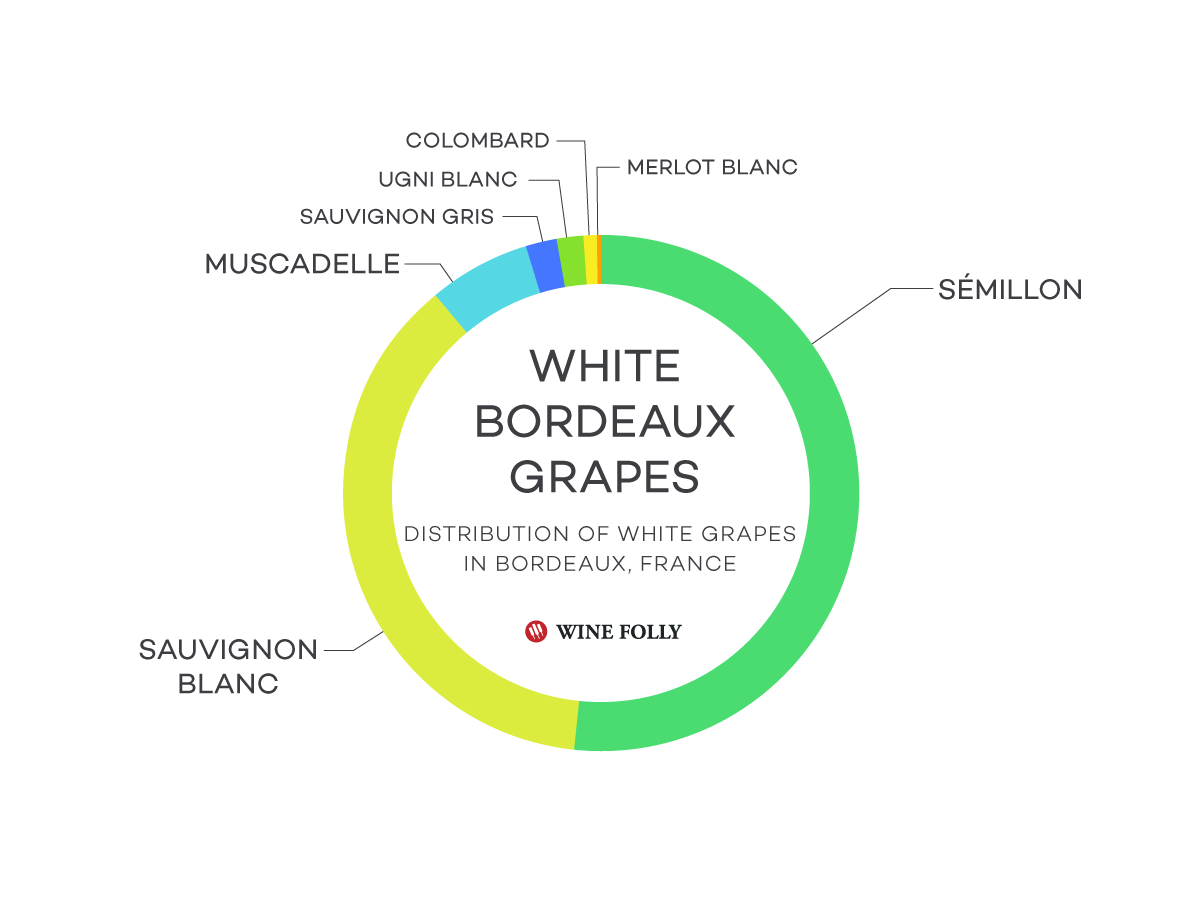
- The sweet wine appellation of Sauternes produces luscious dessert wines made from botrytis-affected grapes, which means a good fungus rots the grapes slightly making them sweeter and have a higher alcohol content.
- The Burgundy Region of France
I love Pinot noir associated with the Burgundy region of France. Burgundy, located between the gastronomic hubs of Dijon and Lyon in eastern France, is dominated by pinot noir and chardonnay. Unlike in Bordeaux, the best vineyard sites may be split up among many small winemakers. Winemaking estates here are called domains.

- The grand cru vineyards are clustered in the north of the region, along the Côte d’Or. The upper part of the “gold coast” is called the Côte de Nuits, where the region’s best pinot noir vineyards are planted. Burgundian pinot noir is earthy and elegant, with soft tannins and spicy cherry fruit flavors.
- South of the Côte de Nuits, the Côte de Beaune is known for the best chardonnay sites, where the wines are rich and full-bodied, yet mineral.
- Further south, the Côte Chalonnaise and Mâconnaise sub-regions produce more value-driven chardonnay wines.
- Chablis, a region to the northwest of the Côte d’Or, makes chalky, high-acid chardonnay wines.

- The Rhone Region of France
The Southern Rhone Valley produces Chateau Neuf du Pape which is another one of may favorites. I love the embossed Papal Hat and Saint Peter’s Keys on the wine bottle.
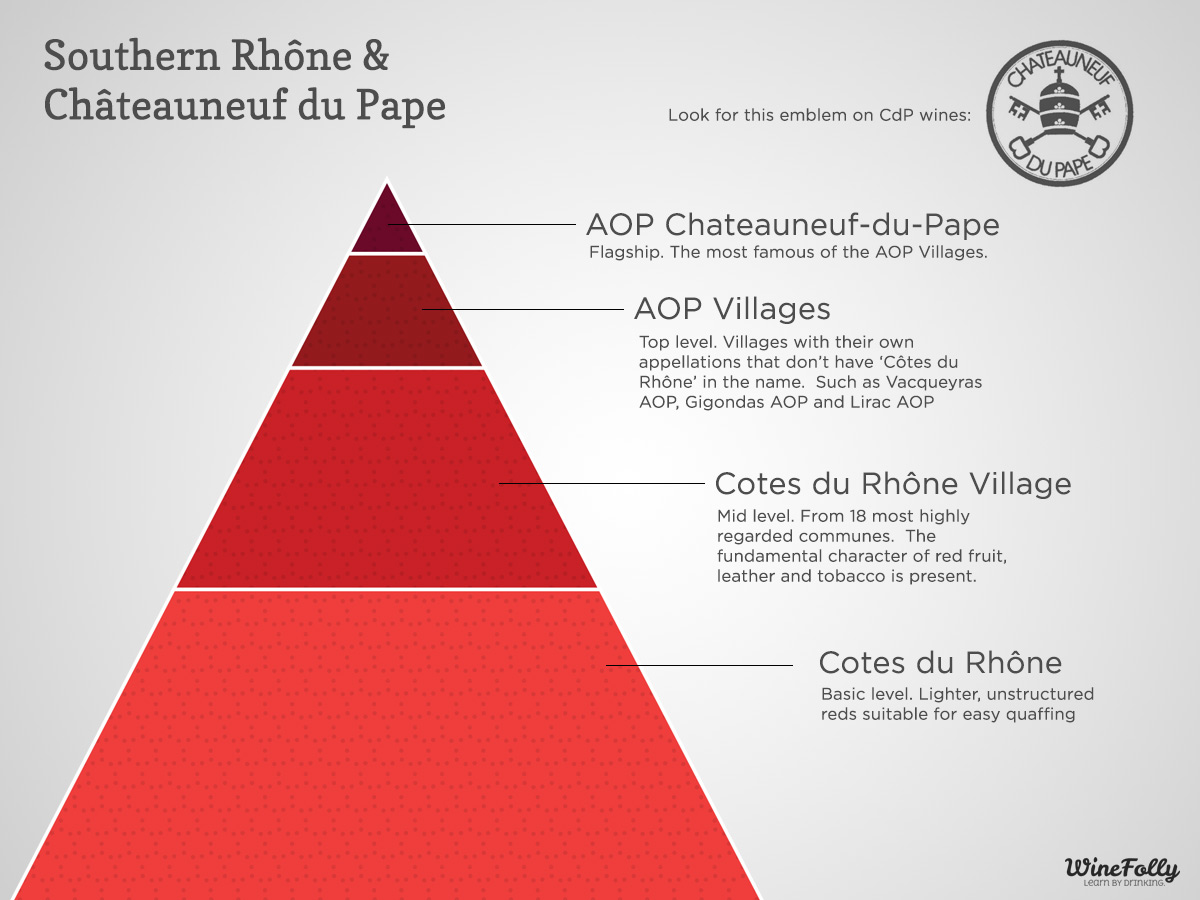 The Rhône valley runs from north to south along the Rhône River in southeastern France. It has two fairly distinct regions, each with different climates and grapes.
The Rhône valley runs from north to south along the Rhône River in southeastern France. It has two fairly distinct regions, each with different climates and grapes.
- The Southern Rhône is almost ten times the size of its northern neighbor, and has a warmer Mediterranean climate and more varied terrain. Châteauneuf-du-Pape is the Southern Rhône’s most famous appellation, known for bold, high alcohol reds made from up to thirteen different grape varieties. Basic red Côtes du Rhône wine, which accounts for more than half of Rhône wine production, is based on grenache, syrah and mourvèdre, with cinsault and carignan playing smaller roles. This blended red is classic medium-bodied bistro wine, full of ripe red fruit and herbal notes. White wines from the Southern Rhône are usually a blend of soft, fruity white grapes like grenache blanc, roussanne, clairette, and picpoul.

- The Northern Rhône is smaller, with a cooler continental climate and granite soils. It is known for syrah-based reds from the famous appellations Côte-Rôtie, Cornas, Hermitage, and St-Joseph. These wines are smokey and meaty, with olive and violet notes. Whites from the Northern Rhône are made from viognier, which is oily and tropical fruited, and marsanne and roussanne, grapes which are often blended together in broad, low-acid wines with orchard fruit aromas. The Northern Rhône produces about 5% of Rhône wine, most of very high quality.

- The southern edge of the Rhône region touches Provence to the east and the Languedoc-Roussillon region to the west. Provence is known for rosé wines from Southern Rhône grape varieties, while Languedoc produces large quantities of red wines from the same varieties.
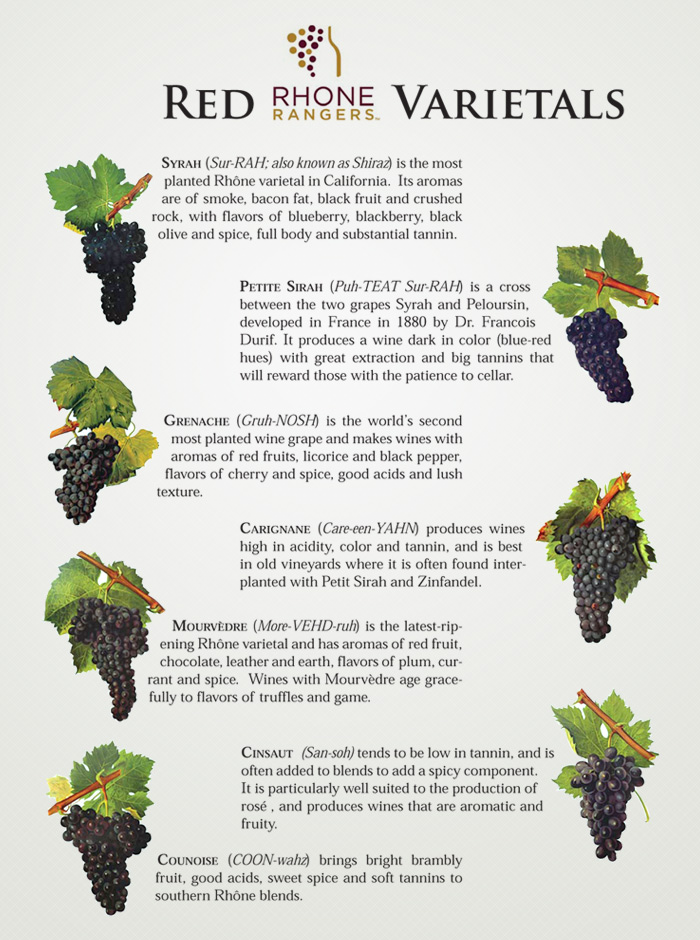
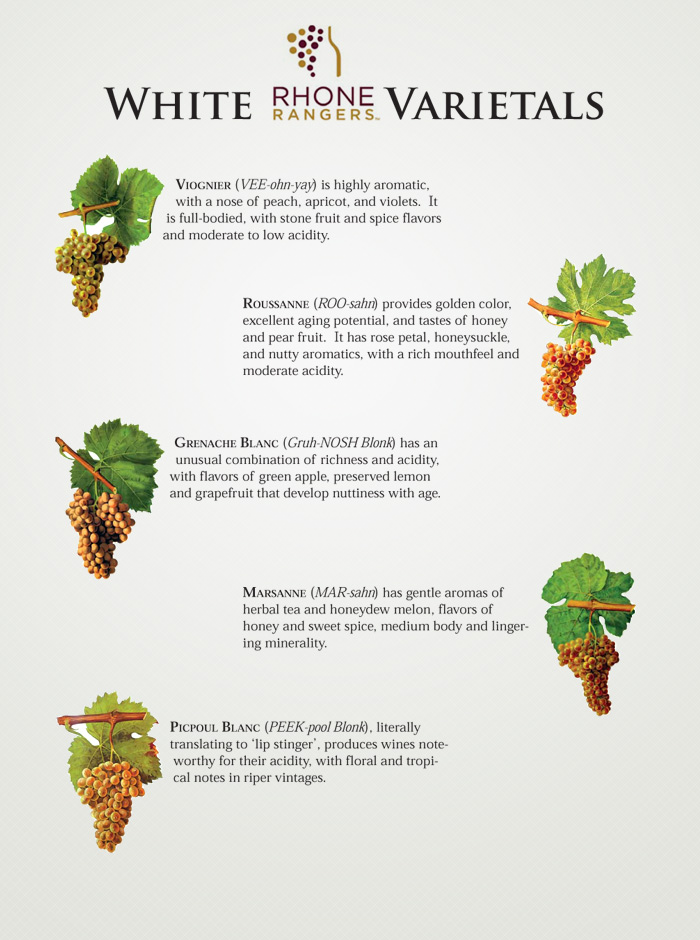
- The Champagne Region of France
Who doesn’t love Champagne? France’s northernmost wine region is located just east of Paris along the Marne River. At this northern latitude, grapes struggle to ripen, so the dominant wine style is sparkling; acidity is a virtue.
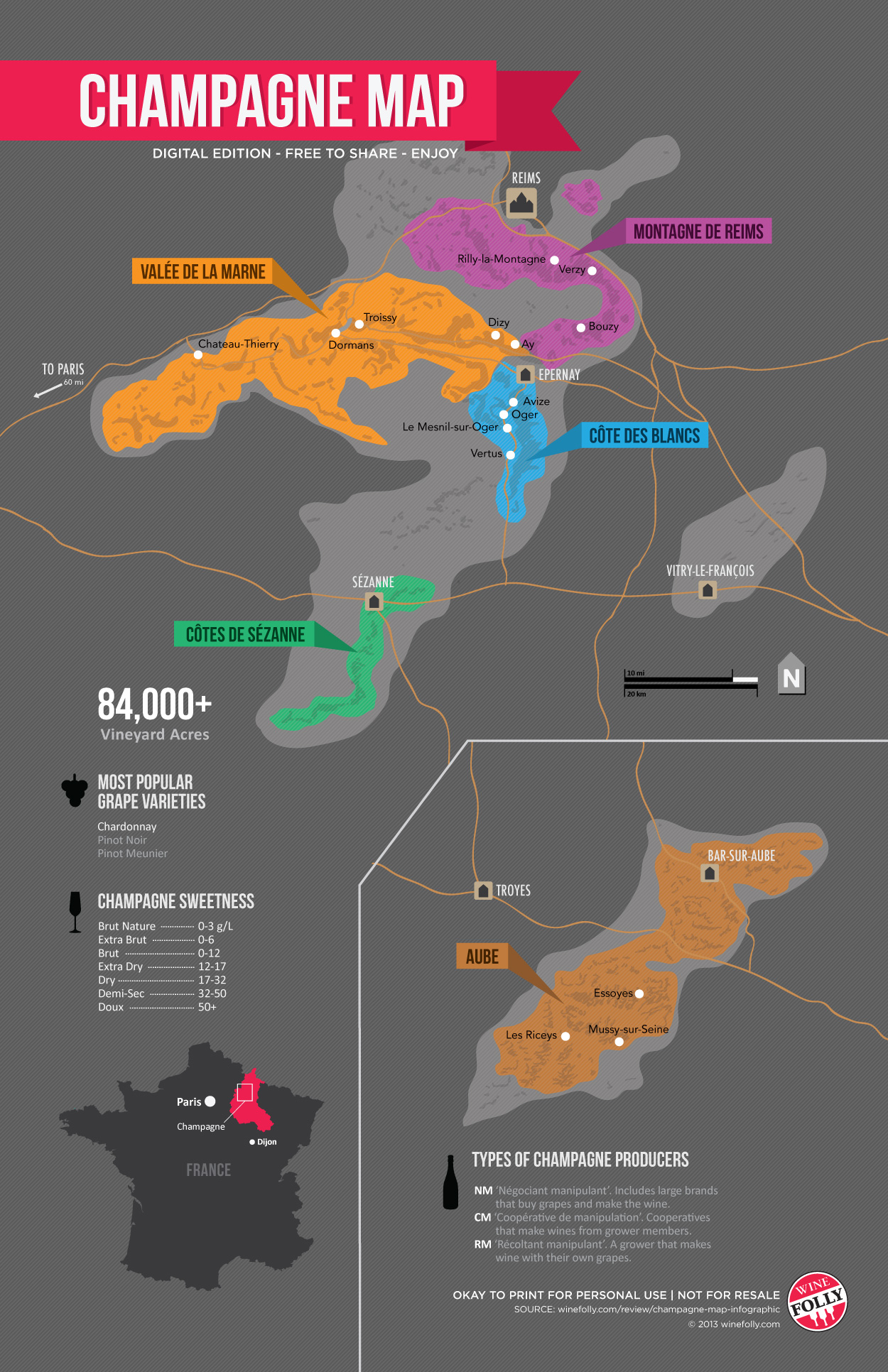
- Champagne is made using the méthode Champenoise, in which the wine undergoes a second fermentation in the bottle. This traps carbon dioxide in the wine, creating strong yet fine bubbles. The wine also gains complex brioche-like, nutty notes from extended contact with the lees (spent yeast) in the bottle.
- The main grapes of Champagne are chardonnay, pinot noir, and pinot meunier, the latter two of which are used to make blanc de noirs, white wine from black grapes. The five subregions are: the Aube, Côte des Blancs, Côte de Sézanne, Montagne de Reims, and Vallée de la Marne. Champagne can be made from just one of the varieties or a blend of two or more varieties.
- Champagne’s taste is not as dependent on the vintage as other wines in France. Most Champagne is a blend of wines from different vintages, which allows for a more consistent flavor profile. Champagne is available with sugar levels ranging from bone dry, to extra-brut and brut.

I found this comprehensive list of Wine Spectator wine maps that represent my Vino con Vista travels through France including: Alsace, Bordeaux, Burgundy, Champagne, Languedoc, Loire Valley, Provence and the Rhône Valley.
Here are some interactive Wine Spectator Maps for your review:
http://assets.winespectator.com/wso/Maps/Francemap.pdf
Alsace A detailed look at the appellation’s top crus, broken out by town and the corresponding vineyard. Alsace is located on the border of Germany and France. Today if you visit Alsace, you can see how the interventions of two mega empires affected the area through its architecture and the presence of both French and German languages. Along with Austria and Germany, it produces some of the most noted dry Rieslings in the world as well as highly aromatic Gewürztraminer wines. Wines are produced under three different AOCs: Alsace AOC for white, rosé and red wines, Alsace Grand Cru AOC for white wines from certain classified vineyards and Crémant d’Alsace AOC for sparkling wines.
http://assets.winespectator.com/wso/Maps/Alsacemap.pdf

Bordeaux A detailed look at the region’s key districts, including the Médoc and its appellations, Pessac-Léognan, the Right Bank areas of Pomerol and St.-Emilion, and the sweet wine areas of Sauternes and Barsac
http://assets.winespectator.com/wso/Maps/Bordeauxmap.pdf

The Bordeaux region is naturally divided by the Gironde Estuary into the Left Bank and the Right Bank. The Left Bank area includes the Médoc and Graves. The Right Bank area includes the Libournais, Bourg and Blaye. The main culprit for Bordeaux vintage variation is the weather. This is a region that is heavily influenced by the Atlantic Ocean and the two rivers that cross it. The good news is that this maritime climate protects the vines from winter freeze and spring frost.

“The Médoc is divided into Haut-Médoc (the upstream or southern portion) and Bas-Médoc (the downstream or northern portion, often referred to simply as “Médoc”).”
There are various sub-regions within the Haut-Médoc, including St-Estèphe, Pauillac, St.-Julien and Margaux. Graves includes the sub-regions of Pessac-Léognan and Sauternes. Sauternes includes the sub-region of Barsac.
The Libournais includes the sub-regions of Saint-Émilion and Pomerol. There is an additional wine region of Entre-Deux-Mers, so called because it lies between the Garonne and Dordogne rivers, which combine to form the Gironde.
All of these regions (except the Libournais) have their own appellation. They are “governed by Appellation d’origine contrôlée laws which dictate the permissible grape varieties, alcohol level, methods of pruning and picking, density of planting and appropriate yields as well as various winemaking techniques.”
Bordeaux wine labels will usually include the region on the front of the label.
‘mis en bouteille au château’ or ‘mis en bouteille à la propriété’ (bottled at the property of the producer)

A general rule of thumb is that the Left Bank is predominately Cabernet Sauvignon based with the Right Bank being more Merlot based. The Graves area produces both red wine and white wine from the Sauvignon blanc, Sémillon and Muscadelle grapes.
“Saint-Émilion is an Appellation d’origine contrôlée (AOC) for wine in the Bordeaux wine region of France. It is situated in the Libourne subregion on the right bank of the Dordogne.”

Deutsch: Weinberg in der Côte de Nuits, Burgund, Frankreich English: Vineyard in Côte de Nuits, Burgundy, France (Photo credit: Wikipedia)
Burgundy / Red Wine A look at key red-wine producing villages in the Côte de Nuits and Côte de Beaune
Burgundy / White Wine An overview of the appellations of Chablis, the Côte de Nuits, the Côte de Beaune, Côte Chalonnaise and the Mâconnais
Champagne The heart of Champagne, including the districts of Côte des Blanc, Montagne de Reimans and Vallée de la Marne, plus key grand cru villages
Loire Valley A detailed look at the appellations along the Loire River, from Muscadet to Chinon and Vouvray to Sancerre and Pouilly-Fumé

Côtes-du-rhône villages red 2007 Français Rhône Valley / Northern A detailed look at the appellations along the northern Rhône River, including Côte-Rôte, Condrieu, Château Grillet, St.-Joseph, Hermitage, Crozes-Hermitage, Cornas and Saint-Péray
Rhône Valley / Southern A detailed look at appellations including Châteauneuf-du-Pape, Gigondas and Vacqueyras, as well as the Côtes du Rhône and named Côtes du Rhône-Villages
Southern France An overview of the appellations in the Languedoc-Roussillon, Provence and southern Rhône regions

Provence is a large wine-producing area, best-known for its rosé wines, the most famous of which are Côtes de Provence and Côteaux d’Aix. The most famous of the area’s white wines is Bandol, celebrated since the middle ages. The Provence region also includes the southern end of the Côtes du Rhone AOP area.
http://assets.winespectator.com/wso/Maps/SoFrancemap.pdf
South West France Wine
There are plenty of UNESCO World Heritage sites to explore in the Southwest region of France as you Tour and Taste your way through the vineyards. Here they are:
Decorated Cave of Pont d’Arc, known as Grotte Chauvet-Pont d’Arc, Ardèche/UNESCO
The Causses and the Cévennes, Mediterranean agro-pastoral Cultural Landscape?UNESCO
Episcopal City of Albi/UNESCO
Pyrénées – Mont Perdu */UNESCO
Historic Fortified City of Carcassonne/UNESCO
Canal du Midi/UNESCO
Abbey Church of Saint-Savin sur Gartempe/UNESCO
Prehistoric Sites and Decorated Caves of the Vézère Valley/UNESCO
Here’s a map of wine regions in Southwest France:

Lourdes, is a pilgrimage town, Hautes-Pyrénées département, Occitanie région, southwestern France, southwest of Toulouse. Situated at the foot of the Pyrenees and now on both banks of a torrent, the Gave de Pau, the town and its fortress formed a strategic stronghold in medieval times. I never miss an opportunity to visit a Pilgrimage Area or Church in Europe.

You may want to visit the Sanctuary and Grotto of Our Lady of Lourdes and bring home some holy water and rosaries for your friends; especially if they have seen “The Song of Bernadette Movie” with Jennifer Jones; one of my childhood favorites. This drama focuses on Bernadette Soubirous (Jennifer Jones), a young French woman who experiences vivid visions of the Virgin Mary at Lourdes.

The Sanctuary of Our Lady of Lourdes. The first sanctuary to be built was the Crypt, which is below the Basilica of the Immaculate conception. Construction started in September 13,1863 and was consecrated in May 1866, by the Bishop of Tarbes.
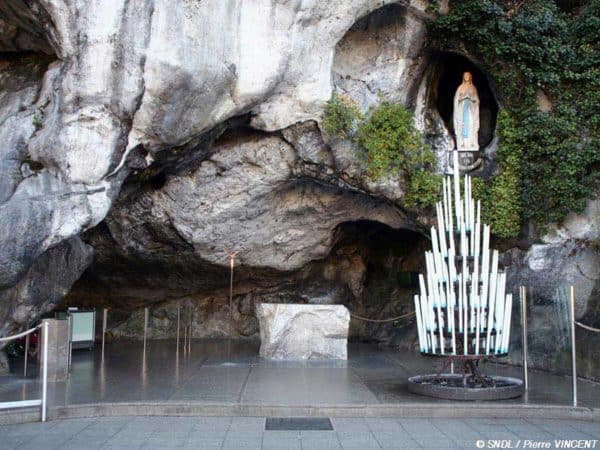
Thanks Wine Spectator–we love wine regions and UNESCO World Heritage Sites at www.vino-con-vista.com
Related articles
 A Beginner’s Guide to French Wine
A Beginner’s Guide to French Wine The Guide to Côtes-du-Rhône Wine w/ Maps
The Guide to Côtes-du-Rhône Wine w/ Maps Travel to Tuscany’s Wine Regions in Italy
Travel to Tuscany’s Wine Regions in Italy Wine Review: Reds from the Rhône
Wine Review: Reds from the Rhône
I love traveling around the world exploring wine regions and enjoying the vineyard Vino con Vista. I have visited most of the wine regions of France. Even though there are 18 regions in France, there are only 9 wine regions; unlike Italy with 20 regions cloaked with vineyards. The Major Wine Regions in Vino con Vista France are Packed with UNESCO World Heritage Sites. France is home to 45 UNESCO World Heritage Sites: 39 cultural sites, 5 natural sites and 1 mixed site. France shares 4 of those sites with other countries; these are considered cross-border sites. My trips to Europe are generally dictated by the local UNESCO sites. My goal has been to visit all the sites in France, Italy, Spain and Portugal. Prior to COVID, I almost achieved this goal. I only have a few places left on this bucket list!

The Climats, terroirs of Burgundy, Champagne Hillsides, Houses and Cellars, the Jurisdiction of Saint-Emilion and the Bordeaux, Port of the Moon region of Aquitaine are UNESCO World Heritage Sites and also the most famous French wine-producing regions.

A champagne vineyard in Villenauxe-la-Grande, near Epernay
Champagne Hillsides, Houses and Cellars are UNESCO Sites just an hour away from of Paris. Located in north-eastern France, the unique chalk cellars and the “historic vineyards of Hautvillers, Aÿ and Mareuil-sur-Aÿ, Saind-Nicaise Hill in Reims, and the Avenue de Champagne and Fort Chabrol in Epernay all represent the Champagne agro-industrial landscape.” There are three UNESCO components: the supply basin formed by the historic hillsides, the production sites with their underground cellars, and the Champagne Houses, which are sales and distribution centers.

Combining a wine tourism trip with a UNESCO World Heritage trip is usually my favorite way to travel in Europe. The Cathedral of Notre-Dame, Former Abbey of Saint-Rémi and Palace of Tau, Reims are all UNESCO sites in the Champagne Region of France.
Paris, Banks of the Seine is also a UNESCO World Heritage Site. Near Paris, there are many UNESCO World Heritage Sites to visit including:
Palace and Park of Fontainebleau
Provins, Town of Medieval Fairs
The vineyards of Bordeaux are the only vineyards with immediate access to the sea; a competitive advantage that enabled them to be France’s major wine exporting region for many centuries. The best estates in these areas have the right to sell wines designated as grand cru. At the Exposition Universelle of 1855 in Paris, Emperor Napoleon III asked each wine region to establish a classification. The 1855 Classification has been a factor in the continued success of the Châteaux at the top of the classification — namely the first and second growth Châteaux.

Châteaux of Bordeaux
Grand Cru Classé is tied to a specific chateau or estate, rather than a contiguous vineyard. Created in 1855, it comprises only left bank chateaus in Médoc, Graves and Sauternes, ranked from first to fifth growths, based on their value at that time.
 The first growths are called premier crus, while second through fifth growth crus are called crus classés.
The first growths are called premier crus, while second through fifth growth crus are called crus classés.

The five first-growth owners: Prince Robert de Luxembourg of Haut-Brion, Florence Rogers-Pinault of Latour, Baroness Philippine de Rothschild of Mouton-Rothschild, Corinne Mentzelopoulos of Margaux and Baron Eric de Rothschild of Lafite Rothschild.
“Bordeaux is defined by its historic wine-producing châteaux, which were classified in 1855 into five quality levels, or “growths,” that still influence the Bordeaux market today. The five first-growth estates (also called premier crus) command the highest prices, with their wine often sold as futures before the vintage is even released. All 61 classified châteaux are in the Médoc region on the left bank of the Gironde River. The right bank appellations of Pomerol and Saint-Émilion, although not included in the 1855 classification, are home to a handful of equally famed producers.”
 Viticulture and Wine Tourism promote the regions of the world that are a treasure trove of beautiful landscapes, generally accompanied by local delicacies. The best wine regions have exceptional culinary artistry and sumptuous Michelin-starred gourmet chefs. I love to explore the terroir of the appellations, discover the vineyards, meet the talented winemakers, tour the production facilities and cellars and taste the unique character of the wines; “The Elixir of the gods.”.
Viticulture and Wine Tourism promote the regions of the world that are a treasure trove of beautiful landscapes, generally accompanied by local delicacies. The best wine regions have exceptional culinary artistry and sumptuous Michelin-starred gourmet chefs. I love to explore the terroir of the appellations, discover the vineyards, meet the talented winemakers, tour the production facilities and cellars and taste the unique character of the wines; “The Elixir of the gods.”.
The Great Wine Capitals is a network of ten major global cities in both the northern and southern hemispheres, which share a key economic and cultural asset: their internationally renowned wine regions. These prestigious wine regions include: Adelaide | South Australia, Bilbao | Rioja, Bordeaux, Lausanne |Switzerland, Mainz | Rheinhessen, Mendoza, Porto, San Francisco | Napa Valley, Valparaìso | Casablanca Valley and Verona. The Best Of Wine Tourism awards celebrate innovation and excellence in wine tourism throughout the ten greatest wine regions in the world. Bordeaux has won numerous awards!


I truly believe that the easiest way to learn about wine, is to visit the region and immerse yourself in the culture while you experiment with the local food and wine on your trip. When visiting California, Oregon, Washington, Italy, Spain or France, the same rules always apply; explore the local food and wine. That’s why my blog is called “Adventures of the Globe-Trotting Wino.” I have posted many of my adventures on Instagram with short videos for you to enjoy.


There are nine primary wine-producing regions in France:
Bordeaux is the world’s premier wine capital; the largest region in terms of quality wine production, where many of the world’s most expensive wines are made. Most of the top quality clarets grown in the overall area benefit from specific and distinctive appellations: Médoc , Graves or Saint Emilion, Pauillac, Graves and Saint-Estèphe.
The Médoc, an area south of the Gironde estuary to the north west of Bordeaux, is the home of many of the most prestigious French wines: Saint Estèphe, Margaux, Saint Julien and Pauillac. “It was in 1855 that the wine producers of the Medoc region classified their 61 best wines according to a league table of “grands crus”; ranking them from “Premier Cru” to “Cinquième Cru”. These grands crus are generally reputed to be the greatest of all French wines, and naturally their prices generally reflect this status.”
It was voted Europe’s Best Destination in 2015 and is listed in the top 10 favorite places to live in France. This UNESCO World Heritage site allows you to visit wine cellars with avant-garde architecture designed by world renowned architects.
In 1152, when queen Eleanor of Aquitaine married the English King Henry II, the Aquitaine region became economically integrated into the Anglo-Norman world. The Bordeaux region became the main supplier of wine for England.

The wine regions of Bordeaux encompass a large number of wine growing areas of the Gironde department of Aquitaine.The Bordeaux region of France produces some of the world’s most famous wines including: St. Emilion, Margaux and Pauillac.
UNESCO/France Aquitaine World Heritage Sites

https://www.winetourinfrance.com/en/blog/wine-tours/la-cite-du-vin-in-bordeaux.html
In June of 2016, La Cité du Vin (pictured above) “opened the doors to a world of wine, culture and recreation where wine comes to life through an immersive, sensory approach. The imaginative and enchanting design of the museum is an architectural marvel with sweeping curves and an ethereal tower. La Cité du Vin spans the globe to present the most comprehensive view of wine, cultures and civilizations through temporary and permanent exhibitions. With boutiques, restaurants, a reading room, and on site wine bars, it’s truly a must-see experience during any stay in Bordeaux.”

The Burgundy Wine Region
UNESCO France/BURGUNDY World Heritage Sites

The Burgundy (Bourgogne) region also makes some of the most desirable wines if you love Pinot Noir. The grand cru vineyards are clustered in the north of the region, along the Côte d’Or.

The upper part of the “gold coast” is called the Côte de Nuits, where the region’s best Pinot Noir vineyards are planted.

Burgundian Pinot Noir is earthy and elegant, with soft tannins and spicy cherry fruit flavors.

Beaujolais, the region known for Beaujolais Nouveau and the Beaujolais Crus, is technically part of Burgundy. This region grows the Gamay grape.
Dijon is the historical capital of Burgundy and Beaune is the wine capital of the region. The primary wine auction in France takes place in the town of Beaune in the ancient “hospices”. Les Hospices de Beaune – the medieval hospice at Beaune, one of the most unusual ancient monuments in France, a medieval hospital that remained in use until the 20th century.
Rue de l’Hôtel Dieu, Beaune, Burgundy, 21200
Review and book your attractions in Burgundy thru this link:
https://www.beaune-tourism.com/things-to-do/attractions#!/musee-de-lhotel-dieu-de-beaune-674517

A hospital building of the Middle Ages, the Hospices de Beaune are part of French history. Classified as a historic monument since 1862, this exceptional monument is now a museum of history and of medicine. While you are visiting Burgundy, the Hospices of Beaune should be key destination. Also known as Hôtel-Dieu de Beaune to locals, the Hospices de Beaune used to be an almshouse in the 15th century and was used as a hospital for the poor people of the region recovering from the Hundred Years’ War. It was actually used as a fully functioning hospital until the late 1970s; it now houses a museum and a major charity wine auction every November. The Hospices, a hospital created in the 15th century for the poor, is also the owner of a prestigious wine estate whose wines are sold at a major auction in November.
The building itself is now regarded as one of the finest architectural gems in France; it was designed by the Flemish architect Jacques Wiscrère, which explains the striking resemblances to architecture typically found in the Flanders region of Belgium. The hospices’ façade is an exceptional example of Northern Renaissance architecture and features an abundance of panel painting, long half-timber galleries and, of course, the signature gabled roof and its multi-colored and geometric tiles. There are also plenty of ironworks, carvings, and tapestries inside the hospices’ walls.
Today the hospice is a museum and art gallery, and contains one of the most famous works of medieval Flemish art, the alterpiece by Roger van der Weyden, painted for the hospice, and still in situ.

The Beaune Altarpiece (or The Last Judgement) 1445–1450, artist Rogier van der Weyden. The altarpiece was commissioned in 1443 for the Hospices de Beaune in eastern France, by Nicolas Rolin, Chancellor of the Duchy of Burgundy, and his wife Guigone de Salins, who is buried in front of the altarpiece’s original location.
Burgundian architecture is famous throughout the world. In 1457, a first gift of vines was made to the Hospices de Beaune. Since then, the hospices have received numerous other gifts. Today, the vineyard is made up of 60 hectares, of which 90% is dedicated to the production of Pinot Noir, while the rest produces Chardonnay. Eighty-five percent of the production of this vineyard is premier crus and grand crus.
Each year, an auction is organized in the same buildings as the hospices. Individuals can then acquire one or more bottles of this fabulous concoction. The funds received finance the operation of the hospices, the preservation of the building of the Hôtel Dieu, improvements to the hospital buildings of Beaune, as well as financing medical research and charity work. The values of the founder of these hospices are part of this process: to come to the aid of the most destitute.
The prices of the wines presented during the sale, among the premier crus and the grand crus can become staggering. Even ordinary visitors can buy the wines from among the premier crus and grand crus from the domain “Hospice de Beaune”. The hospices have a small store where these bottle are sold.

If you want to buy wine, you can buy them remotely and have them delivered within three days, anywhere in France.

At dusk, light images are projected onto the facades of seven of Beaune’s iconic sites, bringing out their history and symbolism (Collegiate Church of Our Lady, Hôtel Dieu, Wine Museum, St-Etienne Chapel, Belfry, Porte Marie de Bourgogne and Rempart des Dames). https://www.beaune-tourism.com/things-to-do/leisure-activities/lumieres-a-beaune-visite-guidee-privee-1430407#lg=1&slide=3



https://www.beaune-tourism.com/things-to-do/attractions#!/musee-de-lhotel-dieu-de-beaune-674517
Visit the Abbey of Fontenay was founded by Saint Bernard in 1118. It is one of the oldest Cistercian abbeys in Europe. The Romanesque architecture offers a remarkable unity to all buildings remained intact since the Middle Ages. The Abbey was transformed into a paper mill after the French Revolution by the family Montgolfier and was bought back in 1906 by Edouard Aynard, the ancestor of the present owners who continue on safeguarding this masterpiece of Romanesque art. The old Abbey of Fontenay (12th century) was one of the first monuments to be inscribed on the Unesco world heritage list. This classification has distinguished the exceptional value of Fontenay and its environment.

The goal of the Cistercians was to adhere strictly to the 6th century Rule of Saint Benedict. This Rule pronounced that a monk should divide his day equally between prayer, study and manual labor, as well as live a life of poverty, chastity and obedience. Most Cistercian abbeys were built to reflect this dedication to the Rule of Saint Benedict, with manual labor being an integral component. Fontenay, a fairly early addition to the order, and built directly under Bernard of Clairvaux, is no exception. Fontenay was the second “daughter house” of Clairvaux, and one of the four founding houses of the order. Saint Bernard held strong beliefs as to how abbeys should be built and, as Fontenay was built under his auspices, it conforms to Saint Bernard’s dictates to a nicety.
Like so many abbeys, Fontenay was seized during the French revolution, at which point it ceased to function as a religious center. The property was auctioned off and it became a paper mill in 1791. Later it was be adapted for other industrial purposes until purchased by Edouard Anyard, who restored its structures to their original purity. It remains in the Anyard family to this day, and is open to the public for all to see. It stands as a sober, yet stunning, reminder of the reductive beauty of Cistercian architecture.
Another place that I love in Burgundy is Abbaye de Vézelay (UNESCO World Heritage Site), is also called The Abbaye Sainte-Marie-Madeleine de Vézelay. It is one of the main starting points of one of the main pilgrimage routes to Santiago de Compostella.

Mary Magdalene’s relics
The site has been an important place of pilgrimage since relics of St. Mary Magdalene were brought here in the 10th century.

Mary Magdalene is the prototype of the penitent, and Vézelay has remained an important place of pilgrimage for the Catholic faithful, though the actual claimed relics were torched by Huguenots in the 16th century.
The central portal

Vezeley is one of the great masterpieces of Burgundian Romanesque art and architecture

Sacked by the Huguenots in 1569, the building suffered neglect in the 17th and the 18th centuries. The church and hill at Vézelay were added to the UNESCO list of World Heritage Sites in 1979. “Shortly after its foundation in the 9th century, the Benedictine abbey of Vézelay acquired the relics of St Mary Magdalene and since then it has been an important place of pilgrimage. St Bernard preached the Second Crusade there in 1146 and Richard the Lion-Hearted and Philip II Augustus met there to leave for the Third Crusade in 1190. With its sculpted capitals and portal, the Madeleine of Vézelay – a 12th-century monastic church – is a masterpiece of Burgundian Romanesque art and architecture.”
The central portion of the Vézelay tympanum shows a benevolent Christ conveying his message to the Apostles, who flank him on either side. This Christ is distinct in Romanesque architecture. The Vézelay Christ, (shown below) is pictured contraposto with arms wide open as a kind and welcoming gesture.
“The Vézelay Christ is sending the Crusaders out—he is not judging them. Indeed, the Crusaders were guaranteed remission of all sins if they participated in the Crusades. ” https://en.wikipedia.org/wiki/V%C3%A9zelay_Abbey
Since 1920 it has carried the title basilica.

Detail of the Vézelay tympanum
Visit the Wine Museum in Burgundy.


https://www.beaune-tourism.com/things-to-do/attractions/musee-du-vin-de-bourgogne-675138
The Champagne Region of France in Marne
Champagne Hillsides, Houses and Cellars/UNESCO
Cathedral of Notre-Dame, Former Abbey of Saint-Rémi and Palace of Tau, Reims/UNESCO

Take the Wine Road
The Champagne Region makes sparkling wines that are pricey because of the amount of labor that goes into their production.
“Champagne is produced via méthode traditionelle, also known as méthode champenoise. This process is both rigorous and time consuming; first, the wine must undergo its primary fermentation prior to bottling, then undergo a secondary fermentation in bottle. The second fermentation occurs when the tirage, a mixture of yeast and sugar, is added to the bottle. Post- secondary fermentation, the dead yeasts (known as lees) must be removed via remuage, or riddling, a lengthy process by which the upside down bottles are turned little by little to gradually shake the lees to the bottom of the neck. When the lees have all reached the top of the neck, the bottlenecks are cooled to freeze the collection of lees, the temporary cap is removed, and pressure shoots the frozen block of lees out through a process called disgorgement. The small, leftover space where the frozen lees were is filled with liqueur d’expedition, which will determine the sweetness level of the wine. This process is called dosage. Don’t be mistaken, though; these processes take years to complete. Champagnes must age for at least 15 months on the lees and, for vintage Champagne, 36 months.”

The Sublime effervescence associated with champagne is achieved by turning the bottles on a regular basis. The Champagne bottle is placed upside down in a holder at a 75 degree angle. Each day the riddler (above) comes through the cellar and turns the bottle 1/8th of a turn while keeping it upside down. This procedure forces the dead yeast cells into the neck of the bottle where they are subsequently removed.
Visit REIMS and EPERNAY
Reims is home to some of the major Champagne producers, such as Taittinger. Cellar tours are available where you can travel underground to the tunnels to see how the sparkling Champagne is blended, bottled and aged. You can also visit the smaller town of Epernay, fifteen miles south of Reims. Epernay is home to many of the most famous Champagne producers, including Moët & Chandon or Perrier-Jouët. then travel to Chalons en Champagne.
:max_bytes(150000):strip_icc()/champagne-map-56a3a4243df78cf7727e6587.png)

Visit “The crayères at Veuve Cliquot Ponsardin; tunnels carved from the white limestone, known as crayères. n 1909, Veuve Clicquot Ponsardin acquired the underground white limestone quarries, located under Saint-Nicaise Hill on the outskirts of the city center of Reims. Travel along this labyrinth, situated 20 m below the ground, and immerse yourself in the famous brand’s atmospheric underground tunnels and the heritage of the Champagne region. The temperature of the tunnels and their constant humidity, as well as the calm which reigns there, make the tunnels an ideal location for the production of champagne.”
Champagne is not a generic term for sparkling wine from France; there are plenty more good sparkling wines from France that are not sold as champagne. Some other excellent sparkling wines are produced in Burgundy (Crémant de Bourgogne), the Jura (Crémant du Jura) and the Loire valley (Vouvray and others) using the same techniques (formerly called “méthode champenoise”).
On my friends’ birthdays, I always five them a bottle of Veuve. They are always very appreciative!


Known as the capital of Champagne, Epernay’s underground preserve more than 200 million of bottles of Champagne. In 1729, the first Champagne house set up in Epernay was founded by Nicolas Ruinart, followed by Moët & Chandon in 1743.

Visit the 13th-Century UNESCO World Heritage Reims Cathedral; named as the Kings’ city, an important number of Carolingian and Capetian kings were crowned on the Notre-Dame Cathedral place during more than ten centuries. Twenty-nine Kings of France were crowned between 1027 and 1825 including: Philippe Auguste, Louis IX, François I, Louis XIII, Louis XIV and Louis XVI.

This picture depicts the Coronation of Charles VII in Reims in the presence of Joan of Arc, E. Lenepveu; Reims played a prominent ceremonial role in French monarchical history as the traditional site of the crowning of the kings of France.
The famous Smiling Angel of Reims was decapitated by a bomb in 1914; meticulously restored after World War 1 it became a symbol of the city’s resistance to the Germans.


Joan of Arc at Reims
In 498-499, the Baptism of Clovis by St. Remi was the founding act of the Royal Anointing in Reims Cathedral. However, the first king to be crowned was Pepin the Short at Soissons in 751, then again at St. Denis in 754 by Pope Stephen II.

The Tau Palace and the old Saint-Remi Abbey are registered UNESCO World Heritage Sites. The Basilique St. Rémi, an 11th century Romanesque UNESCO World Heritage Site contains many interesting artifacts including: Saint Remi’s tomb, a collection of 12th century stain-glass windows and a Cattiaux grand organ. Look for the Statue of St. Remi baptizing Clovis.



Tour the famous Champagne houses, where you can taste Champagne and admire the picturesque landscape of the region’s vineyards after you visit the historical monuments.
Spend at least 48 hours in Reims as your base for exploring the region.

Facade of Reims (above) and La Porte Mars (the Mars Gate), triumphal arch of the Gallo-Roman town (below).

La Porte Mars (the Mars Gate), (Durocortorum); 3rd century; Reims, France.
 Porte de Mars is a well preserved third century AD ancient Roman triumphal arch in Reims; comprised of three wide arches and still adorned with many friezes portraying ancient legends, including that of Romulus and Remus. Porte de Mars was dedicated to the Roman god of war.
Porte de Mars is a well preserved third century AD ancient Roman triumphal arch in Reims; comprised of three wide arches and still adorned with many friezes portraying ancient legends, including that of Romulus and Remus. Porte de Mars was dedicated to the Roman god of war.
At the time of its construction, Porte de Mars would have been one of four arches which would have led to the Gallo-Roman settlement of Durocortorum, as Reims was then known.Local folklore claims that the inhabitants of Reims built the arch in gratitude to the Romans for bringing major roads through their city. It served as a part of castle of Archeveque and a city gate until 1544. In 1817, the buildings around it were removed, bringing the arch into full view.

Visit Chalons-en-Champagne is another perfect Vino con Vista destination; less than an hour from Paris discover more history, culture and Champagne.

Collegial Notre-Dame-en-Vaux is a proposed UNESCO World Heritage Site; with 56 bells, it is one of the largest carillon in Europe.


Walk through the Sainte-Croix Gate built in 1769, and dedicated to Marie-Antoinette when she arrived in France. It was dedicated to Marie Antoinette when she arrived in France and took the name of Porte Dauphine. The exterior was decorated with military trophies.

Visit the Gothic Saint-Etienne Cathedral from the 13th century.


Then stop at the Halles covered Market.

Visit the Languedoc-Roussillon Region
The Languedoc-Roussillon area in southeast France is the largest wine region, with Vin de Pays d’Oc and sparkling Crémant de Limoux among its best-known varieties produced in Limoux, near Carcassonne.
“Blanquette de Limoux is reputedly the oldest sparkling wine in France; and according to the story, it was a Benedictine monk, Dom Pérignon, who introduced the Limoux method of producing good sparkling wine, to the monks in Champagne who were looking for ways to improve the quality of their rather nondescript dry white wines. Regarding Dom Pérignon, the myth is almost certainly untrue; but it is well documented that Limoux was already producing sparkling wines in the 1540s, half a century before the technique took hold in Champagne.”


Head over to The Loire Valley
The Loire Valley between Sully-sur-Loire and Chalonnes/UNESCO
The centrally-located Loire Valley (Val de Loire) region produces most of France’s white wine. The Loire region is defined by the Loire River, which flows from the center of the country to the Atlantic Ocean. This large region grows dozens of grape varieties on many types of soil.
Tour the Château de Chenonceau and the majestic Château de Chambord.
 Perhaps the most famous of the Loire appellations is Sancerre. Visit the amazing Chateaux in the Loire Valley while your engaging in your wine adventure. Walk in the footsteps of the French Monarchs.
Perhaps the most famous of the Loire appellations is Sancerre. Visit the amazing Chateaux in the Loire Valley while your engaging in your wine adventure. Walk in the footsteps of the French Monarchs.
There are four sub-regions (from east to west) along the river valley: the Central Vineyards, Touraine, Anjou-Saumur, and the Pays Nantais. The Loire Valley wine region includes the French wine regions situated along the Loire River from the Muscadet region near the city of Nantes on the Atlantic coast to the region of Sancerre and Pouilly-Fumé just southeast of the city of Orléans in north central France. The Loire valley is France’s second largest producer of sparkling wines, after Champagne. Two of the more prestigious varieties are Vouvray and Saumur.

The premier chateaux of the Loire Valley are normally listed in most guidebooks as Chateau de Chambord, Chateau de Chenonceau, Chateau d’Azay-le-Rideau and Chateau d’Usse.


The Rhone Valley is located from Lyon to the Camargue.
Historic Site of Lyon/UNESCO
Arles, Roman and Romanesque Monuments/UNESCO
Roman Theatre and its Surroundings and the “Triumphal Arch” of Orange/UNESCO
Pont du Gard (Roman Aqueduct)/UNESCO
Historic Centre of Avignon: Papal Palace, Episcopal Ensemble and Avignon Bridge/UNESCO
The Rhône Valley Vineyards are divided into two large wine-growing areas: in the north, the Septentrional vineyard clings to the hillsides in the steep mountain ranges; in the south, the Meridional vineyard enjoys the plains and gentle slopes.

There are 14 wine routes through historic villages in varying landscapes where various wines are produced: Hermitage, Côte-Rôtie, and Beaumes-de-Venise. The Rhône valley runs from north to south along the Rhône River in southeastern France. It encompaces two fairly distinct regions, each with different climates and grapes.
- The Southern Rhône has a warmer Mediterranean climate and more varied terrain. Châteauneuf-du-Pape is the Southern Rhône’s most famous appellation, made from up to thirteen different grape varieties.

- Basic red Côtes du Rhône wine is based on grenache, syrah and mourvèdre, with cinsault and carignan sometimes blended in too.
- White grapes like grenache blanc, roussanne, clairette, and picpoul are used in the white wine.
In the southern region, discover the Palace of the Popes of Avignon and Pont du Gard; UNESCO World Heritage Sites.

 The Rhône Valley (Côtes du Rhône) is known for red wines, from syrah in the north to grenache in the south. Southern Rhone is known for the Chateauneuf du Pape blend.
The Rhône Valley (Côtes du Rhône) is known for red wines, from syrah in the north to grenache in the south. Southern Rhone is known for the Chateauneuf du Pape blend.

The Northern Rhône is smaller, with a cooler continental climate and granite soils. It is known for syrah-based reds from the famous appellations Côte-Rôtie, Cornas, Hermitage, and St-Joseph.
The Alsace Wine Region
Place Stanislas, Place de la Carrière and Place d’Alliance in Nancy/UNESCO
- The Alsace wine region has, formerly part of Germany.

- Alsace is located east of Champagne between the Vosges Mountains and the Rhine River on Germany’s border. I like their Crémant d’ Alsace, rosé sparkling wine.
-


90% of Alsatian wines are white varietal wines: Riesling, Pinot Gris, Pinot Blanc, and Gewurztraminer.
The Savoie and Jura Wine Regions

Chaîne des Puys – Limagne fault tectonic arena/UNESCO
Fortifications of Vauban/UNESCO
- Smaller regions like Savoie and the Jura have alpine Swiss influence. The Jura region is situated between Switzerland and Burgundy, on the French side of the mountain massif. The Savoie countryside stretches from Lake Geneva and Lac d’Annecy to the glaciated peaks of Mont Blanc. Annexed by France in 1860, Savoie is located in the Rhone-Alpes region, in the foothills of the French Alps south of Jura

- There are six AOC designations for the more than 200 winegrowers in the Jura. The broad Cotes de Jura AOC is the regional appellation applied to still wines from any of the regions approved (5) grapes.
- Cre’mant du Jura AOC is designated to any traditional method sparkling wine produced within the region from any of the Jura’s grapes.
- Marcvin (vin de liqueur) du Jura AOC is the fortified wine produced from, again, any of the regions approved grapes.
- In the center of the region, L’Etoile earned its white wine AOC in 1937, and today produces still wines and the other specialties from Chardonnay plus the same regional grapes.
- Go north and historic Arbois AOC, the home of Louis Pasteur, produces some of the regions best wines, including Vin Jaune. Vin Jaune, an expensive apéritif wine not unlike Amontillado sherry, is made exclusively from the Savagnin grape variety.
- The sweet vin de Paille, a rare, highly regulated blended product of regional grapes which are air dried to meet a minimum alcohol level of 14.5!
- The most prestigious appellation for Vin Jaune in Jura is Château Chalon. This wine is made from late harvested grapes, and then left to mature in casks for at least six years.

Wines of Southwest France
- Southwest France’s wines overlap with neighboring Spain. Inland and southwards from the Bordeaux and the Saint Emilion regions, there are a number of less well-known wine growing areas, many of them producing quite good wines at very reasonable prices.
- These include: Bergerac, Cahors, Gaillac and Marcillac (all Appellation Contrôlée wines) , Côtes du Tarn or Vin de Pays du Lot. While Marcillac is a small area, the vineyards of Cahors, Gaillac and Bergerac are quite extensive, and best known for their reds. The Cahors area produces some of the richest and darkest red wines in France, principally using the Malbec grape variety. However the Bergerac wine producing area is also known for its white wines, including some strong sweet aperitif wines such as Montbazillac.
- Towards the Pyrenees, there are some good white wines from the vineyards of Jurançon and Béarn, notably from the Gascony vineyards of Pacherenc-du-Vic-Bilh, reputed for its distinctive aperitif wines.
- .
![[Maps] "Wines of South West France" Feb-2014 by Winefolly.com - Bergerac, Montbazillac, Côtes du Lot, Côtes du Tarn, Armagnac](https://i.pinimg.com/564x/9f/19/be/9f19beeebc65201e73d9fb99ebfff15c.jpg)
- Wines from Corsica

- The island of Corsica combines the best of French and Italian traditions. In 1968, Patrimonio was established as Corsica’s first Appellation d’origine contrôlée (AOC). Today, Corsica has nine AOC regions including the island-wide designation Vin de Corse AOC. The three leading grape varieties of the region are: Nielluccio (Sangiovese), known as the spice wine of France, Sciacarello and Vermentino
Alsace, Bordeaux, Burgundy, Loire, Provence, and the Rhone Valley comprise the dominant French wine regions. These regions are known for particular grape varietals as dictated by the district’s indigenous terroir. There are over 200 indigenous wine varieties in France.
People often ask me what my favorite red wine is so here’s my list of my favorite 4 regions in France: Bordeaux, Burgundy, the Rhone Valley and Champagne.
Bordeaux
In the Bordeaux region, the permissible grape varieties in red Bordeaux are: Cabernet Sauvignon, Merlot, Cabernet Franc, Malbec and Petit Verdot. Remember CMCMP:

Bordeaux, in southwest France, is primarily known for blended red wines driven by cabernet sauvignon on the Left bank of the Gironde River and merlot and cabernet franc on the Right bank of the River.
Bordeaux has won many Best of Wine Tourism Awards from The Great Wine Capitals.

Château de La Dauphine won in 2020 and was also a winner in : 2014 for Architecture & Landscapes, 2016 for Food Service and 2018 for Environmental Practices. Château de La Dauphine is the one and only estate of Bordeaux having 4 GOLD awards and an International award.

In 1663, Cardinal de Richelieu acquired the land associated with the Duchy of Fronsac for his family. Ever since then, the reputation of Fronsac’s wines has continued to spread. In the 18th century, the revolution in the quality of the Libourne region’s wines took root here, and the flourishing international maritime trade contributed substantially to the recognition of Fronsac’s vineyards as being among the finest in the Bordeaux region.
“A former fiefdom, Charlemagne built a fortress here; the hills are perfectly sculpted to accommodate the most noble grape varieties. Louis XVI’s mother, Maria Josepha of Saxony gave her title of La Dauphine to the property in memory of her stay at the Château in the 18th century.”

Château de La Dauphine, SASU Château de La Dauphine
Rue Poitevine, 33126 Fronsac
+33 (0)5 57 74 06 61
On the Right Bank, things are a bit simpler, with two main notable communes:
- Pomerol: a very small commune, but distinctive, which produces glamorous and opulent wines dominated by top quality Merlot.
- Saint Émilion: wines have moderate to high tannins, but a soft and rich mouthfeel, and complex red berry fruit and plum aromas. Blends mix Cabernet Franc and Merlot in various proportions. Le Cloître des Cordeliers won the 2020 Regional Wine Tourism Award for 2020 “REGIONAL WINNER
ARCHITECTURE AND LANDSCAPES” BORDEAUX FRANCE. - The first wine based UNESCO Heritage site, Saint Emilion has to be one of the most romantic and authentic places in the Bordeaux region. This perfectly preserved medieval village also makes a sparkling wine called Crémant de Bordeaux.
- “Classified as a Historical Monument and listed as a UNESCO World Heritage site, the Cordeliers Cloister is one of the most picturesque monuments in Saint-Émilion. This former 14th century monastery takes its name from the Franciscan monks who wore a cord rope around their brown robe. With its Romanesque architecture, this magical place houses a vast garden, monolithic columns, and a network of underground cellars and passages carved in limestone at a depth of 20 metres. It is under these grounds that sparkling wines have been matured since 1892.”
The Left Bank can be broken down into three main regions: Médoc, Haut-Médoc and Graves. For quality wine making, you also need to know the top communes and producers. The most famous ones have their own unique and distinct style:
- Margaux (Haut-Médoc): described as charming when well made, the style is perfumed, floral, with a silky texture. This is considered the feminine version of Left Bank Bordeaux.
- Pauillac (Haut-Médoc): concentrated, with distinct aromas of cassis, cedar, and tobacco. This is the masculine version of Bordeaux in the Left Bank.
- St-Estèphe (Haut-Médoc): deeply coloured, tannic, austere when young, but with a great ageing potential.
- St-Julien (Haut-Médoc): perceived as the commune for wine connoisseurs who seek subtlety, it is somewhere in between all the three wines above.
- Pessac-Léognan (Graves): this commune can produce both red and white wines, compared with the others in this list, which are red wine only. The reds of Pessac-Léognan have a distinct mineral, earthiness aroma, topped with smokiness. Château Smith Haut Lafitte (Pessac-Leognan), France won the International Best Of Wine Tourism awards for Bordeaux in 2018.

- Bordeaux is defined by its historic wine-producing châteaux, which were classified in 1855 into five quality levels, or “growths,” that still influence the Bordeaux market today. The five first-growth estates (also called premier crus) command the highest prices, with their wine often sold as futures before the vintage is even released. All 61 classified châteaux are in the Médoc region on the left bank of the Gironde River. The right bank appellations of Pomerol and Saint-Émilion, although not included in the 1855 classification, are home to a handful of equally famed producers.

- The sweet wine appellation of Sauternes produces luscious dessert wines made from botrytis-affected grapes, which means a good fungus rots the grapes slightly making them sweeter and have a higher alcohol content.
- The Burgundy Region of France
I love Pinot noir associated with the Burgundy region of France. Burgundy, located between the gastronomic hubs of Dijon and Lyon in eastern France, is dominated by pinot noir and chardonnay. Unlike in Bordeaux, the best vineyard sites may be split up among many small winemakers. Winemaking estates here are called domains.

- The grand cru vineyards are clustered in the north of the region, along the Côte d’Or. The upper part of the “gold coast” is called the Côte de Nuits, where the region’s best pinot noir vineyards are planted. Burgundian pinot noir is earthy and elegant, with soft tannins and spicy cherry fruit flavors.
- South of the Côte de Nuits, the Côte de Beaune is known for the best chardonnay sites, where the wines are rich and full-bodied, yet mineral.
- Further south, the Côte Chalonnaise and Mâconnaise sub-regions produce more value-driven chardonnay wines.
- Chablis, a region to the northwest of the Côte d’Or, makes chalky, high-acid chardonnay wines.

- The Rhone Region of France
The Southern Rhone Valley produces Chateau Neuf du Pape which is another one of may favorites. I love the embossed Papal Hat and Saint Peter’s Keys on the wine bottle.
 The Rhône valley runs from north to south along the Rhône River in southeastern France. It has two fairly distinct regions, each with different climates and grapes.
The Rhône valley runs from north to south along the Rhône River in southeastern France. It has two fairly distinct regions, each with different climates and grapes.
- The Southern Rhône is almost ten times the size of its northern neighbor, and has a warmer Mediterranean climate and more varied terrain. Châteauneuf-du-Pape is the Southern Rhône’s most famous appellation, known for bold, high alcohol reds made from up to thirteen different grape varieties. Basic red Côtes du Rhône wine, which accounts for more than half of Rhône wine production, is based on grenache, syrah and mourvèdre, with cinsault and carignan playing smaller roles. This blended red is classic medium-bodied bistro wine, full of ripe red fruit and herbal notes. White wines from the Southern Rhône are usually a blend of soft, fruity white grapes like grenache blanc, roussanne, clairette, and picpoul.

- The Northern Rhône is smaller, with a cooler continental climate and granite soils. It is known for syrah-based reds from the famous appellations Côte-Rôtie, Cornas, Hermitage, and St-Joseph. These wines are smokey and meaty, with olive and violet notes. Whites from the Northern Rhône are made from viognier, which is oily and tropical fruited, and marsanne and roussanne, grapes which are often blended together in broad, low-acid wines with orchard fruit aromas. The Northern Rhône produces about 5% of Rhône wine, most of very high quality.

- The southern edge of the Rhône region touches Provence to the east and the Languedoc-Roussillon region to the west. Provence is known for rosé wines from Southern Rhône grape varieties, while Languedoc produces large quantities of red wines from the same varieties.


- The Champagne Region of France
Who doesn’t love Champagne? France’s northernmost wine region is located just east of Paris along the Marne River. At this northern latitude, grapes struggle to ripen, so the dominant wine style is sparkling; acidity is a virtue.

- Champagne is made using the méthode Champenoise, in which the wine undergoes a second fermentation in the bottle. This traps carbon dioxide in the wine, creating strong yet fine bubbles. The wine also gains complex brioche-like, nutty notes from extended contact with the lees (spent yeast) in the bottle.
- The main grapes of Champagne are chardonnay, pinot noir, and pinot meunier, the latter two of which are used to make blanc de noirs, white wine from black grapes. The five subregions are: the Aube, Côte des Blancs, Côte de Sézanne, Montagne de Reims, and Vallée de la Marne. Champagne can be made from just one of the varieties or a blend of two or more varieties.
- Champagne’s taste is not as dependent on the vintage as other wines in France. Most Champagne is a blend of wines from different vintages, which allows for a more consistent flavor profile. Champagne is available with sugar levels ranging from bone dry, to extra-brut and brut.

I found this comprehensive list of Wine Spectator wine maps that represent my Vino con Vista travels through France including: Alsace, Bordeaux, Burgundy, Champagne, Languedoc, Loire Valley, Provence and the Rhône Valley.
Here are some interactive Wine Spectator Maps for your review:
http://assets.winespectator.com/wso/Maps/Francemap.pdf
Alsace A detailed look at the appellation’s top crus, broken out by town and the corresponding vineyard. Alsace is located on the border of Germany and France. Today if you visit Alsace, you can see how the interventions of two mega empires affected the area through its architecture and the presence of both French and German languages. Along with Austria and Germany, it produces some of the most noted dry Rieslings in the world as well as highly aromatic Gewürztraminer wines. Wines are produced under three different AOCs: Alsace AOC for white, rosé and red wines, Alsace Grand Cru AOC for white wines from certain classified vineyards and Crémant d’Alsace AOC for sparkling wines.
http://assets.winespectator.com/wso/Maps/Alsacemap.pdf

Bordeaux A detailed look at the region’s key districts, including the Médoc and its appellations, Pessac-Léognan, the Right Bank areas of Pomerol and St.-Emilion, and the sweet wine areas of Sauternes and Barsac
http://assets.winespectator.com/wso/Maps/Bordeauxmap.pdf

The Bordeaux region is naturally divided by the Gironde Estuary into the Left Bank and the Right Bank. The Left Bank area includes the Médoc and Graves. The Right Bank area includes the Libournais, Bourg and Blaye. The main culprit for Bordeaux vintage variation is the weather. This is a region that is heavily influenced by the Atlantic Ocean and the two rivers that cross it. The good news is that this maritime climate protects the vines from winter freeze and spring frost.

“The Médoc is divided into Haut-Médoc (the upstream or southern portion) and Bas-Médoc (the downstream or northern portion, often referred to simply as “Médoc”).”
There are various sub-regions within the Haut-Médoc, including St-Estèphe, Pauillac, St.-Julien and Margaux. Graves includes the sub-regions of Pessac-Léognan and Sauternes. Sauternes includes the sub-region of Barsac.
The Libournais includes the sub-regions of Saint-Émilion and Pomerol. There is an additional wine region of Entre-Deux-Mers, so called because it lies between the Garonne and Dordogne rivers, which combine to form the Gironde.
All of these regions (except the Libournais) have their own appellation. They are “governed by Appellation d’origine contrôlée laws which dictate the permissible grape varieties, alcohol level, methods of pruning and picking, density of planting and appropriate yields as well as various winemaking techniques.”
Bordeaux wine labels will usually include the region on the front of the label.
‘mis en bouteille au château’ or ‘mis en bouteille à la propriété’ (bottled at the property of the producer)

A general rule of thumb is that the Left Bank is predominately Cabernet Sauvignon based with the Right Bank being more Merlot based. The Graves area produces both red wine and white wine from the Sauvignon blanc, Sémillon and Muscadelle grapes.
“Saint-Émilion is an Appellation d’origine contrôlée (AOC) for wine in the Bordeaux wine region of France. It is situated in the Libourne subregion on the right bank of the Dordogne.”

Deutsch: Weinberg in der Côte de Nuits, Burgund, Frankreich English: Vineyard in Côte de Nuits, Burgundy, France (Photo credit: Wikipedia)
Burgundy / Red Wine A look at key red-wine producing villages in the Côte de Nuits and Côte de Beaune
Burgundy / White Wine An overview of the appellations of Chablis, the Côte de Nuits, the Côte de Beaune, Côte Chalonnaise and the Mâconnais
Champagne The heart of Champagne, including the districts of Côte des Blanc, Montagne de Reimans and Vallée de la Marne, plus key grand cru villages
Loire Valley A detailed look at the appellations along the Loire River, from Muscadet to Chinon and Vouvray to Sancerre and Pouilly-Fumé

Côtes-du-rhône villages red 2007 Français Rhône Valley / Northern A detailed look at the appellations along the northern Rhône River, including Côte-Rôte, Condrieu, Château Grillet, St.-Joseph, Hermitage, Crozes-Hermitage, Cornas and Saint-Péray
Rhône Valley / Southern A detailed look at appellations including Châteauneuf-du-Pape, Gigondas and Vacqueyras, as well as the Côtes du Rhône and named Côtes du Rhône-Villages
Southern France An overview of the appellations in the Languedoc-Roussillon, Provence and southern Rhône regions

Provence is a large wine-producing area, best-known for its rosé wines, the most famous of which are Côtes de Provence and Côteaux d’Aix. The most famous of the area’s white wines is Bandol, celebrated since the middle ages. The Provence region also includes the southern end of the Côtes du Rhone AOP area.
http://assets.winespectator.com/wso/Maps/SoFrancemap.pdf
South West France Wine
There are plenty of UNESCO World Heritage sites to explore in the Southwest region of France as you Tour and Taste your way through the vineyards. Here they are:
Decorated Cave of Pont d’Arc, known as Grotte Chauvet-Pont d’Arc, Ardèche/UNESCO
The Causses and the Cévennes, Mediterranean agro-pastoral Cultural Landscape?UNESCO
Episcopal City of Albi/UNESCO
Pyrénées – Mont Perdu */UNESCO
Historic Fortified City of Carcassonne/UNESCO
Canal du Midi/UNESCO
Abbey Church of Saint-Savin sur Gartempe/UNESCO
Prehistoric Sites and Decorated Caves of the Vézère Valley/UNESCO
Here’s a map of wine regions in Southwest France:

Lourdes, is a pilgrimage town, Hautes-Pyrénées département, Occitanie région, southwestern France, southwest of Toulouse. Situated at the foot of the Pyrenees and now on both banks of a torrent, the Gave de Pau, the town and its fortress formed a strategic stronghold in medieval times. I never miss an opportunity to visit a Pilgrimage Area or Church in Europe.

You may want to visit the Sanctuary and Grotto of Our Lady of Lourdes and bring home some holy water and rosaries for your friends; especially if they have seen “The Song of Bernadette Movie” with Jennifer Jones; one of my childhood favorites. This drama focuses on Bernadette Soubirous (Jennifer Jones), a young French woman who experiences vivid visions of the Virgin Mary at Lourdes.

The Sanctuary of Our Lady of Lourdes. The first sanctuary to be built was the Crypt, which is below the Basilica of the Immaculate conception. Construction started in September 13,1863 and was consecrated in May 1866, by the Bishop of Tarbes.

Thanks Wine Spectator–we love wine regions and UNESCO World Heritage Sites at www.vino-con-vista.com
Related articles
 A Beginner’s Guide to French Wine
A Beginner’s Guide to French Wine The Guide to Côtes-du-Rhône Wine w/ Maps
The Guide to Côtes-du-Rhône Wine w/ Maps Travel to Tuscany’s Wine Regions in Italy
Travel to Tuscany’s Wine Regions in Italy Wine Review: Reds from the Rhône
Wine Review: Reds from the Rhône
The central portion of the Vézelay tympanum shows a benevolent Christ conveying his message to the Apostles, who flank him on either side. This Christ is distinct in Romanesque architecture. The Vézelay Christ, (shown below) is pictured contraposto with arms wide open as a kind and welcoming gesture.
“The Vézelay Christ is sending the Crusaders out—he is not judging them. Indeed, the Crusaders were guaranteed remission of all sins if they participated in the Crusades. ” https://en.wikipedia.org/wiki/V%C3%A9zelay_Abbey
Since 1920 it has carried the title basilica.

Detail of the Vézelay tympanum
Visit the Wine Museum in Burgundy.


https://www.beaune-tourism.com/things-to-do/attractions/musee-du-vin-de-bourgogne-675138
The Champagne Region of France in Marne
Champagne Hillsides, Houses and Cellars/UNESCO
Cathedral of Notre-Dame, Former Abbey of Saint-Rémi and Palace of Tau, Reims/UNESCO

Take the Wine Road
The Champagne Region makes sparkling wines that are pricey because of the amount of labor that goes into their production.
“Champagne is produced via méthode traditionelle, also known as méthode champenoise. This process is both rigorous and time consuming; first, the wine must undergo its primary fermentation prior to bottling, then undergo a secondary fermentation in bottle. The second fermentation occurs when the tirage, a mixture of yeast and sugar, is added to the bottle. Post- secondary fermentation, the dead yeasts (known as lees) must be removed via remuage, or riddling, a lengthy process by which the upside down bottles are turned little by little to gradually shake the lees to the bottom of the neck. When the lees have all reached the top of the neck, the bottlenecks are cooled to freeze the collection of lees, the temporary cap is removed, and pressure shoots the frozen block of lees out through a process called disgorgement. The small, leftover space where the frozen lees were is filled with liqueur d’expedition, which will determine the sweetness level of the wine. This process is called dosage. Don’t be mistaken, though; these processes take years to complete. Champagnes must age for at least 15 months on the lees and, for vintage Champagne, 36 months.”

The Sublime effervescence associated with champagne is achieved by turning the bottles on a regular basis. The Champagne bottle is placed upside down in a holder at a 75 degree angle. Each day the riddler (above) comes through the cellar and turns the bottle 1/8th of a turn while keeping it upside down. This procedure forces the dead yeast cells into the neck of the bottle where they are subsequently removed.
Visit REIMS and EPERNAY
Reims is home to some of the major Champagne producers, such as Taittinger. Cellar tours are available where you can travel underground to the tunnels to see how the sparkling Champagne is blended, bottled and aged. You can also visit the smaller town of Epernay, fifteen miles south of Reims. Epernay is home to many of the most famous Champagne producers, including Moët & Chandon or Perrier-Jouët. then travel to Chalons en Champagne.
:max_bytes(150000):strip_icc()/champagne-map-56a3a4243df78cf7727e6587.png)

Visit “The crayères at Veuve Cliquot Ponsardin; tunnels carved from the white limestone, known as crayères. n 1909, Veuve Clicquot Ponsardin acquired the underground white limestone quarries, located under Saint-Nicaise Hill on the outskirts of the city center of Reims. Travel along this labyrinth, situated 20 m below the ground, and immerse yourself in the famous brand’s atmospheric underground tunnels and the heritage of the Champagne region. The temperature of the tunnels and their constant humidity, as well as the calm which reigns there, make the tunnels an ideal location for the production of champagne.”
Champagne is not a generic term for sparkling wine from France; there are plenty more good sparkling wines from France that are not sold as champagne. Some other excellent sparkling wines are produced in Burgundy (Crémant de Bourgogne), the Jura (Crémant du Jura) and the Loire valley (Vouvray and others) using the same techniques (formerly called “méthode champenoise”).
On my friends’ birthdays, I always five them a bottle of Veuve. They are always very appreciative!


Known as the capital of Champagne, Epernay’s underground preserve more than 200 million of bottles of Champagne. In 1729, the first Champagne house set up in Epernay was founded by Nicolas Ruinart, followed by Moët & Chandon in 1743.

Visit the 13th-Century UNESCO World Heritage Reims Cathedral; named as the Kings’ city, an important number of Carolingian and Capetian kings were crowned on the Notre-Dame Cathedral place during more than ten centuries. Twenty-nine Kings of France were crowned between 1027 and 1825 including: Philippe Auguste, Louis IX, François I, Louis XIII, Louis XIV and Louis XVI.

This picture depicts the Coronation of Charles VII in Reims in the presence of Joan of Arc, E. Lenepveu; Reims played a prominent ceremonial role in French monarchical history as the traditional site of the crowning of the kings of France.
The famous Smiling Angel of Reims was decapitated by a bomb in 1914; meticulously restored after World War 1 it became a symbol of the city’s resistance to the Germans.


Joan of Arc at Reims
In 498-499, the Baptism of Clovis by St. Remi was the founding act of the Royal Anointing in Reims Cathedral. However, the first king to be crowned was Pepin the Short at Soissons in 751, then again at St. Denis in 754 by Pope Stephen II.

The Tau Palace and the old Saint-Remi Abbey are registered UNESCO World Heritage Sites. The Basilique St. Rémi, an 11th century Romanesque UNESCO World Heritage Site contains many interesting artifacts including: Saint Remi’s tomb, a collection of 12th century stain-glass windows and a Cattiaux grand organ. Look for the Statue of St. Remi baptizing Clovis.



Tour the famous Champagne houses, where you can taste Champagne and admire the picturesque landscape of the region’s vineyards after you visit the historical monuments.
Spend at least 48 hours in Reims as your base for exploring the region.

Facade of Reims (above) and La Porte Mars (the Mars Gate), triumphal arch of the Gallo-Roman town (below).

La Porte Mars (the Mars Gate), (Durocortorum); 3rd century; Reims, France.
 Porte de Mars is a well preserved third century AD ancient Roman triumphal arch in Reims; comprised of three wide arches and still adorned with many friezes portraying ancient legends, including that of Romulus and Remus. Porte de Mars was dedicated to the Roman god of war.
Porte de Mars is a well preserved third century AD ancient Roman triumphal arch in Reims; comprised of three wide arches and still adorned with many friezes portraying ancient legends, including that of Romulus and Remus. Porte de Mars was dedicated to the Roman god of war.
At the time of its construction, Porte de Mars would have been one of four arches which would have led to the Gallo-Roman settlement of Durocortorum, as Reims was then known.Local folklore claims that the inhabitants of Reims built the arch in gratitude to the Romans for bringing major roads through their city. It served as a part of castle of Archeveque and a city gate until 1544. In 1817, the buildings around it were removed, bringing the arch into full view.

Visit Chalons-en-Champagne is another perfect Vino con Vista destination; less than an hour from Paris discover more history, culture and Champagne.

Collegial Notre-Dame-en-Vaux is a proposed UNESCO World Heritage Site; with 56 bells, it is one of the largest carillon in Europe.


Walk through the Sainte-Croix Gate built in 1769, and dedicated to Marie-Antoinette when she arrived in France. It was dedicated to Marie Antoinette when she arrived in France and took the name of Porte Dauphine. The exterior was decorated with military trophies.

Visit the Gothic Saint-Etienne Cathedral from the 13th century.


Then stop at the Halles covered Market.

Visit the Languedoc-Roussillon Region
The Languedoc-Roussillon area in southeast France is the largest wine region, with Vin de Pays d’Oc and sparkling Crémant de Limoux among its best-known varieties produced in Limoux, near Carcassonne.
“Blanquette de Limoux is reputedly the oldest sparkling wine in France; and according to the story, it was a Benedictine monk, Dom Pérignon, who introduced the Limoux method of producing good sparkling wine, to the monks in Champagne who were looking for ways to improve the quality of their rather nondescript dry white wines. Regarding Dom Pérignon, the myth is almost certainly untrue; but it is well documented that Limoux was already producing sparkling wines in the 1540s, half a century before the technique took hold in Champagne.”


Head over to The Loire Valley
The Loire Valley between Sully-sur-Loire and Chalonnes/UNESCO
The centrally-located Loire Valley (Val de Loire) region produces most of France’s white wine. The Loire region is defined by the Loire River, which flows from the center of the country to the Atlantic Ocean. This large region grows dozens of grape varieties on many types of soil.
Tour the Château de Chenonceau and the majestic Château de Chambord.
 Perhaps the most famous of the Loire appellations is Sancerre. Visit the amazing Chateaux in the Loire Valley while your engaging in your wine adventure. Walk in the footsteps of the French Monarchs.
Perhaps the most famous of the Loire appellations is Sancerre. Visit the amazing Chateaux in the Loire Valley while your engaging in your wine adventure. Walk in the footsteps of the French Monarchs.
There are four sub-regions (from east to west) along the river valley: the Central Vineyards, Touraine, Anjou-Saumur, and the Pays Nantais. The Loire Valley wine region includes the French wine regions situated along the Loire River from the Muscadet region near the city of Nantes on the Atlantic coast to the region of Sancerre and Pouilly-Fumé just southeast of the city of Orléans in north central France. The Loire valley is France’s second largest producer of sparkling wines, after Champagne. Two of the more prestigious varieties are Vouvray and Saumur.

The premier chateaux of the Loire Valley are normally listed in most guidebooks as Chateau de Chambord, Chateau de Chenonceau, Chateau d’Azay-le-Rideau and Chateau d’Usse.


The Rhone Valley is located from Lyon to the Camargue.
Historic Site of Lyon/UNESCO
Arles, Roman and Romanesque Monuments/UNESCO
Roman Theatre and its Surroundings and the “Triumphal Arch” of Orange/UNESCO
Pont du Gard (Roman Aqueduct)/UNESCO
Historic Centre of Avignon: Papal Palace, Episcopal Ensemble and Avignon Bridge/UNESCO
The Rhône Valley Vineyards are divided into two large wine-growing areas: in the north, the Septentrional vineyard clings to the hillsides in the steep mountain ranges; in the south, the Meridional vineyard enjoys the plains and gentle slopes.

There are 14 wine routes through historic villages in varying landscapes where various wines are produced: Hermitage, Côte-Rôtie, and Beaumes-de-Venise. The Rhône valley runs from north to south along the Rhône River in southeastern France. It encompaces two fairly distinct regions, each with different climates and grapes.
- The Southern Rhône has a warmer Mediterranean climate and more varied terrain. Châteauneuf-du-Pape is the Southern Rhône’s most famous appellation, made from up to thirteen different grape varieties.

- Basic red Côtes du Rhône wine is based on grenache, syrah and mourvèdre, with cinsault and carignan sometimes blended in too.
- White grapes like grenache blanc, roussanne, clairette, and picpoul are used in the white wine.
In the southern region, discover the Palace of the Popes of Avignon and Pont du Gard; UNESCO World Heritage Sites.

 The Rhône Valley (Côtes du Rhône) is known for red wines, from syrah in the north to grenache in the south. Southern Rhone is known for the Chateauneuf du Pape blend.
The Rhône Valley (Côtes du Rhône) is known for red wines, from syrah in the north to grenache in the south. Southern Rhone is known for the Chateauneuf du Pape blend.

The Northern Rhône is smaller, with a cooler continental climate and granite soils. It is known for syrah-based reds from the famous appellations Côte-Rôtie, Cornas, Hermitage, and St-Joseph.
The Alsace Wine Region
Place Stanislas, Place de la Carrière and Place d’Alliance in Nancy/UNESCO
- The Alsace wine region has, formerly part of Germany.

- Alsace is located east of Champagne between the Vosges Mountains and the Rhine River on Germany’s border. I like their Crémant d’ Alsace, rosé sparkling wine.
-


90% of Alsatian wines are white varietal wines: Riesling, Pinot Gris, Pinot Blanc, and Gewurztraminer.
The Savoie and Jura Wine Regions

Chaîne des Puys – Limagne fault tectonic arena/UNESCO
Fortifications of Vauban/UNESCO
- Smaller regions like Savoie and the Jura have alpine Swiss influence. The Jura region is situated between Switzerland and Burgundy, on the French side of the mountain massif. The Savoie countryside stretches from Lake Geneva and Lac d’Annecy to the glaciated peaks of Mont Blanc. Annexed by France in 1860, Savoie is located in the Rhone-Alpes region, in the foothills of the French Alps south of Jura

- There are six AOC designations for the more than 200 winegrowers in the Jura. The broad Cotes de Jura AOC is the regional appellation applied to still wines from any of the regions approved (5) grapes.
- Cre’mant du Jura AOC is designated to any traditional method sparkling wine produced within the region from any of the Jura’s grapes.
- Marcvin (vin de liqueur) du Jura AOC is the fortified wine produced from, again, any of the regions approved grapes.
- In the center of the region, L’Etoile earned its white wine AOC in 1937, and today produces still wines and the other specialties from Chardonnay plus the same regional grapes.
- Go north and historic Arbois AOC, the home of Louis Pasteur, produces some of the regions best wines, including Vin Jaune. Vin Jaune, an expensive apéritif wine not unlike Amontillado sherry, is made exclusively from the Savagnin grape variety.
- The sweet vin de Paille, a rare, highly regulated blended product of regional grapes which are air dried to meet a minimum alcohol level of 14.5!
- The most prestigious appellation for Vin Jaune in Jura is Château Chalon. This wine is made from late harvested grapes, and then left to mature in casks for at least six years.

Wines of Southwest France
- Southwest France’s wines overlap with neighboring Spain. Inland and southwards from the Bordeaux and the Saint Emilion regions, there are a number of less well-known wine growing areas, many of them producing quite good wines at very reasonable prices.
- These include: Bergerac, Cahors, Gaillac and Marcillac (all Appellation Contrôlée wines) , Côtes du Tarn or Vin de Pays du Lot. While Marcillac is a small area, the vineyards of Cahors, Gaillac and Bergerac are quite extensive, and best known for their reds. The Cahors area produces some of the richest and darkest red wines in France, principally using the Malbec grape variety. However the Bergerac wine producing area is also known for its white wines, including some strong sweet aperitif wines such as Montbazillac.
- Towards the Pyrenees, there are some good white wines from the vineyards of Jurançon and Béarn, notably from the Gascony vineyards of Pacherenc-du-Vic-Bilh, reputed for its distinctive aperitif wines.
- .
![[Maps] "Wines of South West France" Feb-2014 by Winefolly.com - Bergerac, Montbazillac, Côtes du Lot, Côtes du Tarn, Armagnac](https://i.pinimg.com/564x/9f/19/be/9f19beeebc65201e73d9fb99ebfff15c.jpg)
- Wines from Corsica

- The island of Corsica combines the best of French and Italian traditions. In 1968, Patrimonio was established as Corsica’s first Appellation d’origine contrôlée (AOC). Today, Corsica has nine AOC regions including the island-wide designation Vin de Corse AOC. The three leading grape varieties of the region are: Nielluccio (Sangiovese), known as the spice wine of France, Sciacarello and Vermentino
Alsace, Bordeaux, Burgundy, Loire, Provence, and the Rhone Valley comprise the dominant French wine regions. These regions are known for particular grape varietals as dictated by the district’s indigenous terroir. There are over 200 indigenous wine varieties in France.
People often ask me what my favorite red wine is so here’s my list of my favorite 4 regions in France: Bordeaux, Burgundy, the Rhone Valley and Champagne.
Bordeaux
In the Bordeaux region, the permissible grape varieties in red Bordeaux are: Cabernet Sauvignon, Merlot, Cabernet Franc, Malbec and Petit Verdot. Remember CMCMP:

Bordeaux, in southwest France, is primarily known for blended red wines driven by cabernet sauvignon on the Left bank of the Gironde River and merlot and cabernet franc on the Right bank of the River.
Bordeaux has won many Best of Wine Tourism Awards from The Great Wine Capitals.

Château de La Dauphine won in 2020 and was also a winner in : 2014 for Architecture & Landscapes, 2016 for Food Service and 2018 for Environmental Practices. Château de La Dauphine is the one and only estate of Bordeaux having 4 GOLD awards and an International award.

In 1663, Cardinal de Richelieu acquired the land associated with the Duchy of Fronsac for his family. Ever since then, the reputation of Fronsac’s wines has continued to spread. In the 18th century, the revolution in the quality of the Libourne region’s wines took root here, and the flourishing international maritime trade contributed substantially to the recognition of Fronsac’s vineyards as being among the finest in the Bordeaux region.
“A former fiefdom, Charlemagne built a fortress here; the hills are perfectly sculpted to accommodate the most noble grape varieties. Louis XVI’s mother, Maria Josepha of Saxony gave her title of La Dauphine to the property in memory of her stay at the Château in the 18th century.”

Château de La Dauphine, SASU Château de La Dauphine
Rue Poitevine, 33126 Fronsac
+33 (0)5 57 74 06 61
On the Right Bank, things are a bit simpler, with two main notable communes:
- Pomerol: a very small commune, but distinctive, which produces glamorous and opulent wines dominated by top quality Merlot.
- Saint Émilion: wines have moderate to high tannins, but a soft and rich mouthfeel, and complex red berry fruit and plum aromas. Blends mix Cabernet Franc and Merlot in various proportions. Le Cloître des Cordeliers won the 2020 Regional Wine Tourism Award for 2020 “REGIONAL WINNER
ARCHITECTURE AND LANDSCAPES” BORDEAUX FRANCE. - The first wine based UNESCO Heritage site, Saint Emilion has to be one of the most romantic and authentic places in the Bordeaux region. This perfectly preserved medieval village also makes a sparkling wine called Crémant de Bordeaux.
- “Classified as a Historical Monument and listed as a UNESCO World Heritage site, the Cordeliers Cloister is one of the most picturesque monuments in Saint-Émilion. This former 14th century monastery takes its name from the Franciscan monks who wore a cord rope around their brown robe. With its Romanesque architecture, this magical place houses a vast garden, monolithic columns, and a network of underground cellars and passages carved in limestone at a depth of 20 metres. It is under these grounds that sparkling wines have been matured since 1892.”
The Left Bank can be broken down into three main regions: Médoc, Haut-Médoc and Graves. For quality wine making, you also need to know the top communes and producers. The most famous ones have their own unique and distinct style:
- Margaux (Haut-Médoc): described as charming when well made, the style is perfumed, floral, with a silky texture. This is considered the feminine version of Left Bank Bordeaux.
- Pauillac (Haut-Médoc): concentrated, with distinct aromas of cassis, cedar, and tobacco. This is the masculine version of Bordeaux in the Left Bank.
- St-Estèphe (Haut-Médoc): deeply coloured, tannic, austere when young, but with a great ageing potential.
- St-Julien (Haut-Médoc): perceived as the commune for wine connoisseurs who seek subtlety, it is somewhere in between all the three wines above.
- Pessac-Léognan (Graves): this commune can produce both red and white wines, compared with the others in this list, which are red wine only. The reds of Pessac-Léognan have a distinct mineral, earthiness aroma, topped with smokiness. Château Smith Haut Lafitte (Pessac-Leognan), France won the International Best Of Wine Tourism awards for Bordeaux in 2018.

- Bordeaux is defined by its historic wine-producing châteaux, which were classified in 1855 into five quality levels, or “growths,” that still influence the Bordeaux market today. The five first-growth estates (also called premier crus) command the highest prices, with their wine often sold as futures before the vintage is even released. All 61 classified châteaux are in the Médoc region on the left bank of the Gironde River. The right bank appellations of Pomerol and Saint-Émilion, although not included in the 1855 classification, are home to a handful of equally famed producers.

- The sweet wine appellation of Sauternes produces luscious dessert wines made from botrytis-affected grapes, which means a good fungus rots the grapes slightly making them sweeter and have a higher alcohol content.
- The Burgundy Region of France
I love Pinot noir associated with the Burgundy region of France. Burgundy, located between the gastronomic hubs of Dijon and Lyon in eastern France, is dominated by pinot noir and chardonnay. Unlike in Bordeaux, the best vineyard sites may be split up among many small winemakers. Winemaking estates here are called domains.

- The grand cru vineyards are clustered in the north of the region, along the Côte d’Or. The upper part of the “gold coast” is called the Côte de Nuits, where the region’s best pinot noir vineyards are planted. Burgundian pinot noir is earthy and elegant, with soft tannins and spicy cherry fruit flavors.
- South of the Côte de Nuits, the Côte de Beaune is known for the best chardonnay sites, where the wines are rich and full-bodied, yet mineral.
- Further south, the Côte Chalonnaise and Mâconnaise sub-regions produce more value-driven chardonnay wines.
- Chablis, a region to the northwest of the Côte d’Or, makes chalky, high-acid chardonnay wines.

- The Rhone Region of France
The Southern Rhone Valley produces Chateau Neuf du Pape which is another one of may favorites. I love the embossed Papal Hat and Saint Peter’s Keys on the wine bottle.
 The Rhône valley runs from north to south along the Rhône River in southeastern France. It has two fairly distinct regions, each with different climates and grapes.
The Rhône valley runs from north to south along the Rhône River in southeastern France. It has two fairly distinct regions, each with different climates and grapes.
- The Southern Rhône is almost ten times the size of its northern neighbor, and has a warmer Mediterranean climate and more varied terrain. Châteauneuf-du-Pape is the Southern Rhône’s most famous appellation, known for bold, high alcohol reds made from up to thirteen different grape varieties. Basic red Côtes du Rhône wine, which accounts for more than half of Rhône wine production, is based on grenache, syrah and mourvèdre, with cinsault and carignan playing smaller roles. This blended red is classic medium-bodied bistro wine, full of ripe red fruit and herbal notes. White wines from the Southern Rhône are usually a blend of soft, fruity white grapes like grenache blanc, roussanne, clairette, and picpoul.

- The Northern Rhône is smaller, with a cooler continental climate and granite soils. It is known for syrah-based reds from the famous appellations Côte-Rôtie, Cornas, Hermitage, and St-Joseph. These wines are smokey and meaty, with olive and violet notes. Whites from the Northern Rhône are made from viognier, which is oily and tropical fruited, and marsanne and roussanne, grapes which are often blended together in broad, low-acid wines with orchard fruit aromas. The Northern Rhône produces about 5% of Rhône wine, most of very high quality.

- The southern edge of the Rhône region touches Provence to the east and the Languedoc-Roussillon region to the west. Provence is known for rosé wines from Southern Rhône grape varieties, while Languedoc produces large quantities of red wines from the same varieties.


- The Champagne Region of France
Who doesn’t love Champagne? France’s northernmost wine region is located just east of Paris along the Marne River. At this northern latitude, grapes struggle to ripen, so the dominant wine style is sparkling; acidity is a virtue.

- Champagne is made using the méthode Champenoise, in which the wine undergoes a second fermentation in the bottle. This traps carbon dioxide in the wine, creating strong yet fine bubbles. The wine also gains complex brioche-like, nutty notes from extended contact with the lees (spent yeast) in the bottle.
- The main grapes of Champagne are chardonnay, pinot noir, and pinot meunier, the latter two of which are used to make blanc de noirs, white wine from black grapes. The five subregions are: the Aube, Côte des Blancs, Côte de Sézanne, Montagne de Reims, and Vallée de la Marne. Champagne can be made from just one of the varieties or a blend of two or more varieties.
- Champagne’s taste is not as dependent on the vintage as other wines in France. Most Champagne is a blend of wines from different vintages, which allows for a more consistent flavor profile. Champagne is available with sugar levels ranging from bone dry, to extra-brut and brut.

I found this comprehensive list of Wine Spectator wine maps that represent my Vino con Vista travels through France including: Alsace, Bordeaux, Burgundy, Champagne, Languedoc, Loire Valley, Provence and the Rhône Valley.
Here are some interactive Wine Spectator Maps for your review:
http://assets.winespectator.com/wso/Maps/Francemap.pdf
Alsace A detailed look at the appellation’s top crus, broken out by town and the corresponding vineyard. Alsace is located on the border of Germany and France. Today if you visit Alsace, you can see how the interventions of two mega empires affected the area through its architecture and the presence of both French and German languages. Along with Austria and Germany, it produces some of the most noted dry Rieslings in the world as well as highly aromatic Gewürztraminer wines. Wines are produced under three different AOCs: Alsace AOC for white, rosé and red wines, Alsace Grand Cru AOC for white wines from certain classified vineyards and Crémant d’Alsace AOC for sparkling wines.
http://assets.winespectator.com/wso/Maps/Alsacemap.pdf

Bordeaux A detailed look at the region’s key districts, including the Médoc and its appellations, Pessac-Léognan, the Right Bank areas of Pomerol and St.-Emilion, and the sweet wine areas of Sauternes and Barsac
http://assets.winespectator.com/wso/Maps/Bordeauxmap.pdf

The Bordeaux region is naturally divided by the Gironde Estuary into the Left Bank and the Right Bank. The Left Bank area includes the Médoc and Graves. The Right Bank area includes the Libournais, Bourg and Blaye. The main culprit for Bordeaux vintage variation is the weather. This is a region that is heavily influenced by the Atlantic Ocean and the two rivers that cross it. The good news is that this maritime climate protects the vines from winter freeze and spring frost.

“The Médoc is divided into Haut-Médoc (the upstream or southern portion) and Bas-Médoc (the downstream or northern portion, often referred to simply as “Médoc”).”
There are various sub-regions within the Haut-Médoc, including St-Estèphe, Pauillac, St.-Julien and Margaux. Graves includes the sub-regions of Pessac-Léognan and Sauternes. Sauternes includes the sub-region of Barsac.
The Libournais includes the sub-regions of Saint-Émilion and Pomerol. There is an additional wine region of Entre-Deux-Mers, so called because it lies between the Garonne and Dordogne rivers, which combine to form the Gironde.
All of these regions (except the Libournais) have their own appellation. They are “governed by Appellation d’origine contrôlée laws which dictate the permissible grape varieties, alcohol level, methods of pruning and picking, density of planting and appropriate yields as well as various winemaking techniques.”
Bordeaux wine labels will usually include the region on the front of the label.
‘mis en bouteille au château’ or ‘mis en bouteille à la propriété’ (bottled at the property of the producer)

A general rule of thumb is that the Left Bank is predominately Cabernet Sauvignon based with the Right Bank being more Merlot based. The Graves area produces both red wine and white wine from the Sauvignon blanc, Sémillon and Muscadelle grapes.
“Saint-Émilion is an Appellation d’origine contrôlée (AOC) for wine in the Bordeaux wine region of France. It is situated in the Libourne subregion on the right bank of the Dordogne.”

Deutsch: Weinberg in der Côte de Nuits, Burgund, Frankreich English: Vineyard in Côte de Nuits, Burgundy, France (Photo credit: Wikipedia)
Burgundy / Red Wine A look at key red-wine producing villages in the Côte de Nuits and Côte de Beaune
Burgundy / White Wine An overview of the appellations of Chablis, the Côte de Nuits, the Côte de Beaune, Côte Chalonnaise and the Mâconnais
Champagne The heart of Champagne, including the districts of Côte des Blanc, Montagne de Reimans and Vallée de la Marne, plus key grand cru villages
Loire Valley A detailed look at the appellations along the Loire River, from Muscadet to Chinon and Vouvray to Sancerre and Pouilly-Fumé

Côtes-du-rhône villages red 2007 Français Rhône Valley / Northern A detailed look at the appellations along the northern Rhône River, including Côte-Rôte, Condrieu, Château Grillet, St.-Joseph, Hermitage, Crozes-Hermitage, Cornas and Saint-Péray
Rhône Valley / Southern A detailed look at appellations including Châteauneuf-du-Pape, Gigondas and Vacqueyras, as well as the Côtes du Rhône and named Côtes du Rhône-Villages
Southern France An overview of the appellations in the Languedoc-Roussillon, Provence and southern Rhône regions

Provence is a large wine-producing area, best-known for its rosé wines, the most famous of which are Côtes de Provence and Côteaux d’Aix. The most famous of the area’s white wines is Bandol, celebrated since the middle ages. The Provence region also includes the southern end of the Côtes du Rhone AOP area.
http://assets.winespectator.com/wso/Maps/SoFrancemap.pdf
South West France Wine
There are plenty of UNESCO World Heritage sites to explore in the Southwest region of France as you Tour and Taste your way through the vineyards. Here they are:
Decorated Cave of Pont d’Arc, known as Grotte Chauvet-Pont d’Arc, Ardèche/UNESCO
The Causses and the Cévennes, Mediterranean agro-pastoral Cultural Landscape?UNESCO
Episcopal City of Albi/UNESCO
Pyrénées – Mont Perdu */UNESCO
Historic Fortified City of Carcassonne/UNESCO
Canal du Midi/UNESCO
Abbey Church of Saint-Savin sur Gartempe/UNESCO
Prehistoric Sites and Decorated Caves of the Vézère Valley/UNESCO
Here’s a map of wine regions in Southwest France:

Lourdes, is a pilgrimage town, Hautes-Pyrénées département, Occitanie région, southwestern France, southwest of Toulouse. Situated at the foot of the Pyrenees and now on both banks of a torrent, the Gave de Pau, the town and its fortress formed a strategic stronghold in medieval times. I never miss an opportunity to visit a Pilgrimage Area or Church in Europe.

You may want to visit the Sanctuary and Grotto of Our Lady of Lourdes and bring home some holy water and rosaries for your friends; especially if they have seen “The Song of Bernadette Movie” with Jennifer Jones; one of my childhood favorites. This drama focuses on Bernadette Soubirous (Jennifer Jones), a young French woman who experiences vivid visions of the Virgin Mary at Lourdes.

The Sanctuary of Our Lady of Lourdes. The first sanctuary to be built was the Crypt, which is below the Basilica of the Immaculate conception. Construction started in September 13,1863 and was consecrated in May 1866, by the Bishop of Tarbes.

Thanks Wine Spectator–we love wine regions and UNESCO World Heritage Sites at www.vino-con-vista.com
















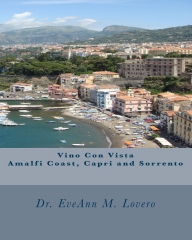
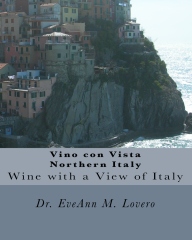
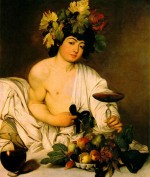

Pingback: Hospice du Rhone 2012: The Biggest Rhone Wine Event on Earth | Vino Con Vista Italy Travel Guides and Events
Pingback: wineandcuisine.net | Source: Montreal Gazette – Wine: Weather, Soil, Tradition Make Burgundy Unique